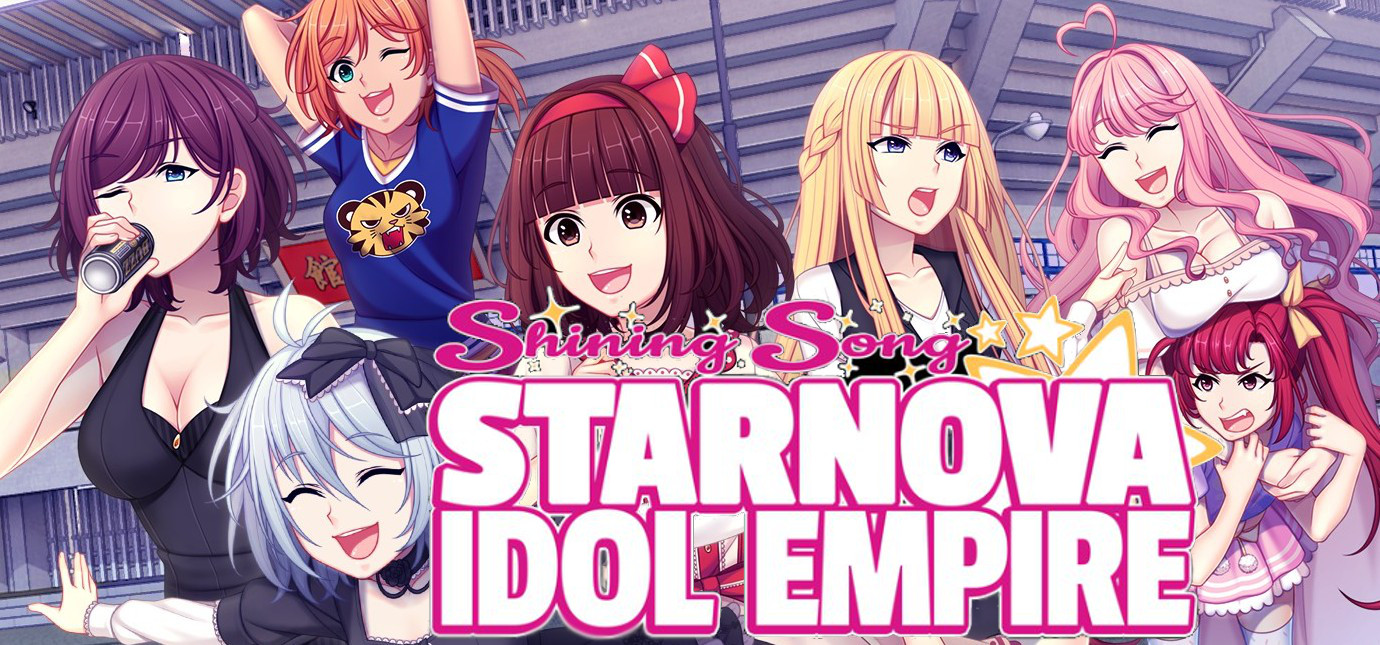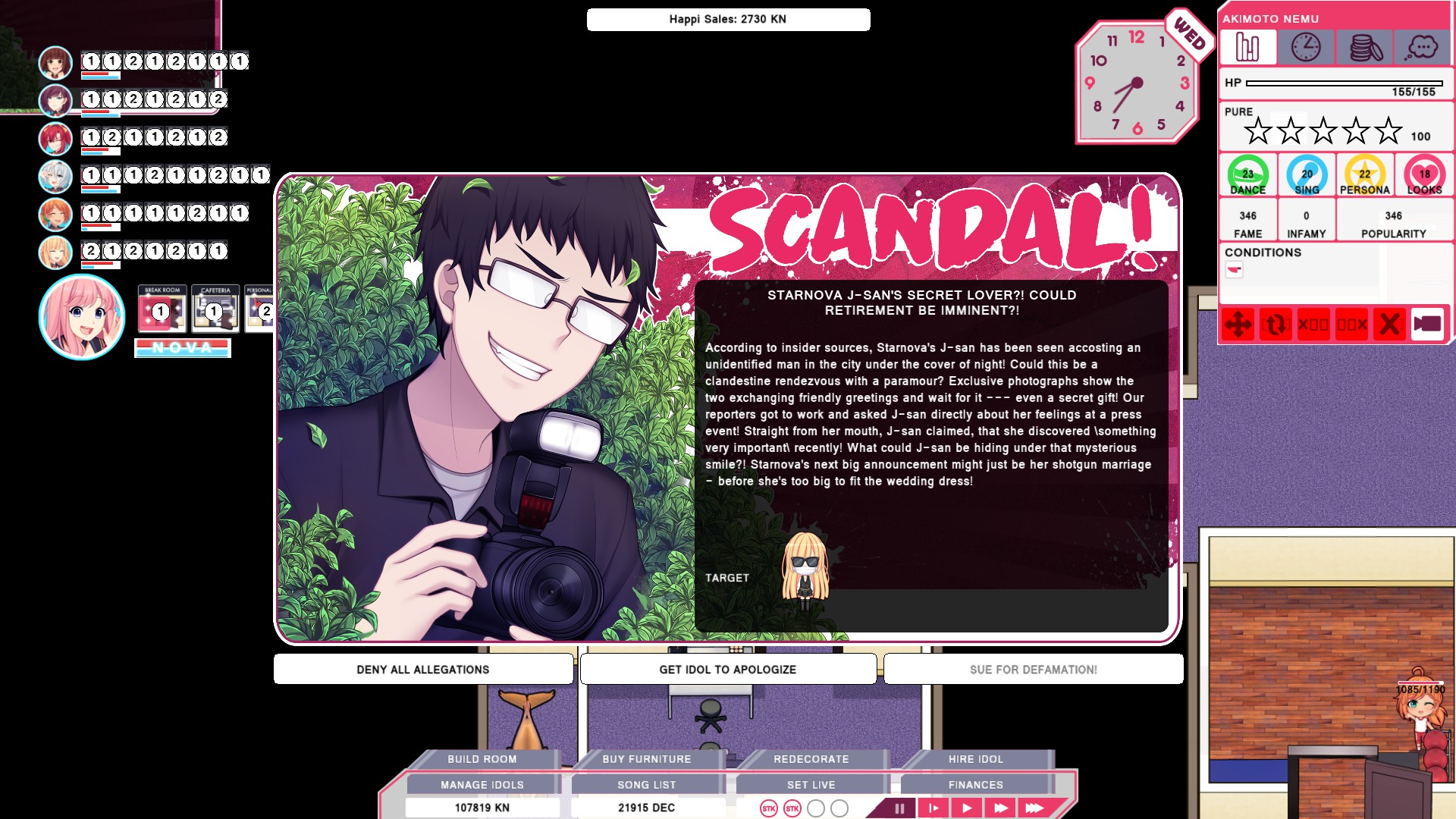Like the idol industry itself, perfectly good talent is being wasted by poor management.
Type: Single-player
Genre: Management, Simulation
Developer: Love in Space
Publisher: Sekai Project
Release date: 20 February, 2020


Intro
Shining Song Starnova: Idol Empire, or, for my sanity, just “Idol Empire” from now on, is essentially an office “tycoon” game with idols from Love in Space’s previous visual novel instead of a video game developer or prison management or whatever. It is a spin-off that breaks continuity from the previous Love in Space game, Shining Song Starnova, which claims to not need any familiarity with the previous game to play it. (Since I didn’t play the last one due to being about idols – more on that later – I should be a good arbiter of that claim.) There is also an additional DLC that adds five of the characters from Sunrider, Love in Space’s other franchise, whose first game was the only game actually about love taking place in space.
User Unfriendly
I normally would never lead off with something like interface before talking about something as basic as what you do in the game with the interface, but this is a special case. The user interface is simply the worst I’ve seen in a game released since the 80s when computer interfaces were still entirely experimental. The design choices for the interface are bafflingly horribly chosen. It’s hard to know where to start, as while most of the basic gameplay concepts follow quite a well-trod path of the genre, it also seems they have never played a computer game before when you look at how the interface was designed. While few of these design decisions actually make the game unplayable on their own (unless you have no scroll wheel), every single choice with regards to interface has something no sane developer would ever put into their interface. I almost have to believe they went out of their way to make the worst possible interface on purpose to punish their players, because it’s hard to believe one could fail in every possible way to make a user interface without doing so deliberately. Surely, a stopped clock would be right at least twice per day, wouldn’t it?
One major inexplicable problem with the interface that leads to a long string of other compromises that makes for even worse design decisions down the road is the fact that the interface has no, let’s call it “mouse opacity”, by which I mean that clicking on a button in the interface also clicks on the map. This leads to several annoying problems in and of itself, for example, clicking on the character portrait to select a character (there are no hotkeys for this) when that location happens to be near the producer’s office on the screen will open up the jobs menu from the producer’s office instead of selecting the character you want. Basically, clicking is a race condition whenever you might have selected more than one thing. Clicking on the “Redecorate” HUD button to close the menu after you have will recarpet whatever room was near the bottom of the screen, costing you money to recarpet the floor to the wrong thing AND an additional cost when you reopen the menu and recarpet it back to what you wanted. However, what’s truly pernicious about this is that because the interface has to be designed with the idea that you can be selecting up to three things at once (a character, a room, and a piece of furniture), each one of those things needs to have entirely separate keys to accomplish the same function.
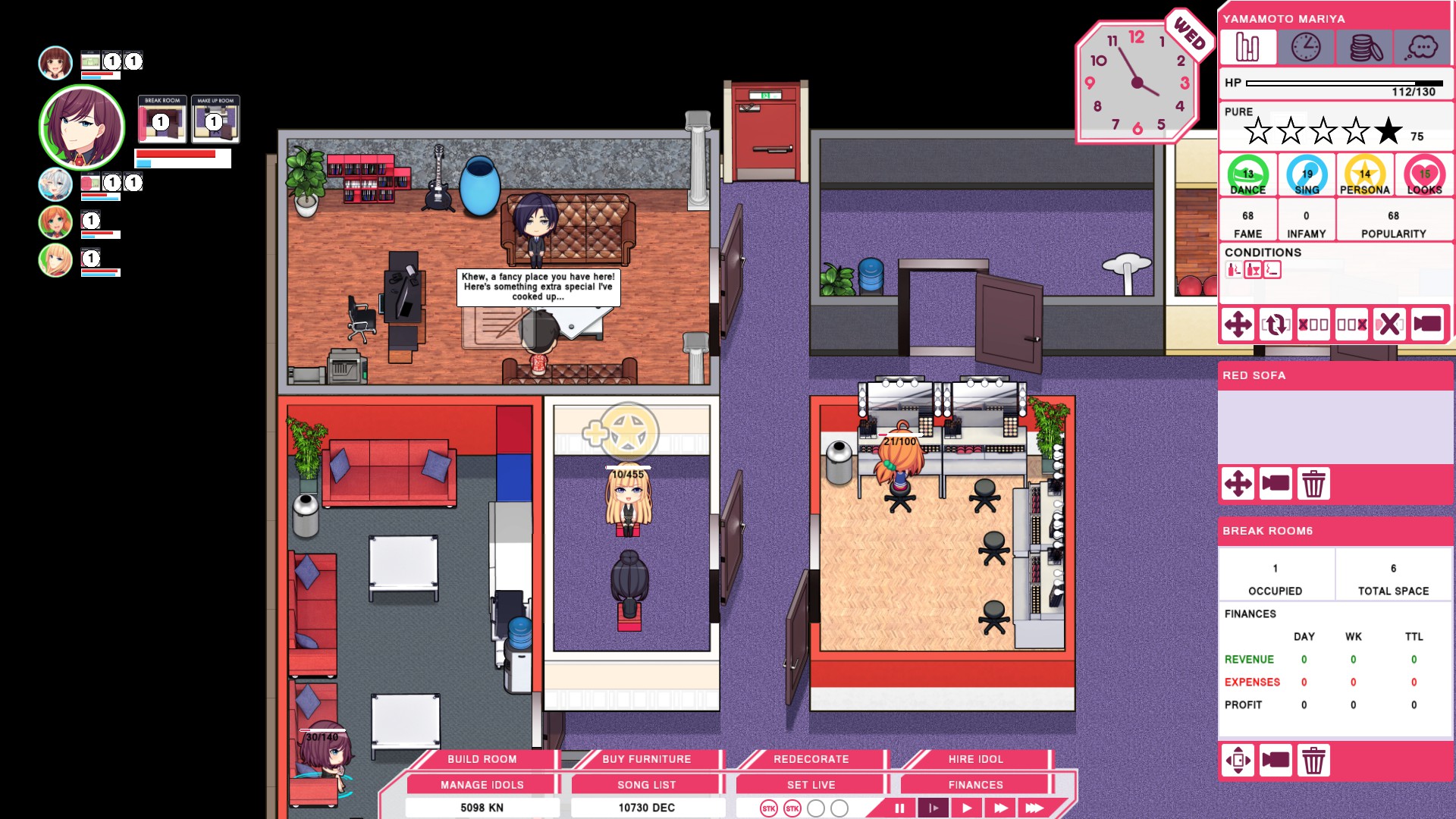
So, for example, moving furniture takes the “M” key. Moving a character, therefore, has to use the “I” key. Why “I”? Because they’re (I)dols. Deleting furniture is “D” because the “Delete” key removes the current action from the queued tasks for a character, while “Backspace” removes the last action on the queue. Why is there an obsession with making what is supposed to be a convenient hotkey so that you don’t have to spend time finding a button with a mouse require you look down on the keyboard to find something well outside the reach of your hand when on the homekeys? Because Love in Space either has never played a game before or just plain hates their players.
Compounding this problem is that there is no custom keybinding. As always, this is inexcusable in a modern PC game, however in this game in particular, the controls are assigned like this was a game made in the 1980s. None of the controls make the slightest bit of ergonomic sense.
As I’ve already mentioned what the “D” key is for, you’ve probably surmised there is no WASD camera control. You need to use the arrow keys or middle mouse click-and-drag, but the click-and-drag goes in the wrong direction. There is scrolling when the mouse is near the edge of the screen, but it is turned off by default, and it’s clear to see why; The zone where scrolling starts covers the entire area for selecting characters, and again, that means you’d be moving the screen to select the character icons when it clicks on the ground or any buttons below them while the camera moves out of your control.
In fact, almost none of the controls are near the home keys, and nearly all of the most-used keys are on the top right of the keyboard. There is no true pause button, but “O” reduces game speed down to pause after being pressed multiple times. Why “O”? Hell if I know.
Perhaps the most egregious choice of controls, however, is the use of the spacebar and enter keys. You see, nearly every aspect of the interface can be done through clicking, as is generally standard and sensible in a manager game that has pausing and no real time pressure on commands. This applies to everything but advancing the text in the story portions.
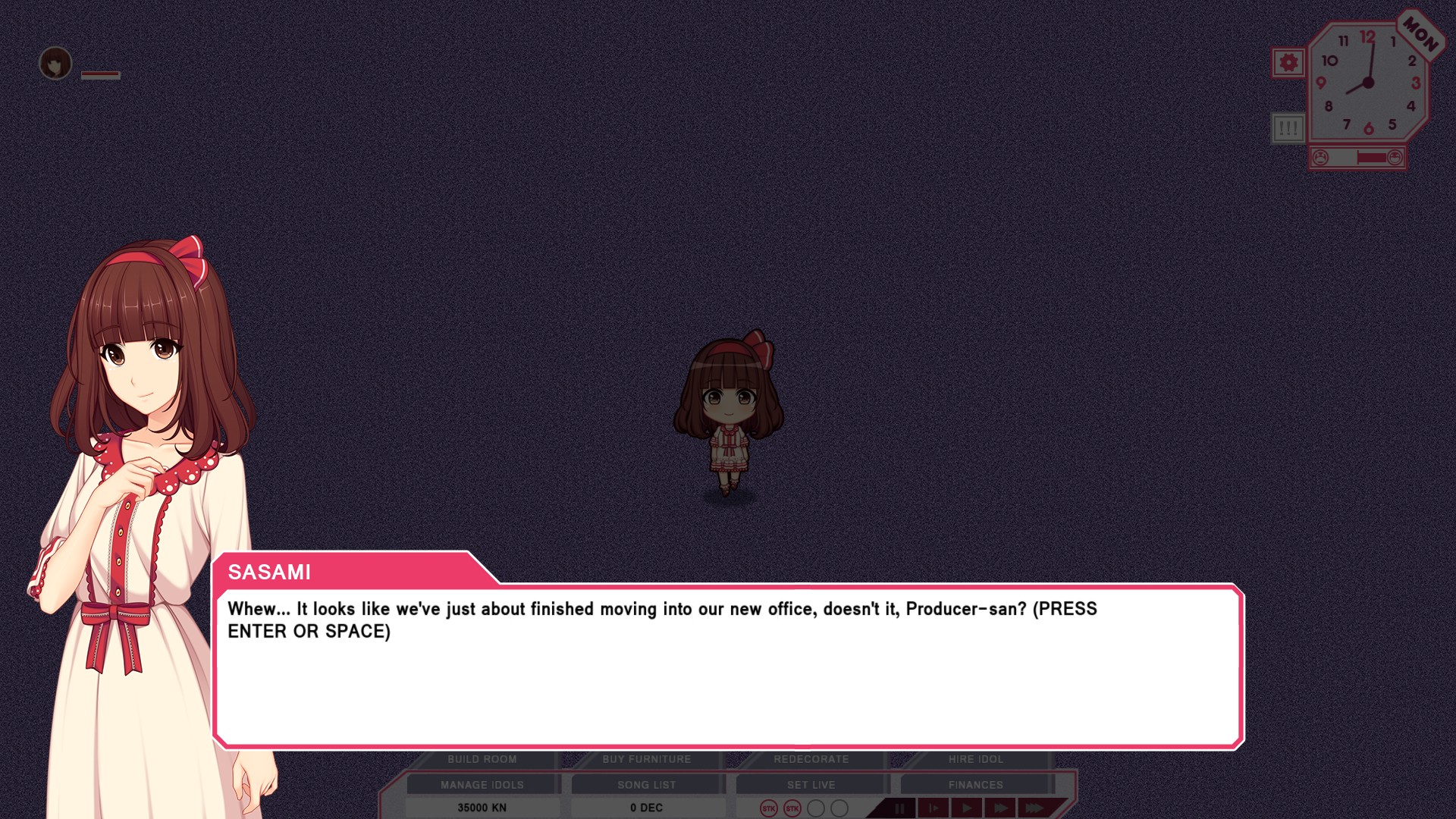
I have never, ever seen interface design idiocy on this scale. The spacebar is the most readily available key on the keyboard, and is therefore best suited to actions that players will need to use frequently, and in a hurry. Most manager games assign pause to the spacebar for this reason. In Idol Empire, it is used only for pop-up text boxes and activating the “Nova” special abilities (something that isn’t taught in-game, and I had to learn from a forum post). I also have absolutely no clue why they wouldn’t just let you click like they make you do for everything else. There’s no benefit to screwing their interface around with these arbitrary exceptions to basic intuitive design.
You can’t even select characters (something you need to do very frequently) via hotkeys. The number keys, the keys you’d expect to try first, are instead used solely to change whether the schedule menu inserts scheduled actions into the front or back of the action queue, which is something specifically designed for you set once per game and then forget. It’d be nice if it was saved between missions so you don’t have to reset it every mission, but otherwise, it’s something ludicrously obscure and underused for such important keys. Meanwhile, you have to either pause the game and click, try to click girls on the move, or click on their icons on the far left of the screen (which will move the screen if you have edge scrolling, and may accidentally select the job offers menu if you happen to be scrolling past it, then hit “I” for “move character” to move them around.
Also, as mentioned earlier, I hope you have a wheel mouse, because there’s no way to zoom out if you don’t have one outside of using macros or something like a Steam controller. The game frequently starts missions zoomed uselessly far in, while the maximum zoom out still isn’t zooming far enough out. Again, it’s basically impossible to control the game without clicking on specific rooms constantly. You have to choose to make a song by clicking on the studio, then select characters and assign them to record by shift-right-clicking the studio. Setting a schedule takes clicking on the specific room, as does changing the schedule, so you need to constantly whip around between rooms. It’s already a problem in the game that you can’t zoom out enough to see enough of your office at once, but if you can’t zoom out at all, the game is just unplayable.
Speaking of mouse controls, there’s another minor issue in that the controls are described in terms of things like “Mouse3” in the interface. If you’ve played other games that have proper control customization, you’ll typically be familiar with the terminology having “Mouse0” as a left clicking and “Mouse1” as right clicking, although sometimes you’ll get an odd “Mouse1” being left clicking. Well, in this one, the interface tells you to hit “Mouse3″… when they mean right click. Yes, it’s apparently “Mouse1” as left clicking, and “Mouse2” as middle clicking, something that is, once again, something I’ve never seen anyone make the mistake of labeling out of order in this way. Isn’t it just lovely when you can’t trust the on-screen instructions, either?
What makes this so terrible is that these aren’t difficult things to fix. Outside of maybe the problem of selecting things through the interface (something I’ve never seen a game do before), this is as simple as a text file, and if Love in Space had just set up custom keybinds like any good developer would do for any PC game no excuses, most of this wouldn’t be a problem.
Another MASSIVE thorn in the side of players is the severe dearth of quality of life features in the game to help take care of mindless busywork clicks.
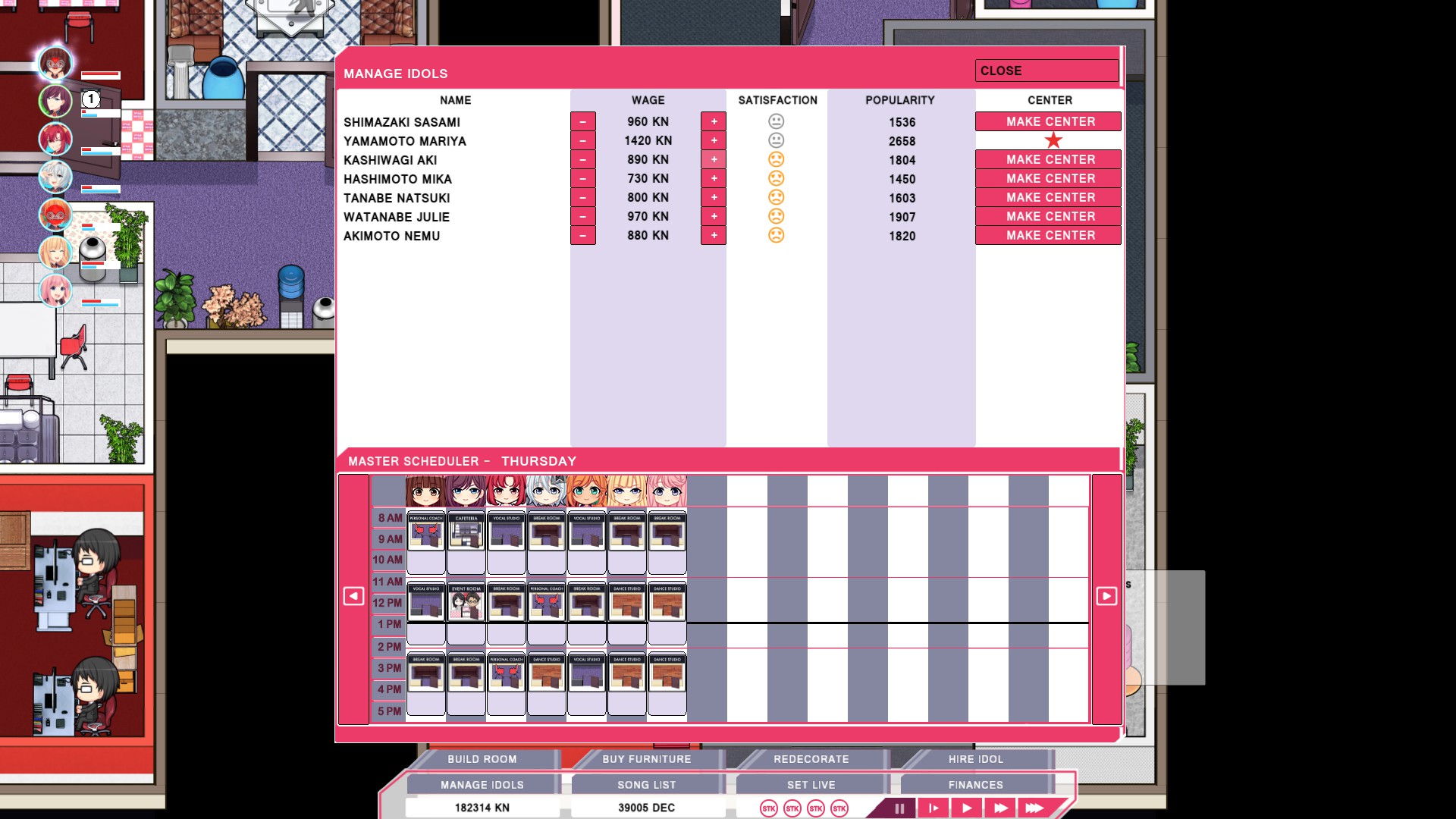
The most severe offender in this regard is the salary system. Girls demand a salary of basically 100 KN (more on that later) + 1/2 their popularity + about 1/20th of what you’re paying the other girls. This also means that giving an idol unhappy with her pay because she just completed a job that raised her fame a raise instantly makes other idols unhappy with their own pay as you’re paying that other girl more. (Apparently, any time they get a raise, the girls will instantly tell the rest on Twitter and cause them to all demand more, as the icons switch immediately to unhappy as you click up the pay.)
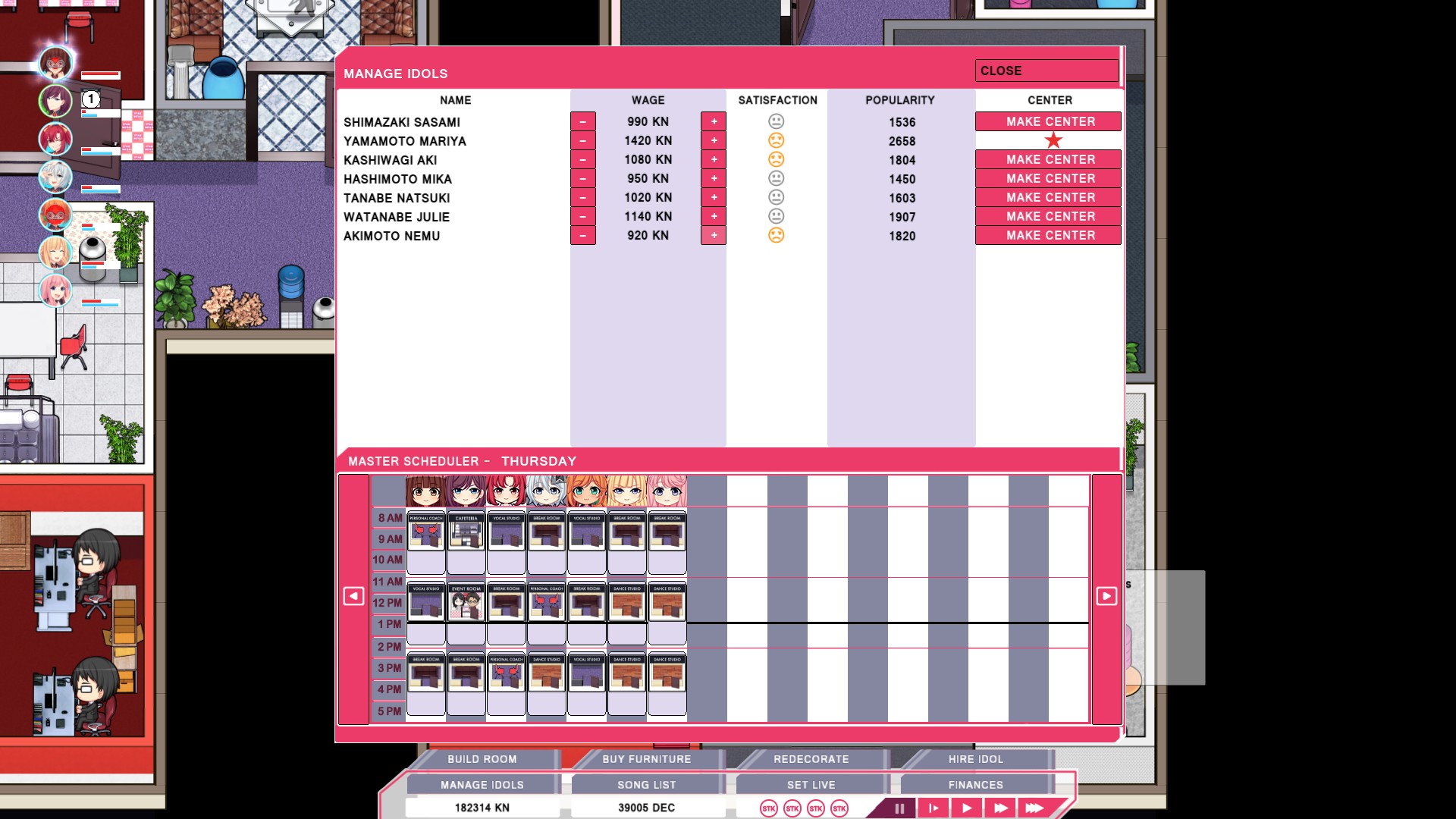
I cannot understate how the popularity of the girls is constantly in flux, putting their expected pay likewise in flux. Essentially every time someone completes a job, you need to go back to the Manage Idols page to give more pay to the girl that completed the job, then more pay to the girls jealous of the girl who just got more pay. Releasing popular songs can passively raise fame for a long time, gradually making them demand more pay without any prompt to go check other than the girls starting to whine about how you must not like them anymore due to how much you’re paying them under the standard. (WHAT standard? I was paying you enough to make you overjoyed I was paying you “above the industry standard” literally yesterday, and that was when I was paying you half as much as I’m paying you now when you’re “below the industry standard”. If the standard is tied to the individual popularity of every idol which is nonsensically objectively measurable in this game, there is no standard.)
Managing pay is just annoying busywork that exists to be a “gotcha” that makes your idols mad if you forget to stop the game every minute to readjust everything, if it exists for any reason at all other than the developer’s management team just not thinking systems through at all beyond simply copying what other tycoon-style games do. There’s no good reason this can’t be automated to a “pay them enough to keep them quiet” button, or even one that keeps them at a certain happiness level. (Paying more than a certain % above the expected income gives a happiness booster.)
While that is the largest headache, other annoying problems include that the scheduler is totally reset every mission. You have to manually re-click the button to add to the back of the queue, and they even made that the number keys for some unfathomable reason when those number keys really needed to be the buttons to select the characters. (I will always punch the same button on the scheduler for every single girl – you have to do it manually for all of them – and forget it, if I bother using scheduler at all.) There’s an “auto” feature that lets girls choose their own training regimen, but they ruin it by making girls not queue up further actions until after they stare at the wallpaper in the hallway for half an hour after completing their last task, and making the girls have preferences based on personality that will make them work themselves to 0 HP and faint. That might be one of the only thematically appropriate things the game adds to make the girls have any real character in gameplay, but it’s kind of wasted when the game makes the function so useless and unreliable nobody in their right mind would turn it on to see its effects.
Another baffling choice I have never seen before is that save files are sorted alphabetically, rather than by timestamp. This means that the most of the first page is naturally taken up by 10 rolling “AutosaveXX” files. Also, you can’t use spaces in your save files, so if you want to punch in “AA Whatever” as a name just to force the save to the front alphabetically, it has to be “aawhatever” as a save name. This isn’t a terribly large burden on the player, but it’s just one more incredibly simple, basic thing everyone else can do right but which Love in Space doesn’t bother to make sane.
There are also many graphical issues with the interface, as well. These aren’t game-breaking, but continue the general trend of making the game harder to play for no good reason. One major issue, for example, is that tasks are shown in a queue next to the character icon on the left side of the screen for any character but one you have currently selected. This would be fine, but there is a number over the middle of the icon for the task being performed that completely blocks the icon for what the character is doing, rendering the whole interface element basically incapable of conveying the information it was designed to convey.
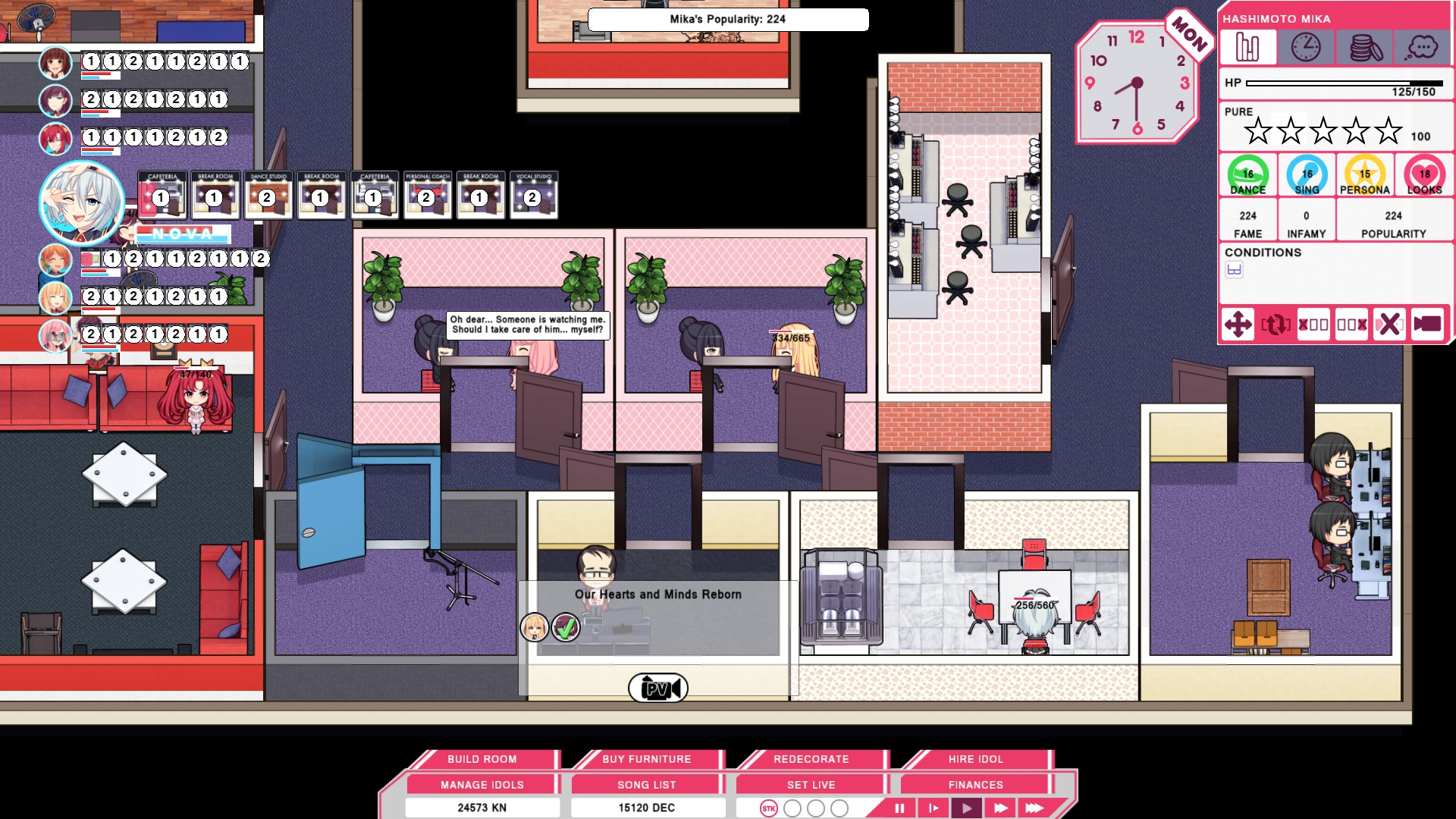
Worse still, you wouldn’t even be able to make out the icon if they weren’t inexplicably obscured by the number of times you queued that task in a row, because the developer didn’t bother to make an icon that would be intelligible when scaled down to the size they make the icon. Make no mistake, they have icons that are simple, color-coded, and easy to recognize in the character stats menu, but they choose to use room icons that are unintelligible at the scale they are presented, anyway.
They also manage to make basically every bar in the game besides the nova charge bar red. The character’s HP is a red bar near the character portrait (or a white bar in the character menu). The character’s progress on a task is a red bar filling up the task in the task queue (but only when selected or on a job that doesn’t have that stupid number queued circle I talked about above obscuring the action they are taking) and a bar that fills up above their head only when performing break room, makeup tasks, or other tasks that do not train stats. (Also, the task queue progress bar when performing makeup lies to you, because you complete the task when it fills up only halfway.) There is also a stat experience bar that fills up above the heads of characters on training tasks that is visually identical to the task progress bars, even though it has nothing to do with what point a character will stop performing that task. Basically, completely identical red bars mean entirely different things depending upon which room they happen to be in at the time, even though there’s absolutely no reason not to just make some of the bars any color, any color at all other than red!
This problem is brought to the point of near self-parody on the concert stages, where the HP is displayed as a red bar over a white background that visually loses that red bar and fills with white as HP/stamina is lost. As a visual queue, that would mean seeing lots of white would be a bad thing, right? Well, Love in Space thought it would be a great idea to make the bar background turn yellow (so it’s a red bar on a yellow background) when HP is below half, and have a red background the exact same color as the health bar so that the bar itself is utterly indistinguishable from the background and it is basically unreadable. It’s worth pointing out that during concerts is when you are being forced to make decisions under the tightest time constraints and most pressure, and they deliberately obfuscate your interface for no reason
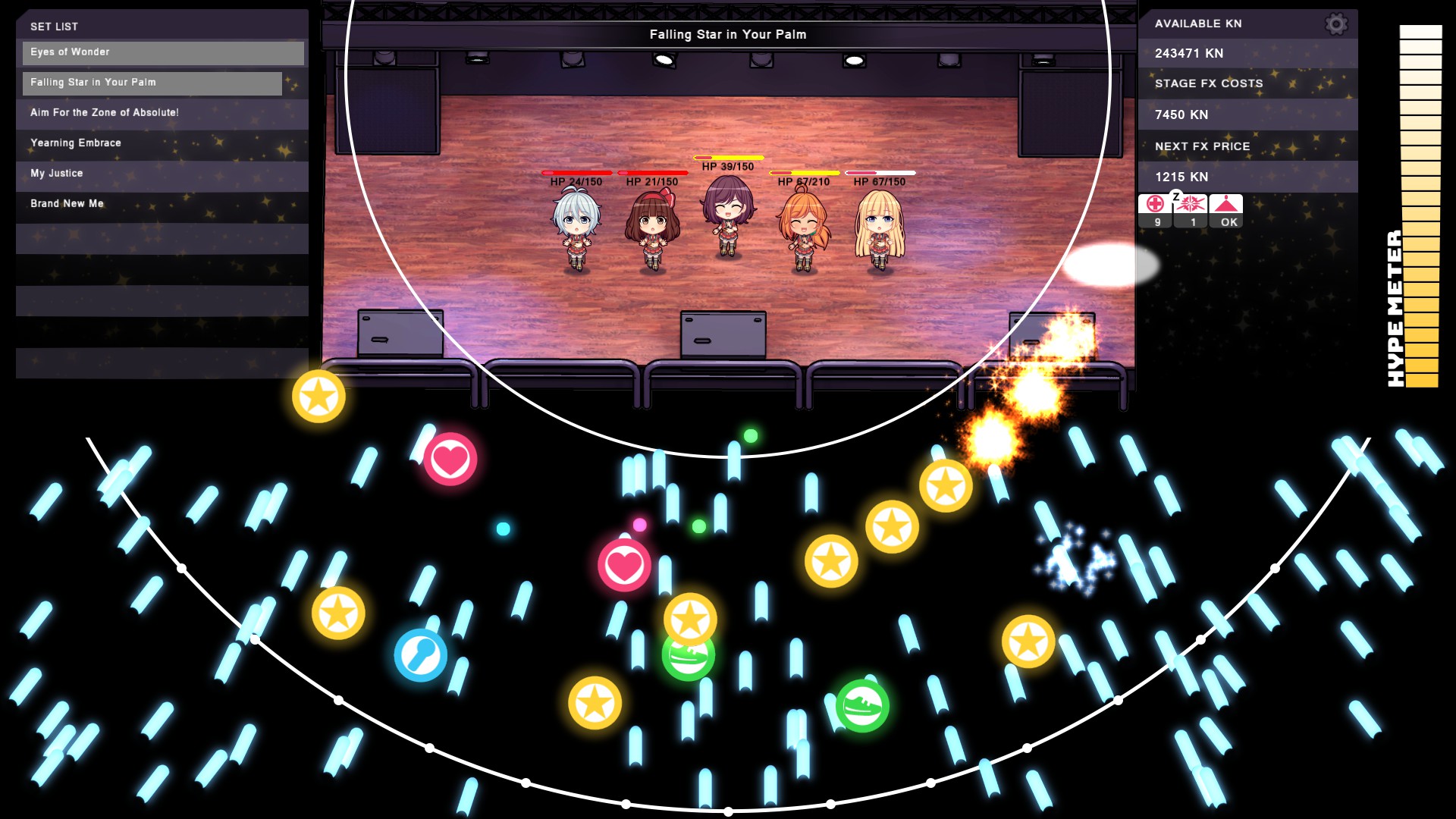
There are few things that really break the game all on their own, but it’s just astonishing that every little thing that might possibly go wrong – even things that nobody else has ever gotten wrong – manages to have at least one small thing that makes the game worse for the player. I can’t seem to list them all, I just keep coming back to this section to add more things as writing more makes me remember more and more of them.
There are actual classes taught as college-level courses that just cover interface design. If any professor of such a class saw this game, they would beat this developer to death with their textbook. Many of these problems aren’t things that can be done on accident, they have to be deliberately set up to be as user-unfriendly as possible, and in some cases are done in ways that meant extra effort was taken to make the game worse for the player.
UPDATE: As of March 19th, Love in Space added patch 1.1.1.0, which added keybind customization, directly allaying many of the controls issues listed above. I wish we were still in a time when custom keybinds on PC were just standard without having to fight for them, but I still do want to applaud taking such a clear step in the right direction.
What’s an Idol?
Everything about this game’s story, mechanics, and theme all revolve around the idol industry totally endemic to Japan, as well as some tropes of its anime interpretations. As such, for the maybe three of you who for whatever reason don’t know what they are but will read a review about a game based on them, strap yourselves in, this won’t be pretty.
There are three key things to understanding the basic underpinnings of the idol industry:
First is the concept of Parasocial Relationships, or the way in which people can feel as though they have relationships to people they see in media like television (or games), despite not interacting with them personally, and even when they are obviously fictional characters. (Considering as this is a fundamental necessity for feeling empathy for fictional characters, and therefore caring about their stories, it’s also basic for any sort of game’s story having emotional impact.) Idols exist in a kayfabe where they market their stage personas. This may not seem so different from other entertainment figures, as someone like Taylor Swift will constantly massage their own brand image from album to album, but idols have an absolutely unrealistic image to maintain. They need to show a “pure” image that would make a Mouseketeer look like a gangster, while also being constantly sexualized and marketed as a potential girlfriend to lonely men. The kayfabe story that the idol will give is that she just wants her fans to be happy and inspired, or at best, that she wants to get to center stage and do her best as an idol.
The second is the ludicrously exploitative capitalism of Japan, which I remember most directly parodied in an old Penny Arcade side character, The Merch. The idol industry doesn’t make money by selling music or even by selling concert tickets (especially in this game), but by selling the idea that the only way to be a “TRUE FAN” is to buy more merch. You can only help that poor idol who’s only doing her best by buying all her albums multiple times. Even if the idol is part of a group who’s already at the top of the charts, they’ll set up a voting system based upon how many copies you buy of their new album that determines the fate of each individual idol in a competition against her own team. It’s every “TRUE FAN”‘s duty to vote for their idol multiple times, and the only way to do that is to buy the album as many times as your wallet holds out.
The third is that idols are sex workers who do softcore porn shoots called “gravure” whose “TRUE FANS” will become absolutely outraged whenever it becomes hard to keep up the kayfabe that they are not sex workers because the kayfabe requires that they be entirely Pure and virginal. At the same time, they will become outraged if their totally Pure and virginal idols are not showing off enough of the goods, because that’s what they’re paying for, after all!
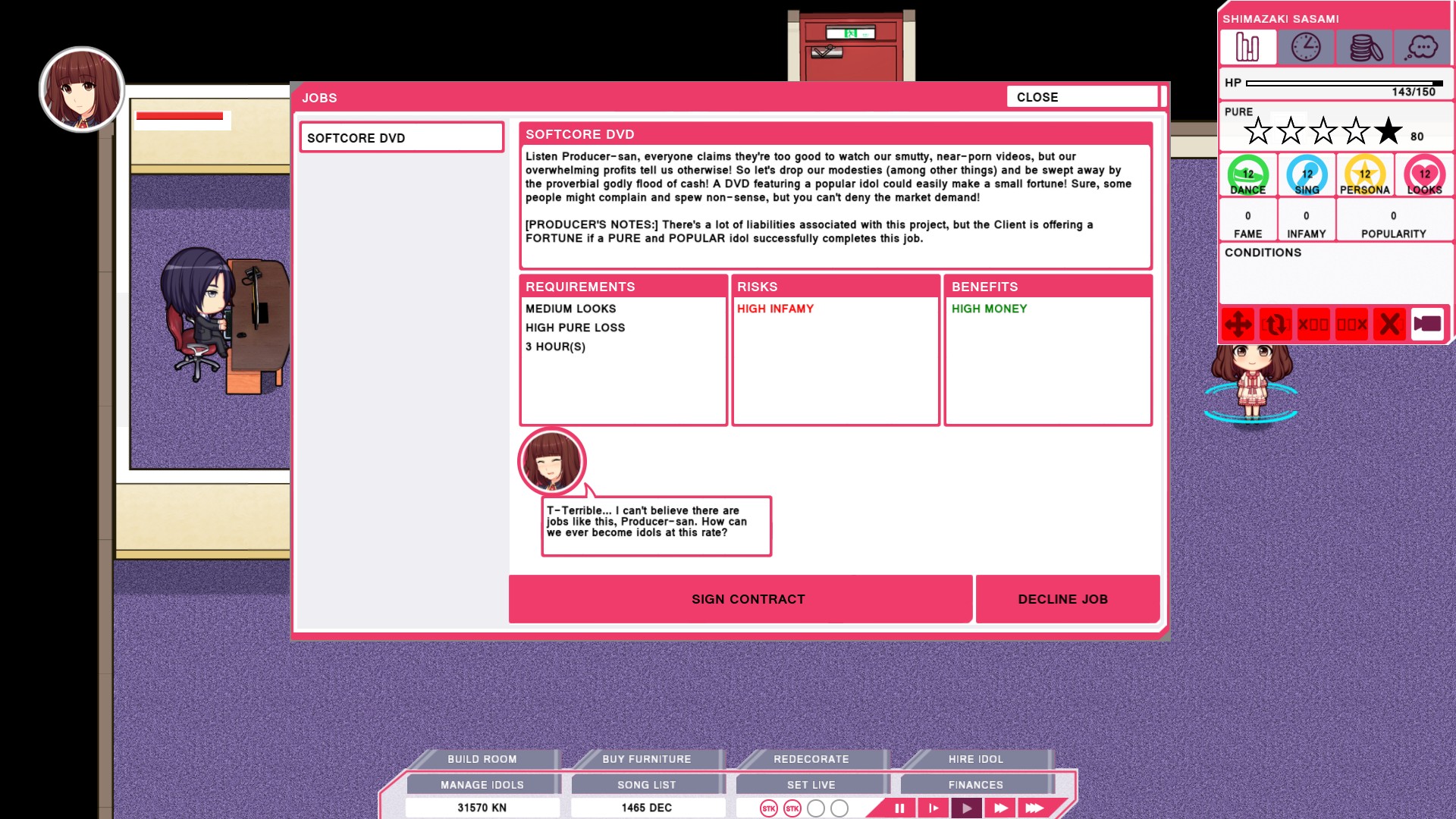
It is because of this that an idol is contractually obligated to never have a boyfriend, on pain of public humiliation and demotion by her own producer. In spite of the fact that having no say in who one is allowed to love is basically one of the go-to default ways to describe your setting as a nightmare dystopia, the simple act of having a boyfriend that isn’t literally every fan that has bought her record inherently devalues the commodity of the kayfabe that idols are selling that it is a “scandal” whenever idols show human emotion off-script.
As an additional perverse twist, idols are sometimes pushed to perform acts that tease lesbianism like kissing one another in commercials regardless of their own sexual orientation because hey, TRUE FANS are only upset when another man might be their waifu’s boyfriend so gay stuff doesn’t count. Therefore, ordering straight women to kiss on camera can hint at sexuality without harming the “purity” of the commodity in question, right?
The sheer level of perverse objectification in this system is perhaps best described in this recent video essay, on whether the concept of consent can exist in a product, and how that applies to someone forced by their job into behaviors against their will:
… So in basic terms, the idol industry is a thoroughly dehumanizing industry that packages and sells young women without their consent to middle-aged men who pay extra to legally be allowed to touch the often-underaged girls after the show.
While I’m speaking directly to the problems with the fans of the idols, however, this is ultimately not the fans or the idol’s fault, it is the fault of the industry, and the ones who truly profit from it, the producers and executives. Not unlike the tobacco industry, while some blame may be placed upon the victims for partaking, the ultimate responsibility lies with the ones who built a system explicitly to profit upon the suffering of others.
The idol industry may be the ridiculous ass end of otaku culture to the point that even the guys who buy naked cartoon girl pillows point and laugh at idol fans, and the fans absolutely engage in bizarre and disturbing behavior, but the idol industry cannot exist without people behaving like this, so they deliberately push people straight to the edge of insanity.
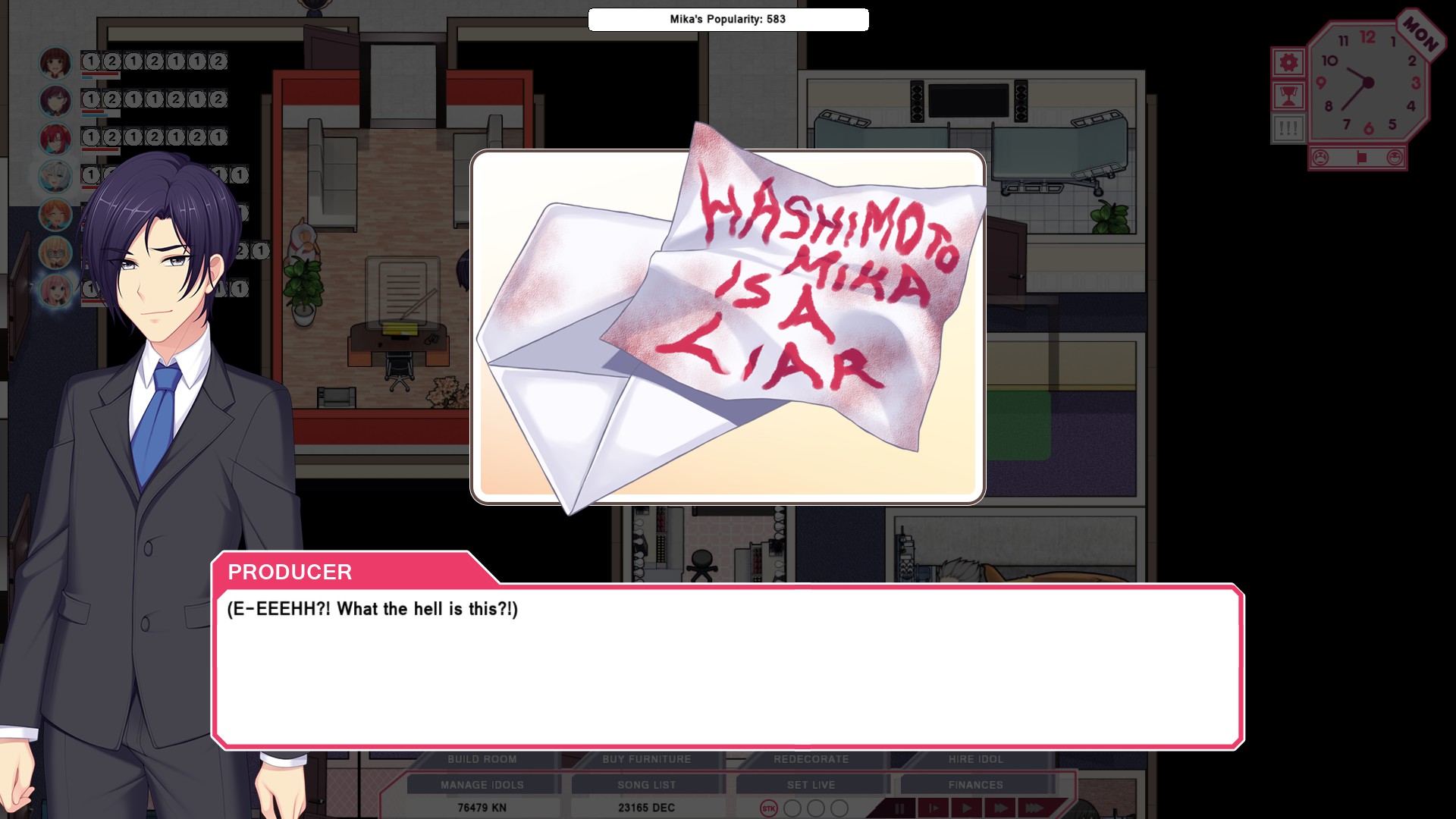
They can’t have their TRUE FAN cows actually getting real girlfriends, or they won’t spend all their money buying the same CD multiple times, so they have to spread the notion that only a perfect virgin with no opinions about anything is PURE enough to be a good girlfriend. Likewise, if you’ve gotten someone so utterly emotionally invested in a fantasy girl that they’re willing to blow their life savings buying her kayfabe persona’s merch, then it’s pretty obvious that they’re also going to be so emotionally invested that seeing that fantasy girl put in an advertisement they don’t approve of would trigger death threats over social media. The entire system the industry is built upon is building these people up to an absolutely unsustainable emotional dependency upon something that can never possibly be delivered. The violent attacks by the NOT TRUE FANS are the inevitable result of an industry that pushes the TRUE FANS to their absolute breaking point to squeeze every dime out of them before they break. Why shouldn’t they? If the fan breaks and becomes a NOT TRUE FAN that attempts to attempt to murder an idol, the idol is an easily-replaceable commodity – AKB48 is a constant revolving door of idols. The blame will go to the NOT TRUE FAN for being NOT A TRUE FAN, or else to the easily-replaceable idol who failed her TRUE FANS by not living up to the impossible kayfabe.
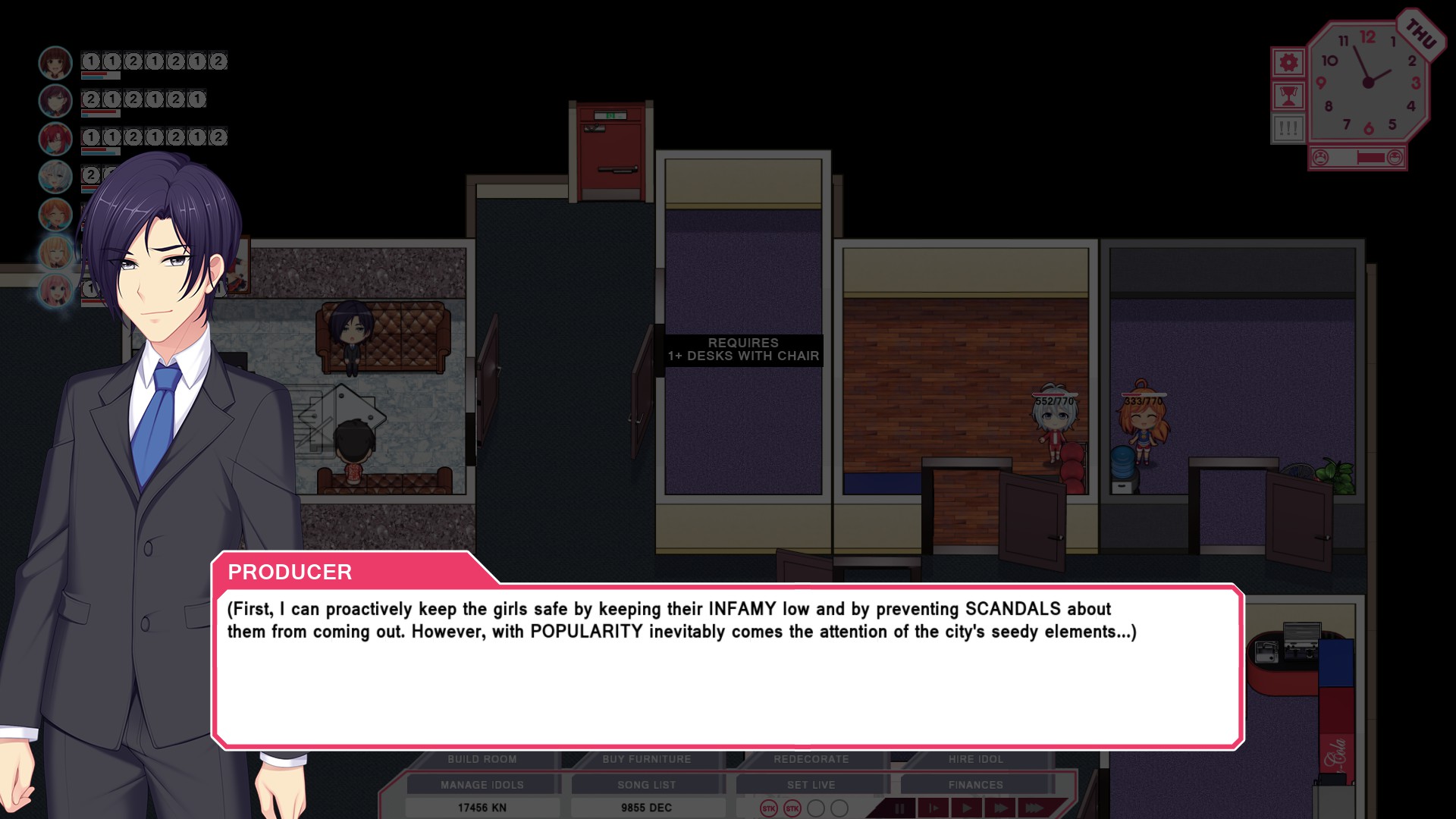
They’re all a series of bad apples. There is no systemic problem, just a constant stream of bad individuals who seem to always keep popping up specifically in relation to this one industry at a regular rate. All we need to do is stop people from ever being bad apples to solve the problem!
The idol industry in other media
Now then, if you see anything about the idol industry, it will be presented in one of two ways.
If the reference to the idol industry is made by someone not related to the idol industry, it will basically always be a reference to some scandal or the sheer absurdity of the idol industry as a whole. As mentioned above, there’s plenty of material for making light of the sheer farcical scam nature of the idol industry and its TRUE FANS’ obsessions, or the raw money-grubbing nature of the industry. A good full-length example of this kind of piss-take on the idol industry is Backstreet Girls, a story about three yakuza thugs whose boss forced them into a sex change so he could market them as idol singers where they then are subject to, among other things, sexual harassment by other yakuza members who don’t recognize them and physical violence by their producer/yakuza don after they constantly drink to avoid the reality of what their lives have become. Needless to say, it’s not a glamorous take on the industry.
The other type of idol media is one that is made by or to glamorize the notion of idols, such as Idolm@aster or Love Live, or even somewhat subversive takes on the genre, like Zombieland Saga.
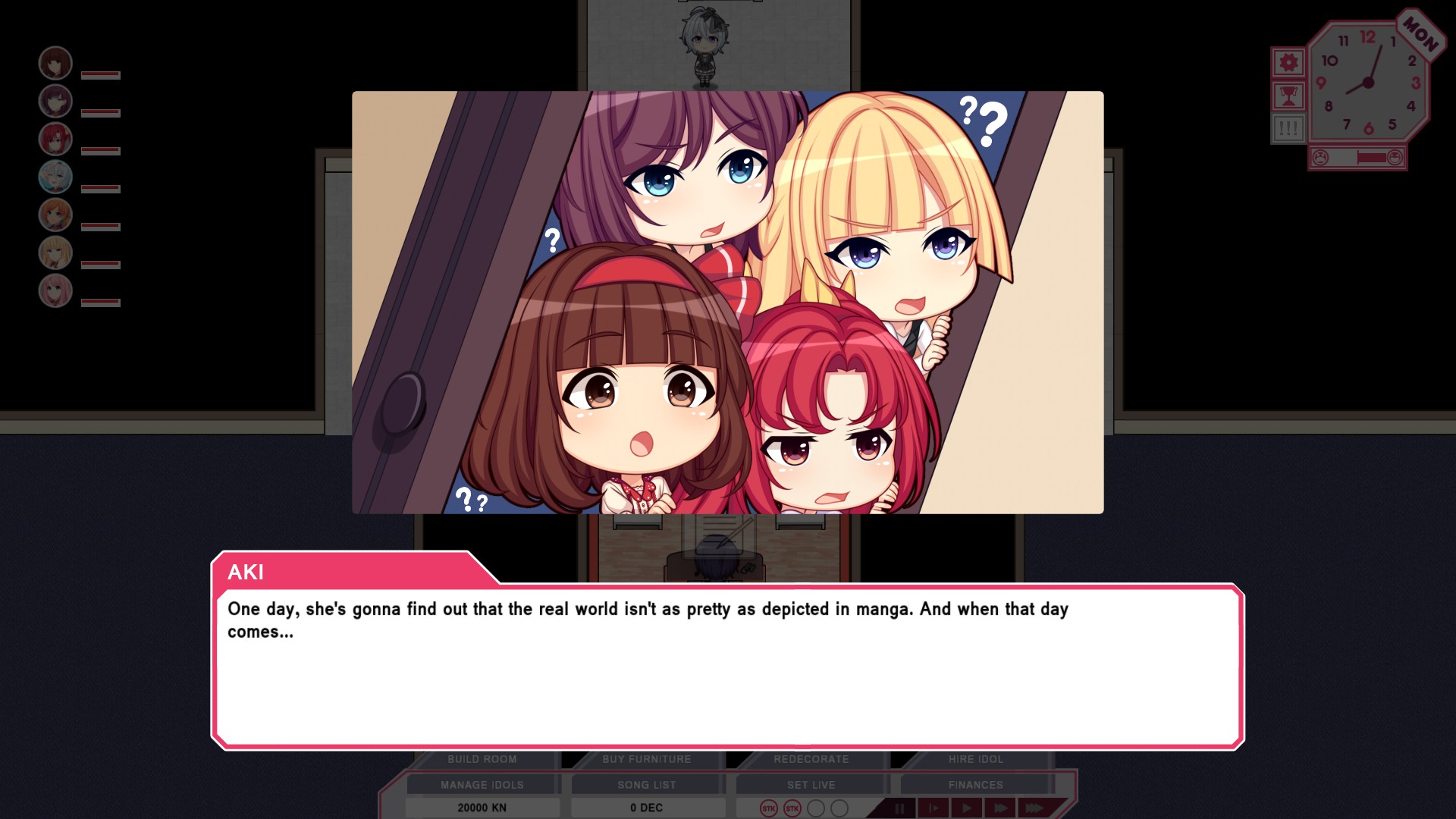
These types of stories try to generally be something like a sports team drama, where they’re a team of underdog girls who want to win some sort of championship or save their school from being closed down by raising money as singers or something. The fans and all the merch and events done to milk them of every yen they own will basically never be mentioned except as one or two recurring extras that keep showing up in the crowd. This will never be a story that will acknowledge the actual nature of the idol industry, because that would never make good television, so instead it’s all about learning teamwork or whatever so that the girls learn to “do their best” to achieve something wholesome… like becoming really famous or getting to be at the center of their idol group’s formation (please buy multiple CDs to vote for her multiple times)!
Basically, if you’re going to make an inspiring drama about idols, you essentially have to pretend everything about the actual idol industry doesn’t exist.
Basic Storytelling
The fundamental problem with the writing for Idol Empire (and reading previous reviews, apparently the previous Starnova, as well) is that the writer seems to understand the general pace and what story beats a story is supposed to have, but doesn’t understand how to write details that actually support the message he’s trying to convey.
A good example of this is how badly the game’s story mode fails to set any real stakes, which starts around Mission 2.
Sports or other civil competition-based stories tend to have a problem creating villains and having serious stakes; Whereas an action blockbuster can have a villain threatening the world or the galaxy that ends in a big punchup, or a murder mystery can have a victim that was villainous and sympathetic culprits but still rely upon viewers desiring justice to be done, a story about a Little League baseball team has trouble setting up real stakes. It’s kind of gauche to set up a few children who play baseball that just happen to be from another town as some sort of evil monster that can only be vanquished with the power of scoring slightly higher than them in a sports match, and you have to give viewers a reason to care about winning one specific game when teams in real life can just try again next year. This is why you tend to see some community center that will be foreclosed unless the cast raises $10,000 in a week, and there just happens to be a dance competition or talent show or baseball championship or something with a $10,000 prize that week. Likewise, if you have a Little League team, having the big bad rival be filled with kids that failed first grade several times so they’re much larger and tougher both feels like cheating (making them somewhat villainous), and makes them have a credible reason to make the heroes the underdogs (so that they can overcome the long odds rather than win a game they should have won from the start).
Here’s how this is handled in Idol Empire:
Starnova sells its old business office and buys a new one for no reason while losing all their training progress because everything resets between missions. Everyone from Starnova walks into the office saying how evil Quasar’s people are. Quasar’s people walk in and gloat about how Starnova hasn’t set up the furniture yet and have 0 popularity. They then say that there’s a popularity contest that will take place at an indeterminate future date, and they want their idol group to win the good idol group contest because of course they do, so does every idol group.
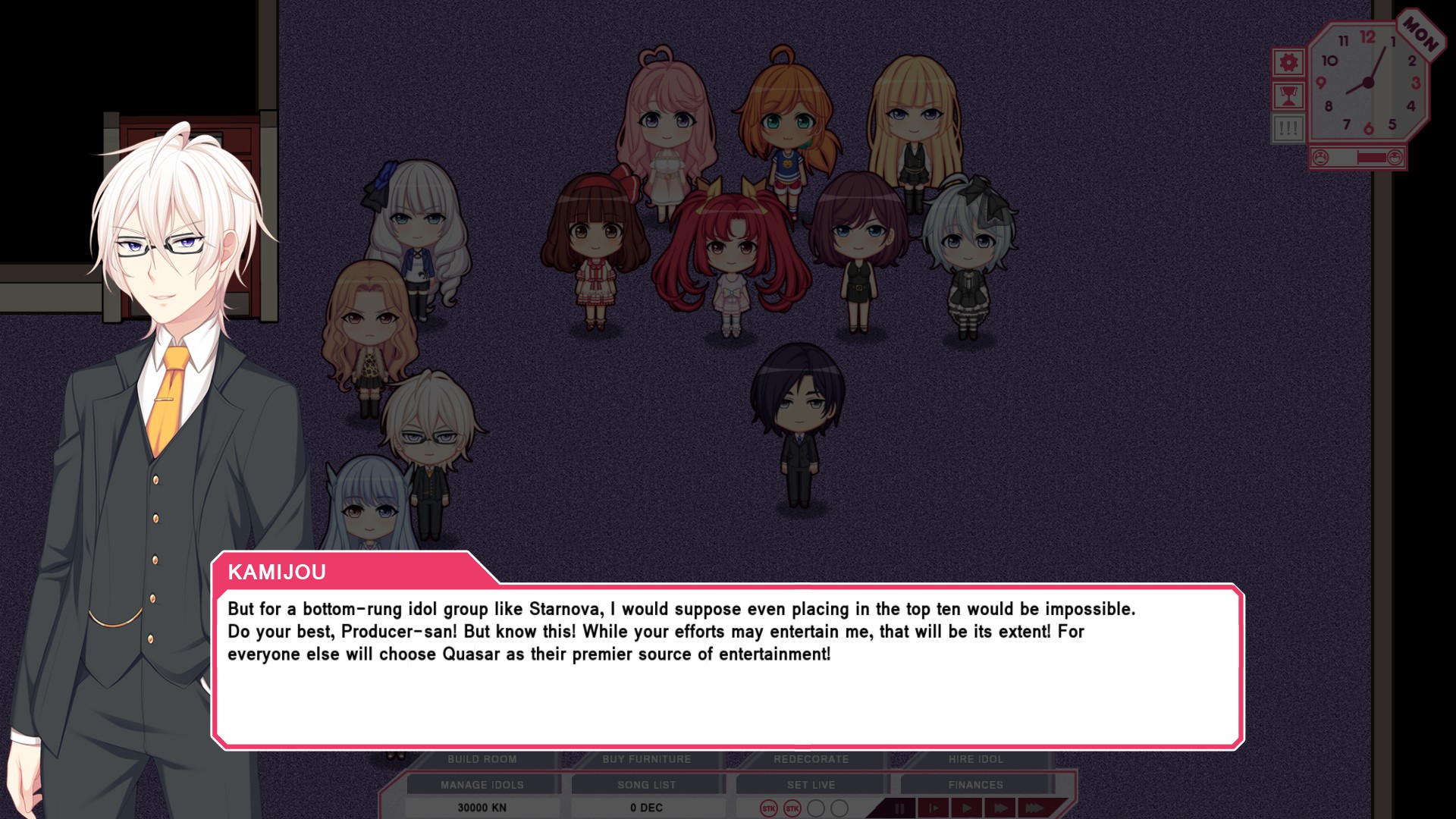
The Starnova gang responds to this like he was Lex Luthor unveiling his plans to conquer Metropolis.
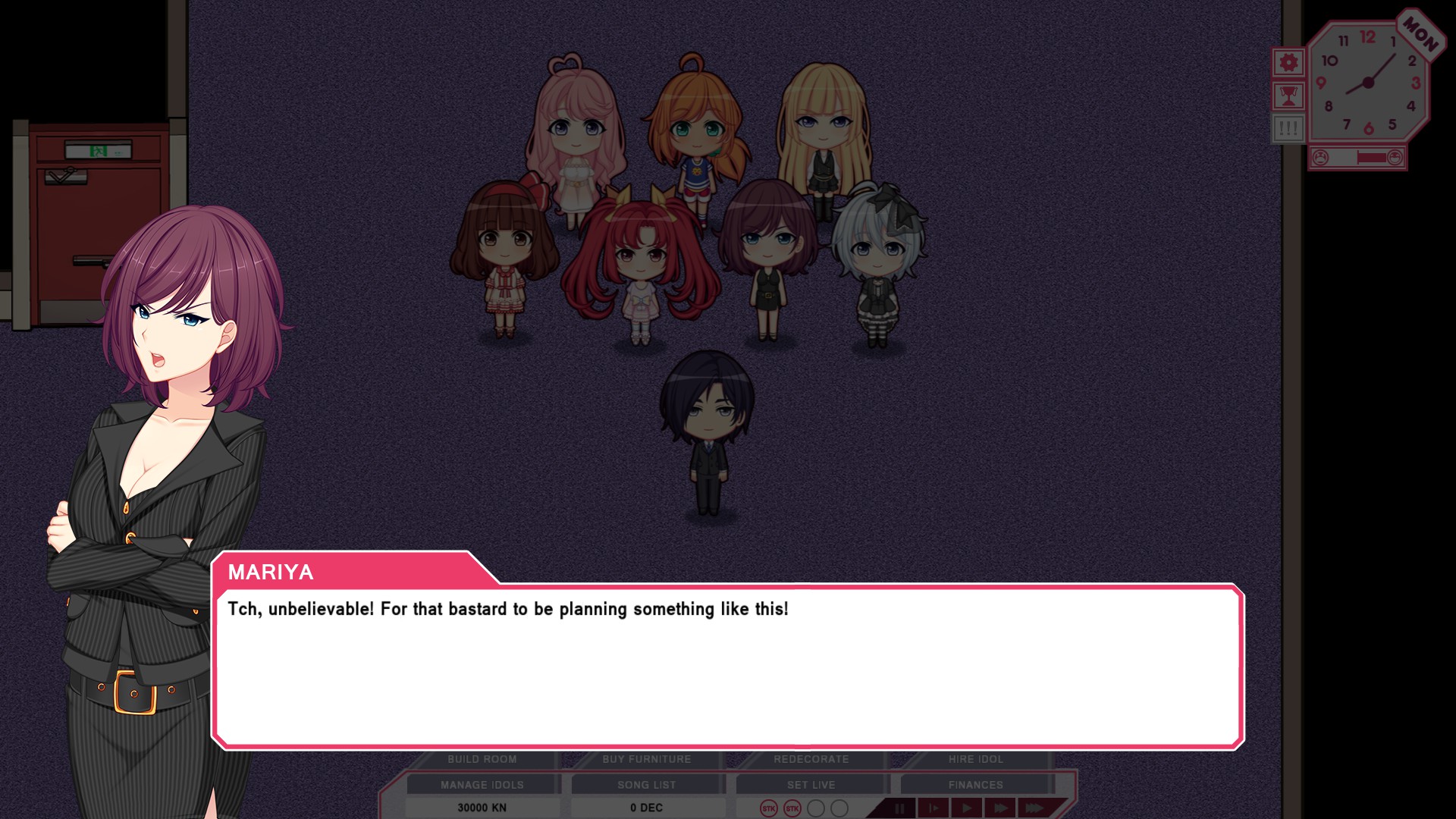
There are absolutely no stakes to this. The worst thing that will happen, aside from not being quite as famous as they could be (and nobody really lists becoming really famous as a motivation except maybe Aki, as it’s not really a heroic or inspiring motivation), is that Quasar might come back and gloat some more. There’s zero reason they can’t just lose this one arbitrary competition with no stated prize besides bragging rights and win the next one. The members of Quasar are also basically framed as being mean girls bullying Starnova, but only one girl (the one you don’t get to recruit later) really says anything hostile, although Shiro comes off condescending.
The only thing that actually threatens Starnova is running out of money, which is basically never addressed in the story at all. There are arbitrary missions objectives, but for the most part, the story has nothing to do with the actual mechanics of the game. Quasar essentially only matters in one mode where you have to compete against them, which isn’t the story mode. Quasar doesn’t even exist in the majority of the story missions. In fact, they don’t even reappear at the end of that mission – you just have a concert and go to the next mission, which doesn’t mention the supposed competition at all, when missions tend to be self-contained episodic plots. (Natsuki’s alpaca happis exist only in one specific mission and are never mentioned again, for example. The mission plots presumably relate to the branching story arcs of the original game, so they basically exist as a series of different continuities Frankensteined together for this one plot, which again makes the disappearance of the “villains” after “starting the plot” by doing nothing even more of a problem, since they needed to close off that event in that “episode”, but Love in Space seems to have just plain forgotten it was supposed to have a plot.)
But on a more holistic note, this “story arc” is the perfect microcosm of Love in Space’s writing in this game: It requires you to have watched other anime, seen other shows, and played other games to understand how the plot it is aping is supposed to work for you to follow it at all. You all recognize the scene where the rivals burst in and act villainous so that they can get their comeuppance later from other, better stories, so they throw down the basic story beat of that happening without really bothering to make any of the actual things said in the story support what they were going for. Quasar is basically just the bad guys because they happen to wear black, have blue-tinted shading to look less natural, and have squintier eyes, but the writer totally forgot to give them a motive or plan to enact or presence in the plot.
This is the inciting incident, the big dramatic thing that pushes the heroes to action and makes them face their destiny… and the “heroes” forget the “villains” exist a minute later because they saw something shiny. It’s like if Luke Skywalker came back to Uncle Ben’s moisture farm and saw that Darth Vader had left a note on the door saying that if he had any information on where the missing droids were to please contact the nearest Stormtrooper garrison before getting on his star destroyer and leaving Luke to continue being a moisture farmer for the rest of the movie. For a developer that primarily writes visual novels, which the lead writer brags about having extreme word counts (not quality, word counts) over that of the entire Lord of the Rings trilogy, this is a staggering failure of basic storycrafting.
Newcomer friendliness
Coming into the Starnova franchise at this point feels mostly like coming into a television show starting at the second season. The first mission basically gives a three-sentence introduction to the major characters before the second mission laughably fails to introduce the so-called-villains (and Kaori doesn’t even speak or get acknowledged as there). There is basically one sentence to say why Shining Productions is in the situation it is in, and you basically have to read the store page of both this game and the previous game to get a basic understanding of the situation the characters are supposed to be in. They say that “Golden Calf Productions” is responsible for “tricking” Shining Productions (which is apparently also Starnova) into needing new offices… somehow. Who are Golden Calf Productions? Who knows! It’s not explained in the story, and they don’t apparently matter except as a way of explaining why you randomly change offices the first time you change them. Is there any real excuse for why a game’s story can’t be contained in the game’s story, and you have to go reading outside sources to find it?
Really, while you technically can catch up just by inferring the set up from what characters do and how they treat each other, for a game that the developer proudly announced you did not need to play the previous game to play this one, it feels like no effort was particularly taken to make that true.
A Poor Judge of Character
In stories written by western writers trying to mimic anime style, there’s always been a tendency to rely far too much upon people just being excited to see the tropes of “real animes” and assuming it would be enough to make you like a character that is really nothing more than a reference to a character you recognize from a better story someone else made.
This has always been a problem for Love in Space’s ability to write characters. Sunrider, the first Love in Space game, had some decent ideas for a setting, but a lot of the visual novel romance elements start to fall apart when one of the major characters is a naked proxy for the iconic Neon Genesis Evangelion’s Asuka Souryuu Langely not-so-creatively named Asaga who has a similar haircut and wears an identical plugsuit to Asuka. However, while Asuka was a complex character, Asaga was a cringy moron who constantly spouted memes like shouting “IMMA FAHRIN MUH LAYSAHS” every time she attacked. A character like that simply makes it impossible for you to take any of the drama seriously, much less romance, and it’s hard to ignore when she’s basically the default love interest who gets the most screentime.
Tropes are tools, and just because a character embodies a trope doesn’t make them a bad character, but if you fail to do anything to differentiate one character from every other character that embodies that trope, you’ve created a boring cliche of a character.
So then, you can basically divide up the original Starnova cast into three sets of characters. (I won’t go into the rest because this is already going overlong.)
The first set are the “low Pure” characters who are veterans of the idol industry or sex working, who actually recognize the idol industry for what it really is, and talk about its many flaws, including Mariya, Julie, and Aki.
Aki in particular deserves special mention for charcterization, since she’s basically a subversion of the “token loli” character that plagues anime in general. She takes up the role of the insipid “not blood-related little sister” character, but does so purely sarcastically because (due almost certainly entirely to the fact that the original Starnova game was a porn visual novel, and therefore needed to definitively state all its characters were 18 or older) she’s “better than other 12-year-olds because she has seven years more experience”. She’s a former child actress that is putting on her underaged routine in spite of being older than some of the other girls. The fact that she’s basically repeating all the typical tropes of the loli character, but as a way of mocking the sort of guy who goes for the loli characters, makes her stand out in stark relief against all the actual anime characters that constantly play this trope straight, since the lolicon is a core demographic of harem animes, and they have to be pandered to.
Julie, meanwhile, is the most “low pure” girl, and her intro line on the original Starnova game references her willingness to switch to actual porn if being an idol doesn’t work out since… well, there’s not much difference, now is there? This, however, gets her constantly slut-shamed in the game, even though most of the text basically agrees with her judgement. Her lines when selecting tasks are heavily cringy references to cliches about tsunderes, but whether this is a joke like Aki’s or not is… unclear. In-game, she’s also the prime target for scandals.
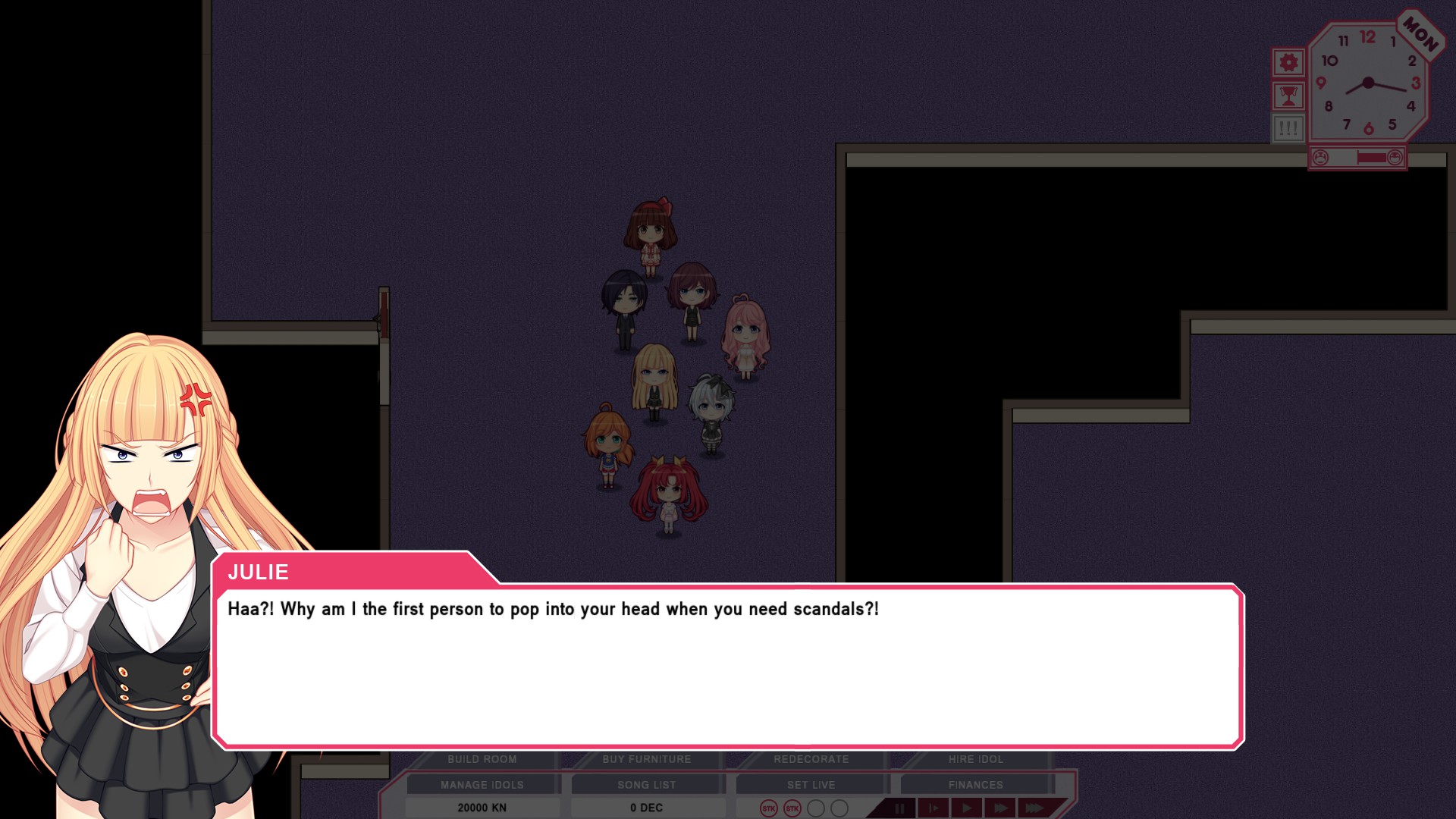
Mariya, for her part is treated as “old” because she’s 25 years old. (As someone in their 30s, I’m triggered.) This is basically the textbook “Christmas Cake” trope, but similar to Aki, she’s the veteran who understands, and is therefore jaded about the idol industry. Also, because beauty is objectively and universally measured purely by age, apparently, she has the lowest Looks rating of all the girls from being 25. (TRIGGERED!)
These three are the experienced characters that are basically right about everything, and whose views are supported by everything that happens in the game, but who the story can never admit are right, so they have to be the butt of all the jokes and constantly insulted by everyone, instead.
Conversely, however, these three are also by far the most useful characters. Mariya straight-up carries the team by being hands-down the best singer in this supposed band. Julie enjoys taking the modeling and gravure jobs that other girls hate doing which make a lot of money, and she’s the only one with Looks good enough to complete those jobs early on, making her a primer money-maker. Aki has the best center power for training your team, and has the best Personality score to take on the other half of the jobs. These three are objectively the best of the original Starnova characters for making money and avoiding game overs. (Although the Quasar girls like Shiro tend to have stats twice as good as Starnova girls.) Everything about the mechanics seems to say that the veteran trio are the ones who are right and your best members, but somehow, the story keeps trying to say that Sasami is the best even though she does nothing and often lags behind the rest of the group as the least popular idol.
The second “set” of one character is Sasami. Sasami is the absolutely generic main girl. Anime stories, especially in the 90s tended to have a problem with trying to make their “main girl” so marketable to the lowest common denominator that they basically scrubbed out any character traits that might make them accidentally objectionable by making them utterly bland and totally interchangeable for any other stock “main girl”. Even the most cliche-driven anime story nowadays tends to at least have a tsundere to give the “main girl” some character, but Sasami is the absolute epitome of basic, factory default main girls. Her likes are “Doing her best”, and her dislikes are “Mou! Can’t be helped.”
“Plucky Girl” archetype characters are especially common in shoujo stories as leads, and almost ubiquitous as non-parody idol story leads. In a story where something like the power of friendship is the highest virtue, a character that unrelentingly believes in her friends and pushes through with no talent other than pure optimism is meant to be inspiring… but that only works in a story where that optimism is justified and rewarded, even if it overcomes long odds.
The problem with Idol Empire is that optimism isn’t justified. The idol industry is a crapsack world that’s all about the money, and Aki, Mariya, and Julie are right. However, the story just ends with Sasami being treated as if she’s right even after the other three were proven right by the plot anyway, because Love in Space doesn’t care about making any sense.
It’s not like there couldn’t be a twist on the basic idea of the Plucky Girl, either, if literally any thought went into her character. Zombieland Saga’s Minamoto Sakura is basically a Plucky Girl archetype, but she’s a more jaded and sarcastic version of the trope who backtalks the absurdities of Kotaro. In the big reveal when she gets her lost memories back, she suddenly goes into full depression, completely breaking the archetype because in her life her optimism really was never rewarded, until the friends she’s made bring her back around. These things make a tired character trope interesting once again. Why can’t Love in Space do that for its characters?
The third and final set are the “girls whose tropes are added in just to tick a box for all the popular tropes even though they absolutely don’t make sense or fit the story.”
Natsuki is described as a “country girl because she is from Kansai”. For those who don’t know anything about Japan, that’s like saying “she’s a country hick because she’s from New Jersey”. See, Kansai is the second-most populous area of Japan, and the most historic region, home of the old capital and many famous castles and temples. Kansai also happens to have a distinct accent, which in dubbing to English, was often done with a Southern accent because dubbing studios were in Texas where the rent is cheap, and they needed to have a different accent to match the Kansai. The apparent idea is that because the dubbed accent has a connotation as a “country girl”, then they’ll just ignore the actual fact of what Kansai would be like (which would be closer to having a Boston accent than anything) so as to fit the bad translation meme rather than reality.
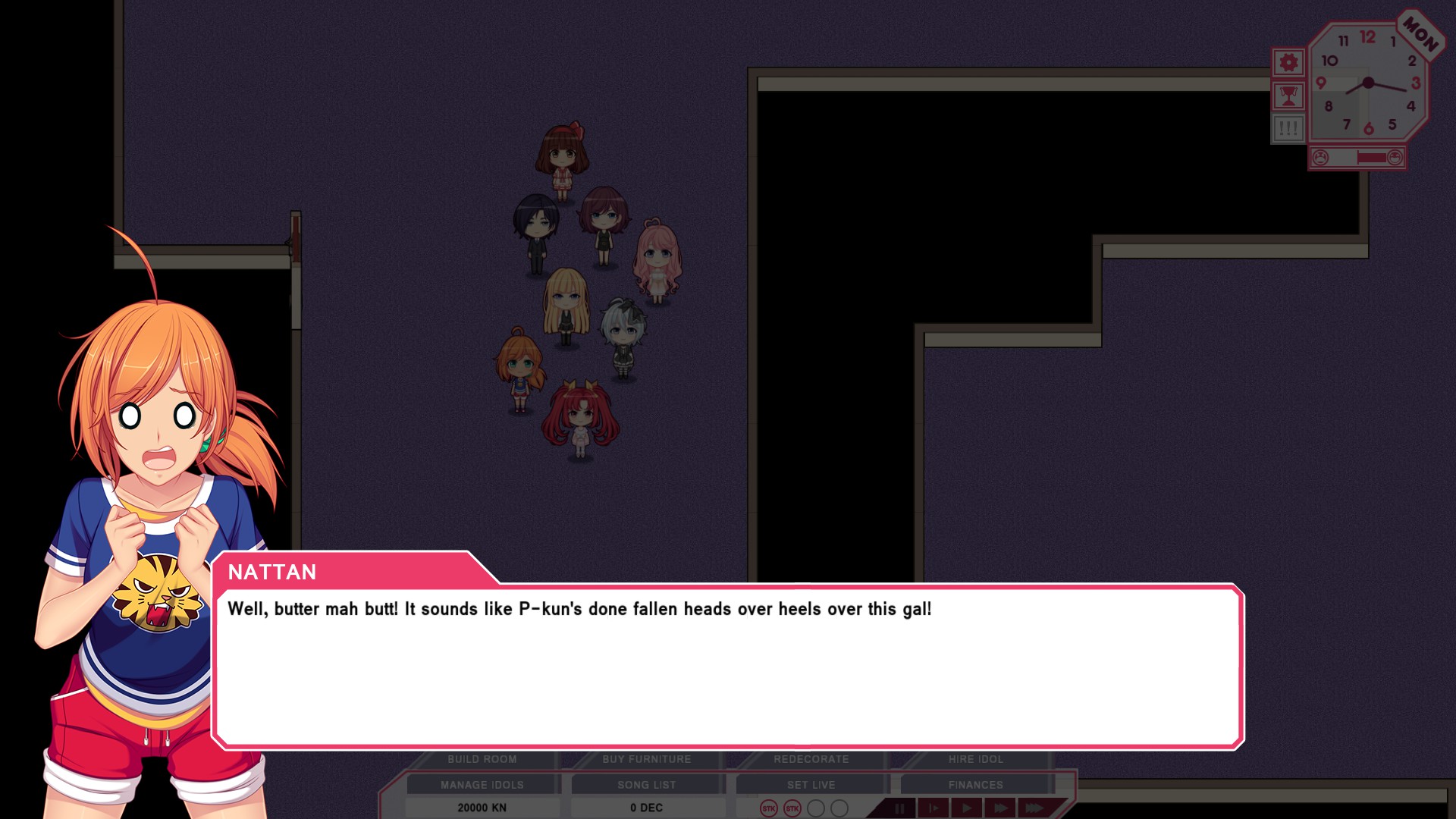
Natsuki is otherwise just the loud, hyperactive “comic relief” character, in the vein of a Pinkie Pie or Radical Edward, except she’s also in the harem of the porn game in spite of doing everything inhumanly possible to not be taken seriously as a romantic interest.
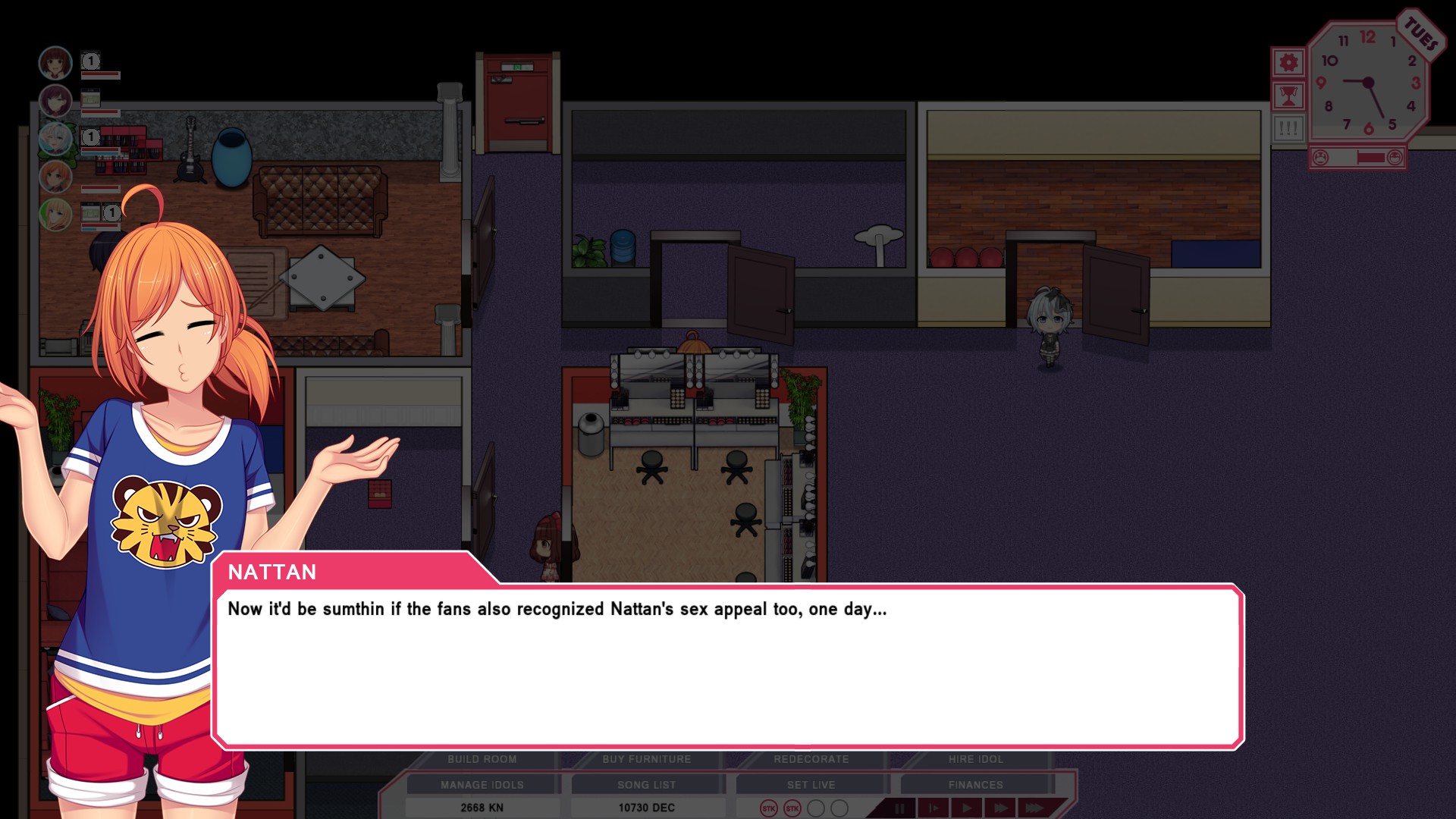
Nemu is The Peri Problem cranked up to 11. She’s meant to be a yandere, although in the context of this game, she’s just a psychopath that randomly attempts to kill the other girls whenever she’s in a bad mood. The other girls know this, but do nothing about it. This is because, again, Love in Space only knows how to ape the story beats of other stories, not how to use them to make sense of a story. She’s “a member of the team”, so everyone is friends with her, even though she’s a literal serial killer who constantly attempts to murder them. Likewise, the other members of Starnova can’t do anything to stop her, because stopping a serial killer from murdering them or even taking it seriously is not a story beat that other stories (that weren’t stupid enough to make a serial killer part of their team for no reason) don’t include in their story formulas, so they don’t exist in Starnova, either.
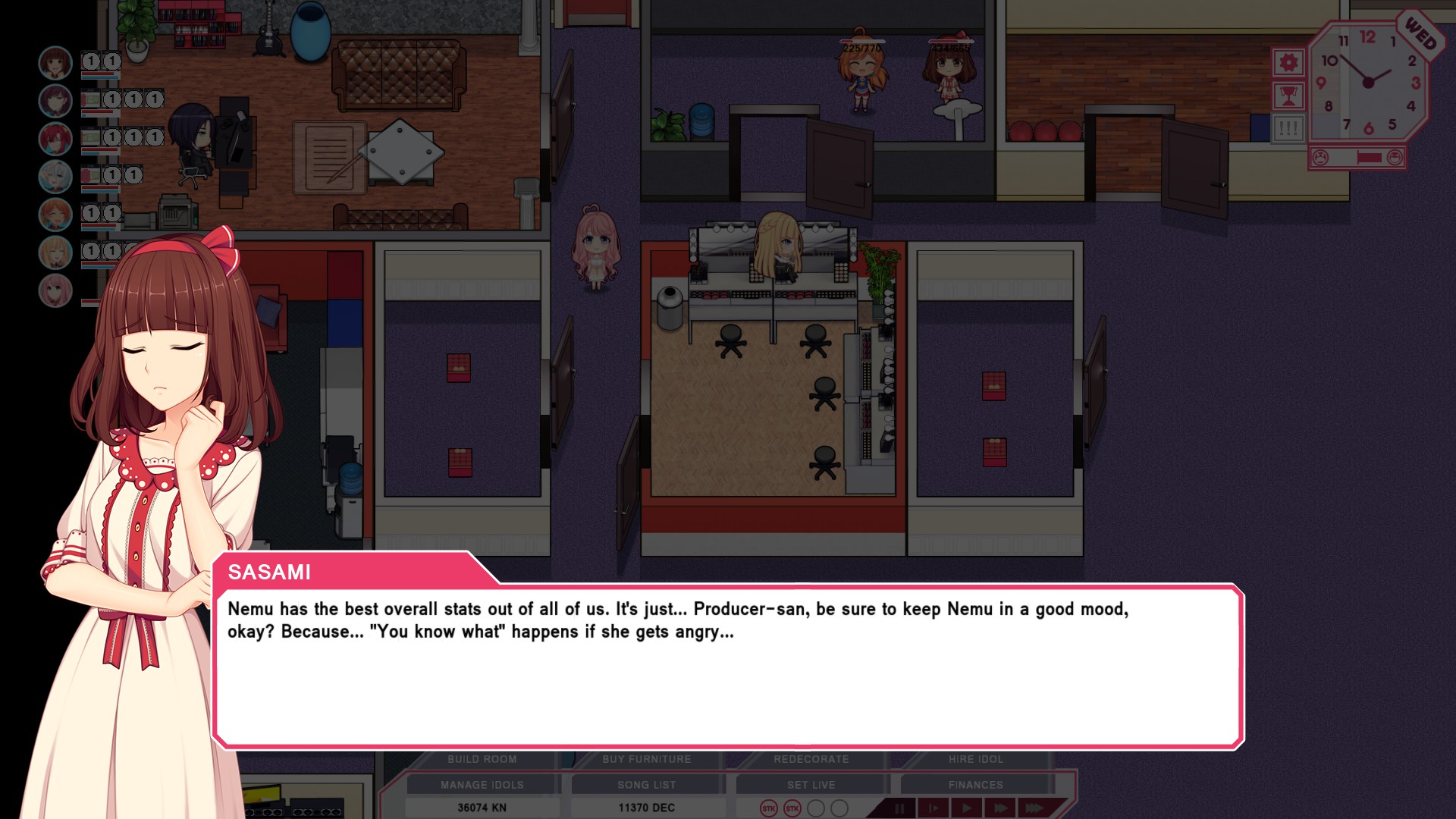
Finally, Mika is one of the few Asaga-like characters whose direct reference I actually recognize. Mika is a direct expy of Rikka from Love, Chuunibyou, & Other Delusions. (I’m sure Sasami and a couple others are direct knockoffs of characters from not-deconstruction idol animes, but I don’t watch those, so I don’t recognize them.) Because of this, Mika is a Chuunibyou (“8th grader’s disease”) character who pretends to be something she isn’t and speaks melodramatically because she has a warped idea of what’s “cool”, rather than “cringy”.
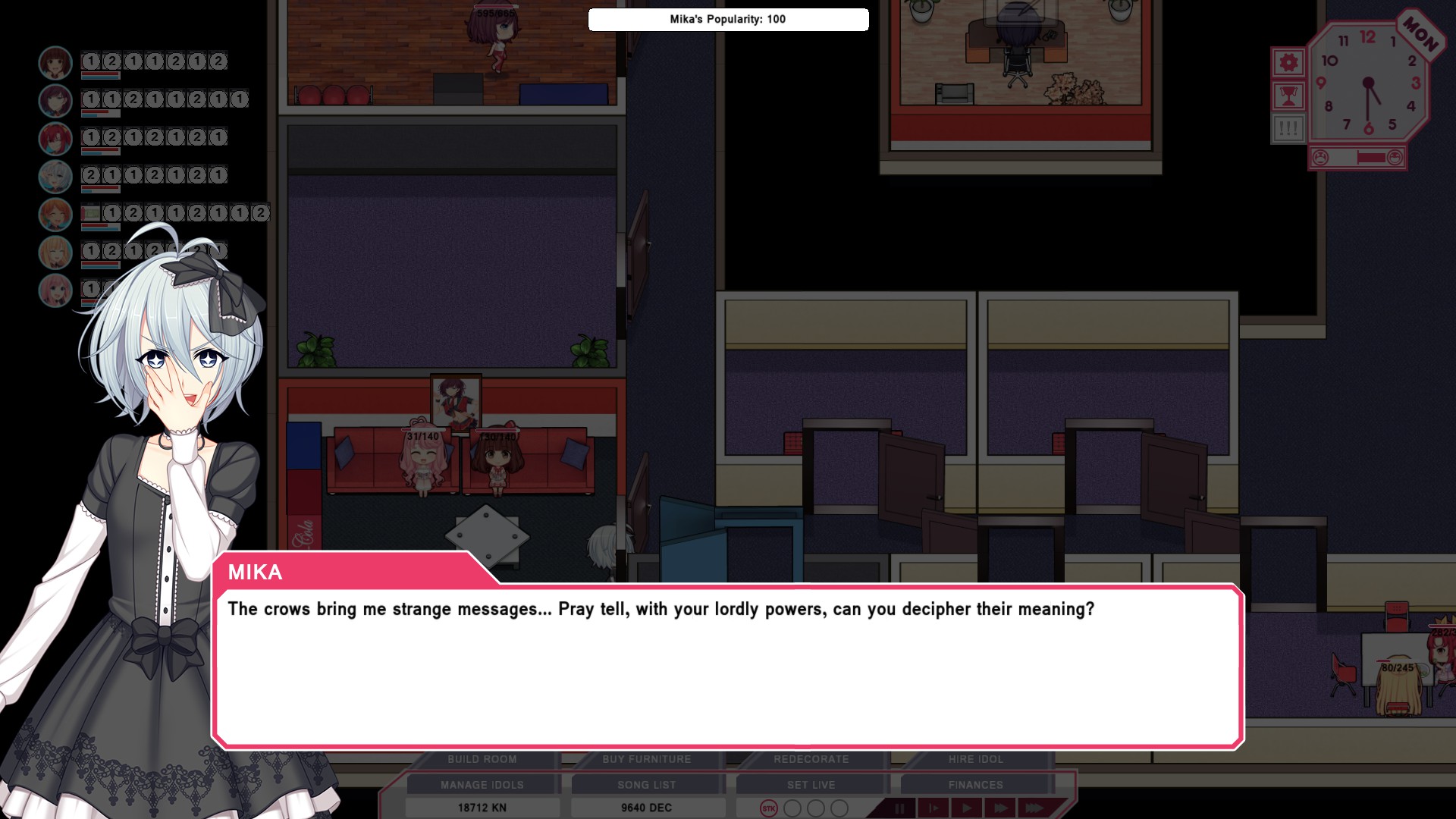
The character of Rikka, however, was grounded by the fact that she was a high-schooler who kept up her middle-schooler persona everyone else had grown out of because she was emotionally stunted by her father’s death, so she behaved like she was younger than she was and was highly naive. Mika just copy-pastes that idea on with being a NEET, and creates a massive contradiction of what her character is supposed to be.
NEET characters are burnouts, they’re common tropes in modern anime since they’re common among the actual anime fandom, but they’re not at all the same thing as an overeager puppy-like chuunibyou. NEET characters are people who spend all their time on the Internet or playing games instead of getting jobs. Hypothetically, that was Mika’s life until she saw an idol anime that inspired her to become an actual idol, herself…
This basic contradiction in character types that Love in Space’s writer doesn’t seem to understand enough to know how to differentiate results in one of the most idiotic of the mission plotlines.
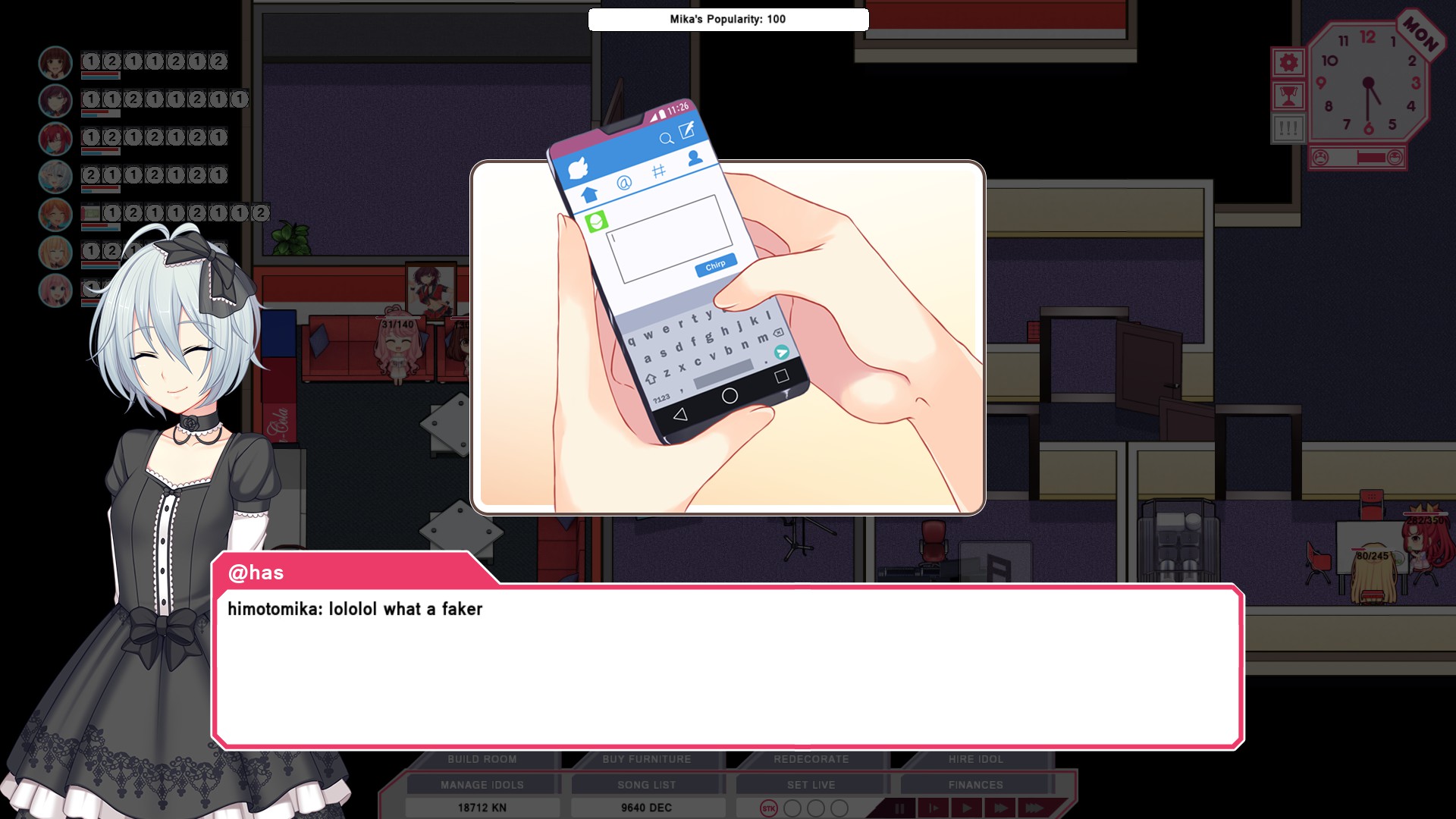
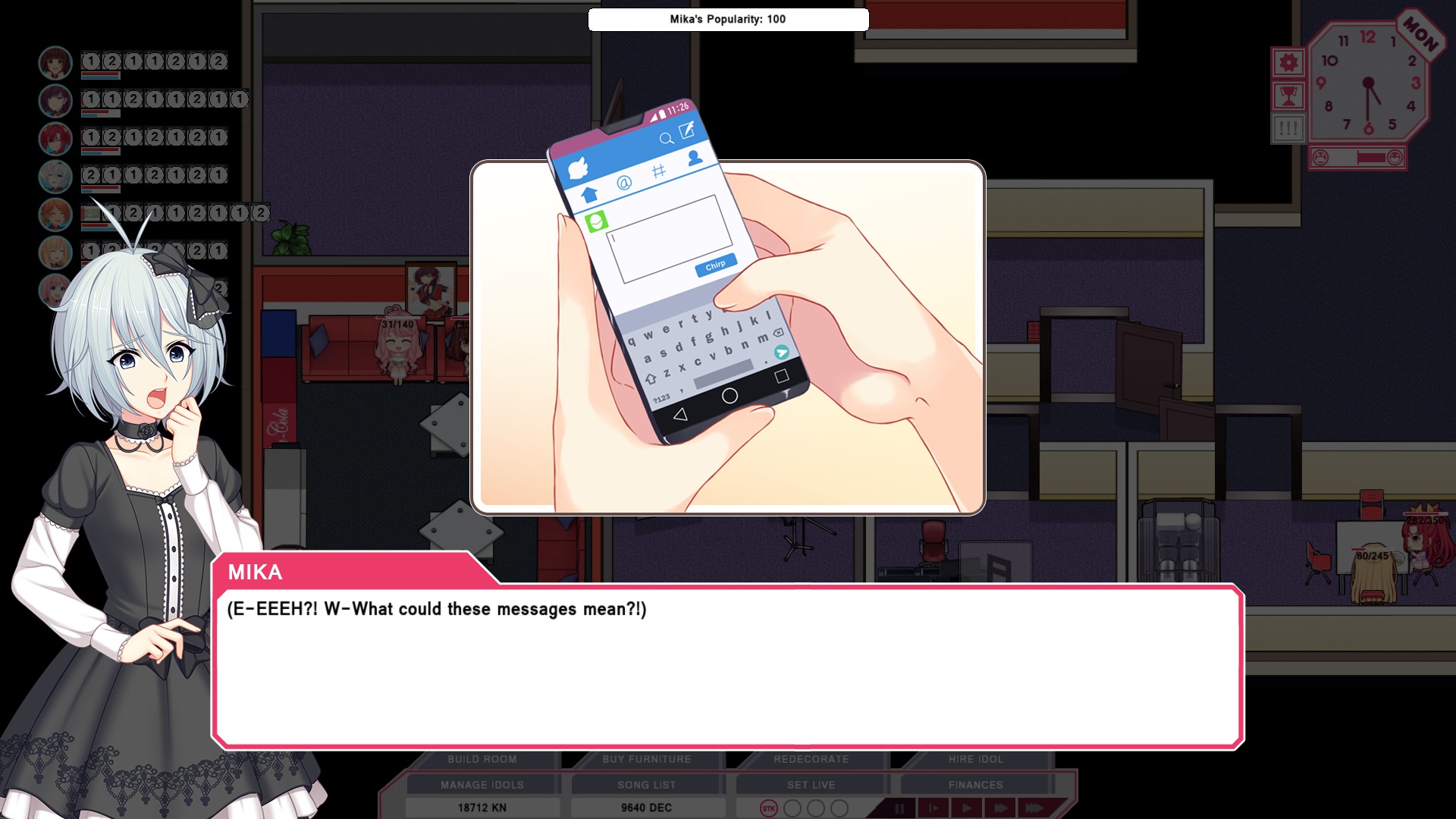
Apparently, the total gamer girl otaku character who was added in just to be both a reference to the “pure girl” Rikka, as well as be a gamer-demographic-appeasing NEET that spends all her time on the Internet talking about games was surprised to learn people tweet mean things at celebrities.
Aside from the critical research failure on the basic idea of who and what this character was supposed to be, the mission 6 story once again manages to ape all the story beats of common stories without giving any regards to what the actual message of the story might be.
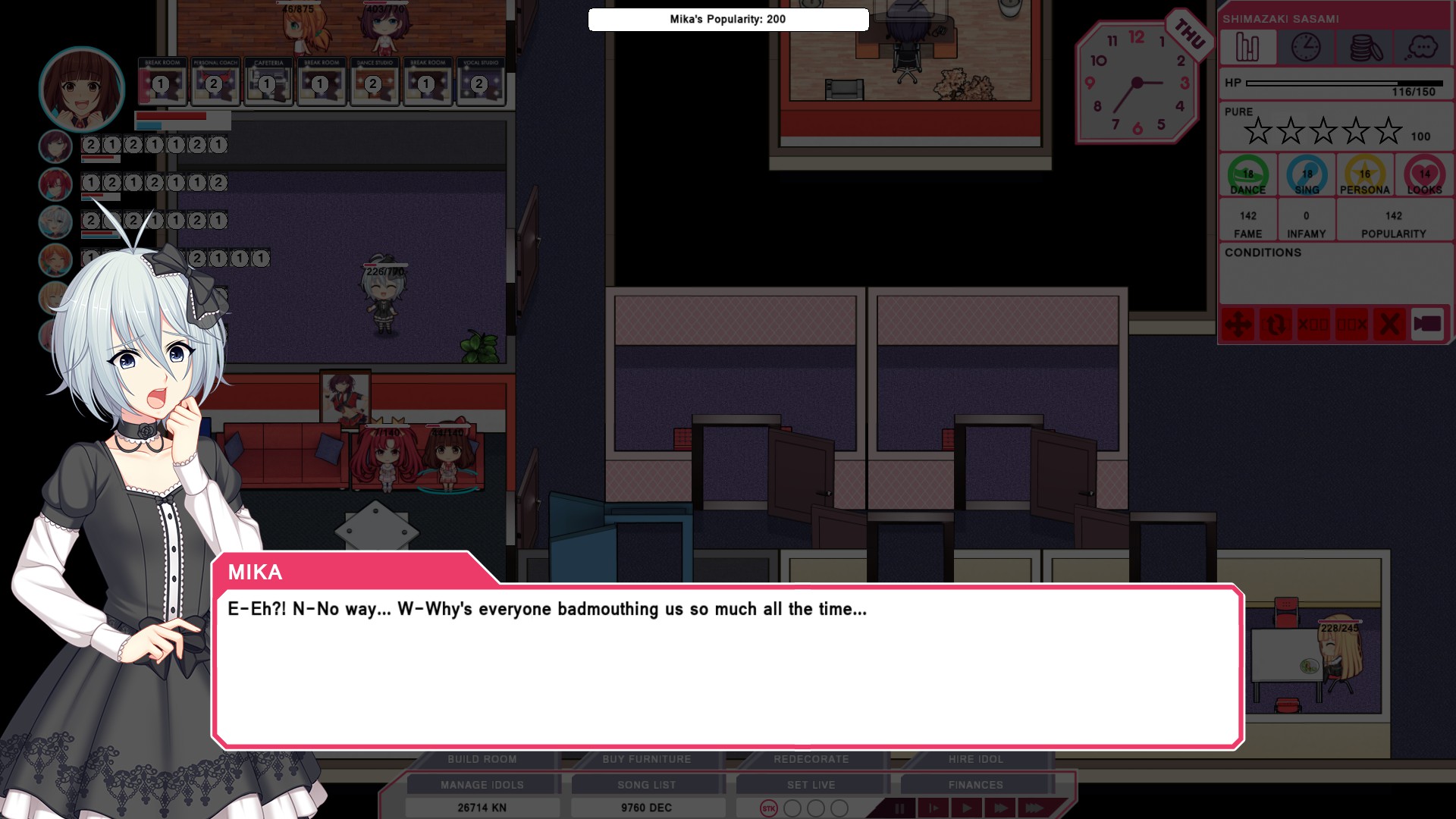
Mika freaks out that people are harassing her online, so the producer (player character) lies to her by saying that the three veteran characters are actually the targets of the harassment, instead. For absolutely no reason, this seems to make Mika feel better, because it’s only “her friends” getting harassed instead of her.
After this happens three times, with escalating threats against Mika being made, Mika then has the reveal and shows she realizes that the producer was lying to her, and that she doesn’t need him to do that anymore. Lesson… learned?
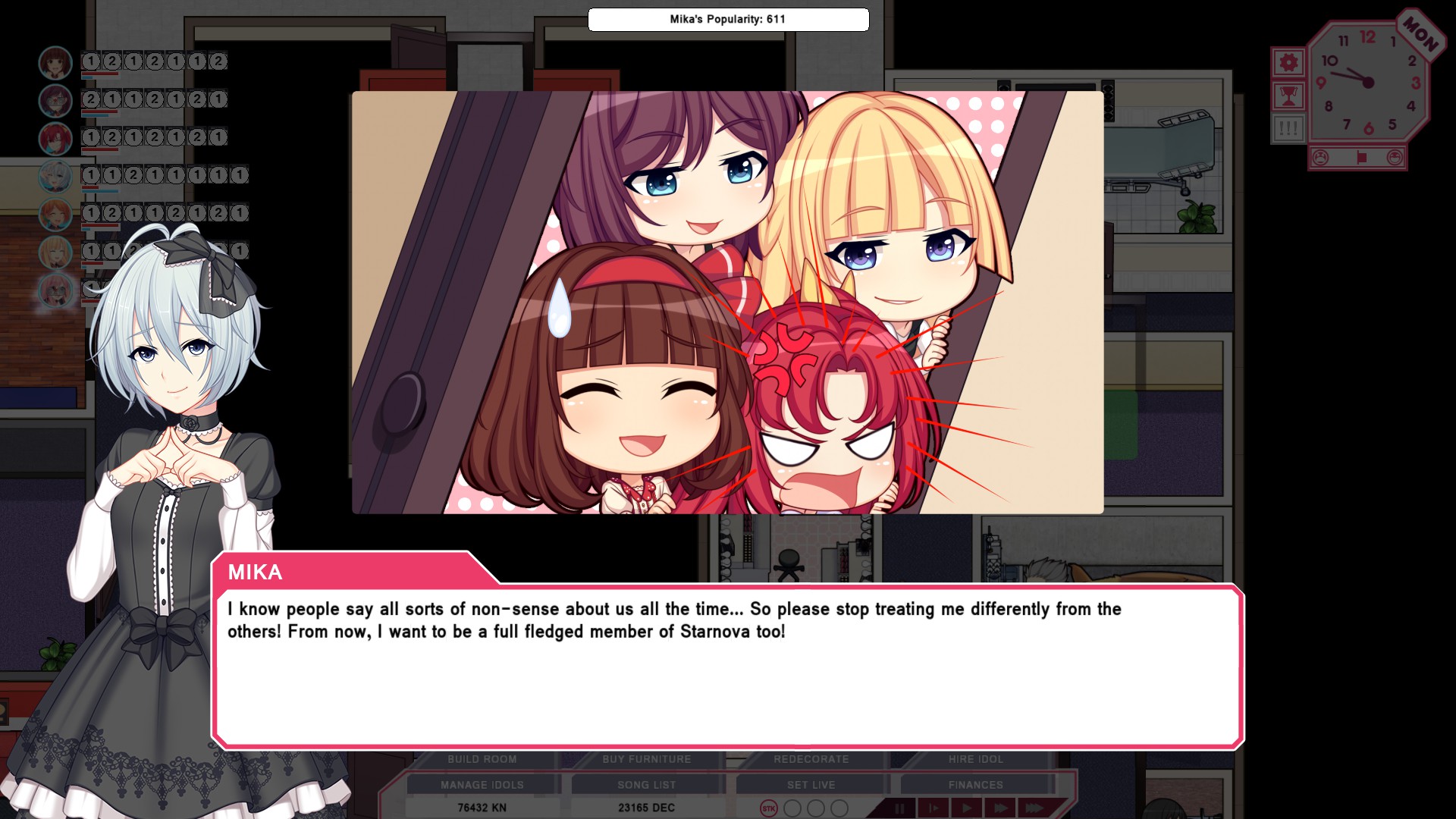
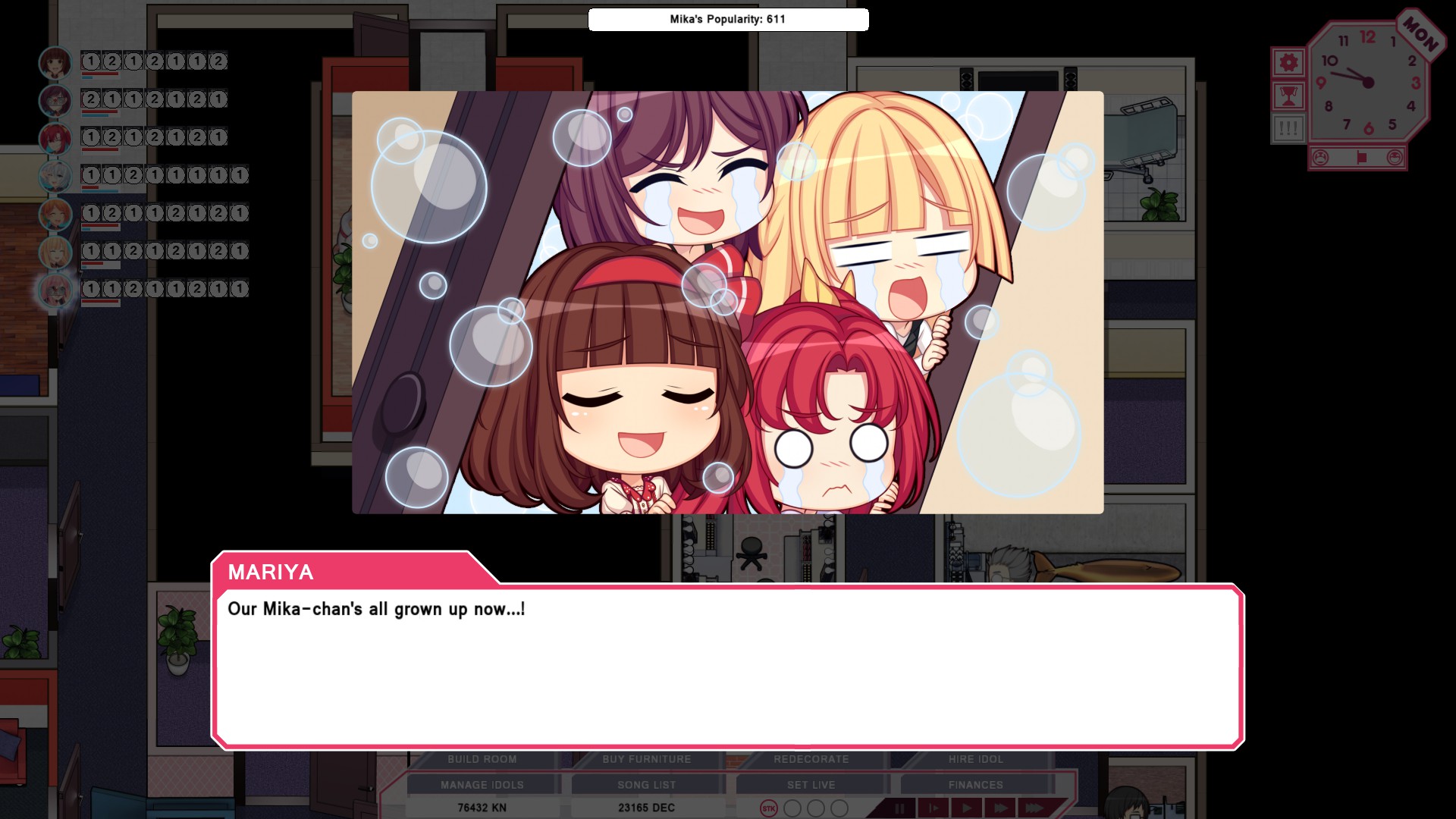
And no lessons were learned.
No, not really. This apes the structure of a story where someone tries to be overprotective but was ultimately underestimating the person they were protecting, but for that kind of story to work, the protected person needs to actually demonstrate they were never in need of that protection. This usually requires them to not be seen knowing that they are being protected at first, and not having reacted to the problems they were protected from at all, so that they can then reveal they are not troubled by the problem when their protector fails to protect them. Mika absolutely was in need of the support, because she actually was freaking out about getting mean tweets and asking for help on what to do. She never demonstrates growth, she merely says she’s a big girl now. Love in Space once again demonstrates it knows what this kind of story is supposed to look like, but never bothered to learn how the mechanics of the story beats are supposed to line up.
Likewise, the producer also mentions that he knew the other girls are eavesdropping when he slandered them to try to protect Mika, which means he wasn’t just throwing them under the bus, he was openly announcing he throws them under the bus to their face, which makes him even more of a douchebag.
Themes and Clarity of Message
“If you have to ask what it symbolizes, it didn’t”
– Roger Ebert
Before I really get into this, I want to first cut off a likely rebuttal to my even discussing the themes of the game at all. Specifically, that this is just a silly idol manager game and that the story and themes should therefore not matter, only gameplay does. To an extent, that might be a totally valid dismissal of a game like a Mario game that has an excuse plot and focuses mostly upon gameplay. (That said, Mario games and many other games do rely heavily upon aesthetic as much as gameplay. Limbo might have similar gameplay to Mario, but aesthetic plays a world of difference in how they are perceived by the players.) Having a bad narrative, however, is very much a damning trait of a walking simulator or visual novel that lives or dies entirely upon its narrative, however.
Idol Empire is exclusively a game talking about the idol industry. It may argue with itself about what it’s trying to say because it’s totally incoherent, but everything from the plot focused upon succeeding in the idol industry to every gameplay mechanic is built around saying “this is what the idol industry is like”. It may not be realistic in many, many places, but it’s always a reflection of or commentary upon the idol industry.
Therefore, judging it based upon what it says about the idol industry, and whether it communicates that story effectively is entirely valid, since that’s by and large what this game is all about.
OK, so, knowing that the idol industry is crap in reality, but that the way to write an inspiring idol story is to kind of ignore that, what does Idol Empire choose to do? Both and neither!
Idol Empire seems to revel in all the problems of the idol industry, making you constantly deal with them in gameplay, while at the same time, writing the story as though the cynical money-grubbing dystopian hellscape you’re playing in is supposed to be inspiring because Love in Space doesn’t understand the implications of their own mechanics or plot elements.
The rival Quasar team for half a second before they are forgotten for most of the rest of the game are treated like they are the villains, but the actual antagonists of this game are the fans. The same fans that you’re supposedly inspiring in your inspiring idol story about how idols are great and inspiring.
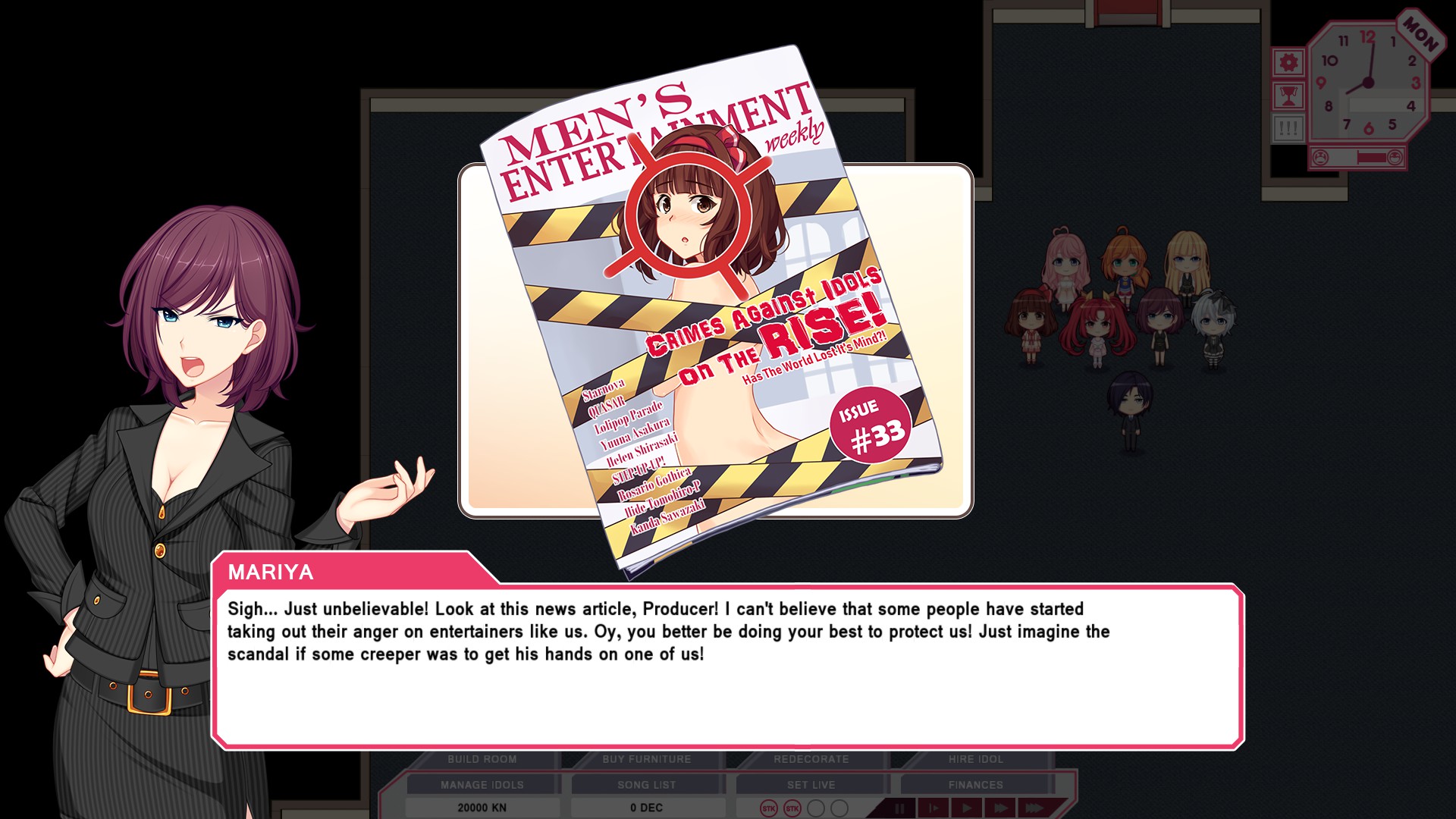
You are in a constant war with the fans who are constantly trying to stalk, harass, or bring down your idols that you’re at least hypothetically meant to be protecting.
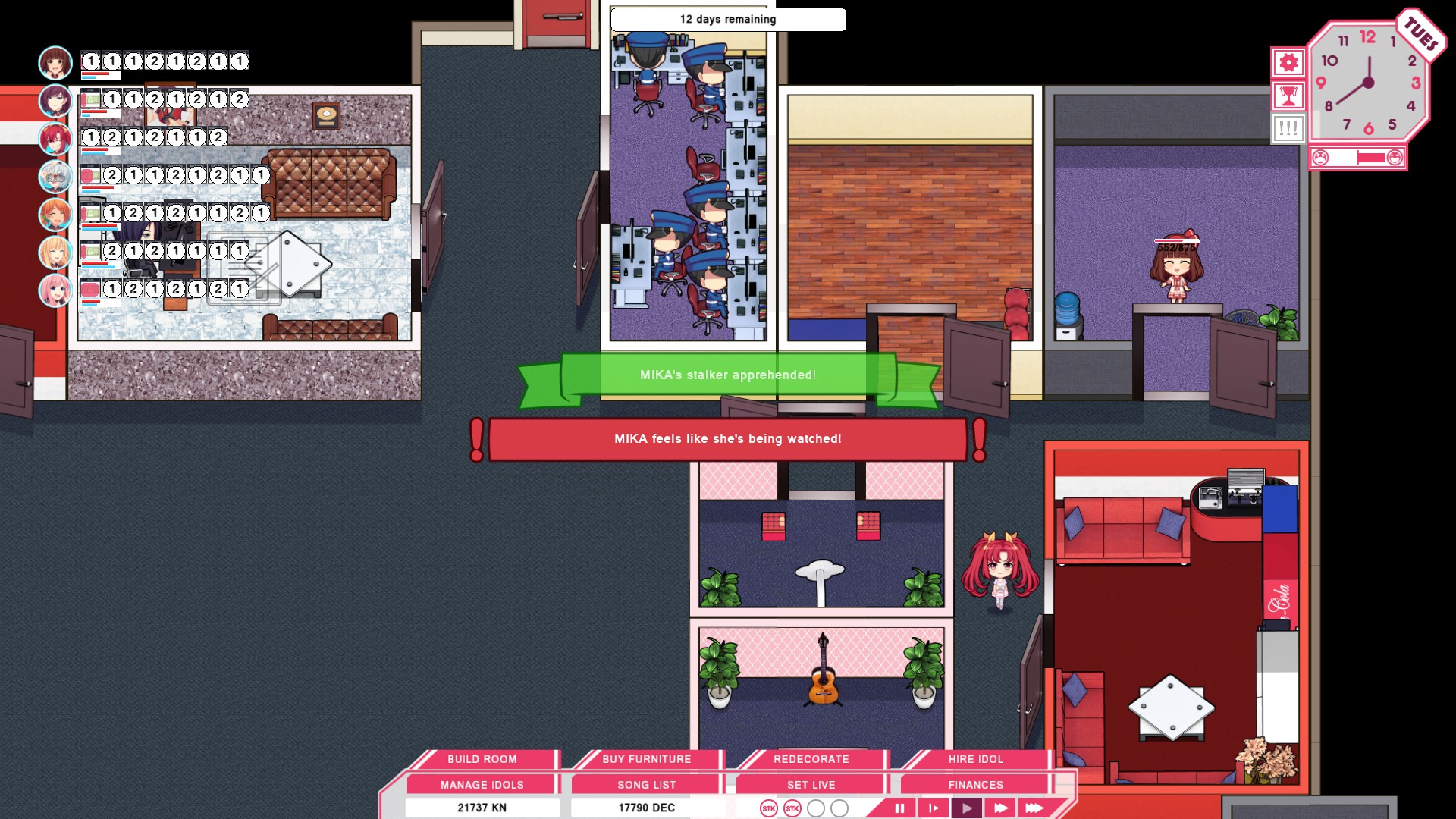
Even the constant nuisance and punching bag of the game, the paparazzi are really just an extension of the fans. Paparazzi wouldn’t dig up dirt if nobody was willing to buy up salacious stories about their targets.
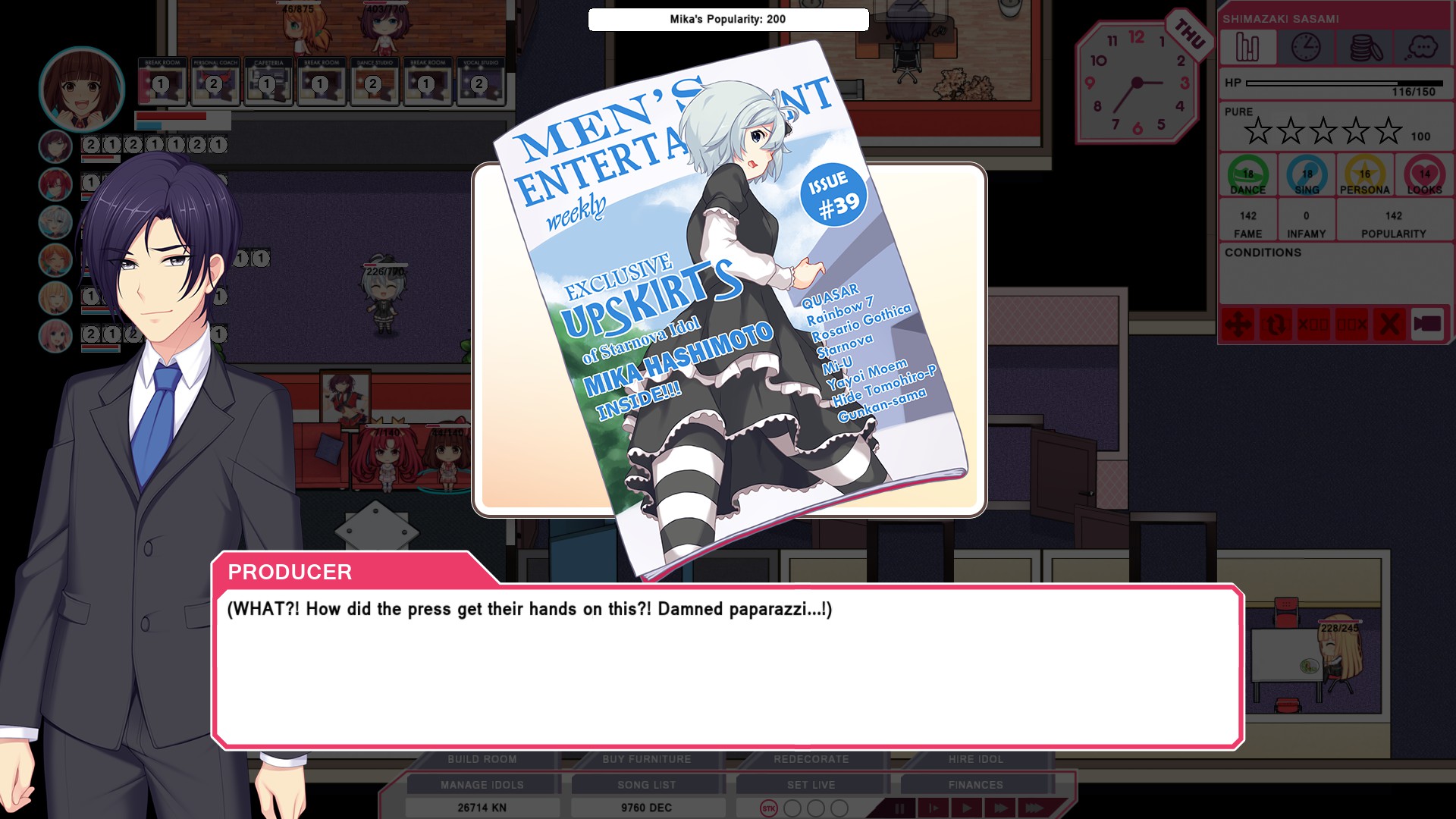
The almost constant parade of scandals tend to target the sexuality of the idols (essentially being a scandal that “women might not be virgins”).
However, they’re basically made explicitly to make the scandals themselves sound either blatantly untrue or farcical on their face.
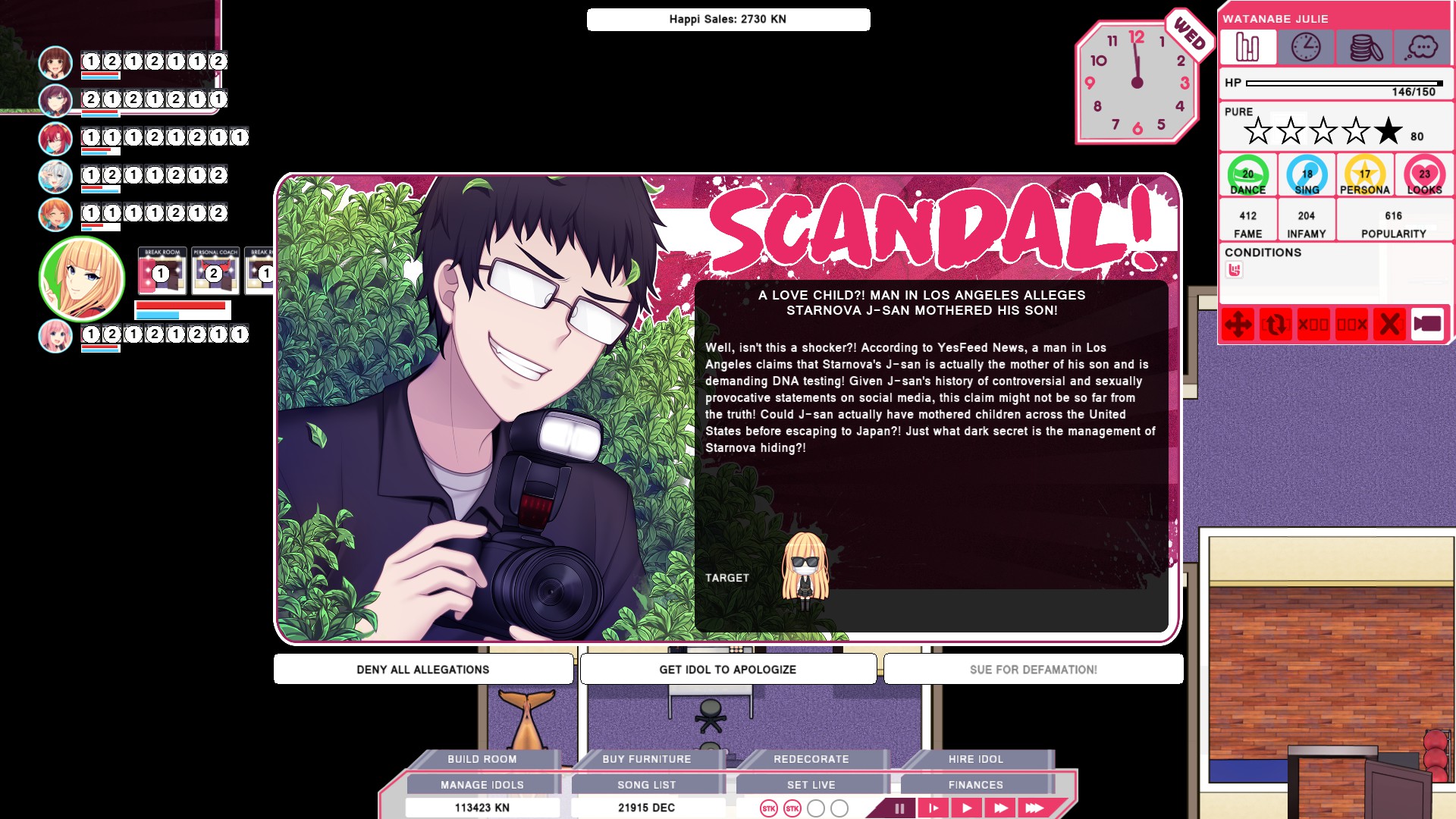
Scandals are best dealt with by having a legal office and engaging in repetitive SLAPP lawsuits. Essentially, this is a game that is fully endorsing censorship of the media by the rich and powerful for their own benefit. Love in Space clearly doesn’t realize that’s the message they’re making in this game, but it is the message their mechanics send – free media is always just lies, so rich people should be able to censor things that make them look bad with the power of money.
The game really punishes you heavily for choosing anything else, in fact. Apologizing inflicts a massive penalty to mood that can send Nemu on a psychopathic rampage, while refusing to apologize drains pure and raises infamy enough to nearly guarantee you’ll be hit by another scandal.
The game doesn’t threaten you with Quasar beating you in a concert except in a single special mode. The primary gameplay loop is based around getting money from your fans without having a massive wave of fan backlash bury you. This isn’t the story of idols versus rival idols, it’s a story of idols versus the evil fans. That’s clearly not what the writing in the story tries to say the game is about, but Love in Space doesn’t know what its own messages are because that takes self-awareness, as well as actual comprehension of what makes the writing of others’ works actually work.
Basic Gameplay
Why yes, I do consider the “what you actually do” part of this game this far down the list of importance.
Idol Empire is a fairly standard “business Tycoon” game at its core, possibly except for the fact that income tends to be more irregular than something like a restaurant tycoon game.
You hire idols, send them to training in rooms for specific types of training, then send them on breaks to recover HP/stamina, cycling through, trying to manage logjams.
You can set up either a schedule that sets specific tasks into a character’s queue at specific times of days of the week, or you can select a series of tasks to be completed and then hit “loop” to make any completed task go to the back of the queue. Because the scheduler is more finicky to set up, I wound up settling on using looping orders, although it takes some pruning at times to prevent characters from trying to go to the personality training room at the same time when schedules become backed up. (The personality training room can only seat one girl at a time, while the dance studio can house as many tiles make up the room minus the bottom row and tile next to the door – punishing wide rooms and encouraging building doors on the south end.) For the most part, training loops are stable and reliable, whereas tasks that make money (besides the event hall) interrupt your schedule.
By and large, your only real goal outside of story mission objectives is to make money and avoid going bankrupt, outside of whatever arbitrary hoop a story mission makes you jump through. Money in this game (which is very definitely set in Japan, and therefore should use Yen) is called “KN” for no reason they bother explaining in this game. As someone who plays several naval simulations, I prefer to think of this currency as “Knots”. My business is going very fast indeed if I’ve managed to accrue tens of thousands of knots! (Tens of times the speed of sound.)
You can make money by recording songs, taking on jobs, performing handshaking events, and hypothetically through performing concerts, which this game insists on calling the insipid wasai-eigo “Live”, instead.
Taking job offers is the easiest way to try to make money, but it requires high stats to do most of them correctly (with failure often generating tons of infamy that will ruin your life with constant scandals), and they’re irregular sources of income, so it’s best not to rely on them for anything other than making girls happy when you give them jobs they enjoy. Each girl has different jobs they prefer, with milquetoast Sasami enjoying Pure-raising jobs like charity hospital visits, while the more openly sexual Julie loathes those and prefers fashion show jobs. Jobs are problematic as well because they can either be totally random or depend upon meeting some ill-defined minimum requirement you probably don’t fulfill at the start of the game when you need jobs most.
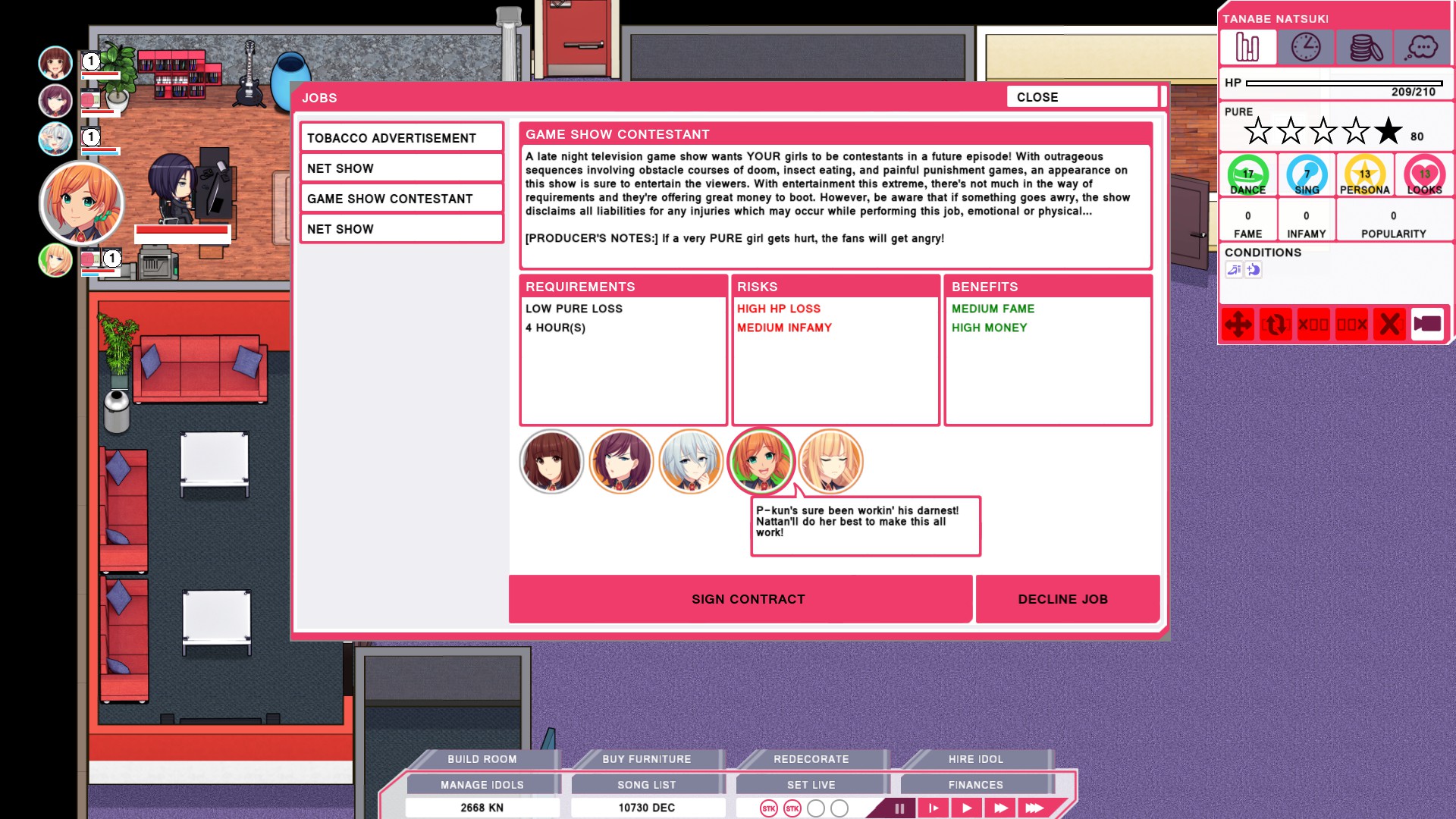
An additional problem is that jobs are not given out based upon DEC, a mechanic that the game describes to players very badly, and which means that your team can be given jobs like roles in a movie constantly from the very start when they have 0 fame and nowhere near the stats to complete the job. Aside from being a job you basically have to cancel because it will give you devastating Infamy if you take it, there’s no good in-game reason why a job that’s a “once-in-a-lifetime opportunity” as Aki likes to say should come twice a day to totally nameless nobodies on the record label bottom.
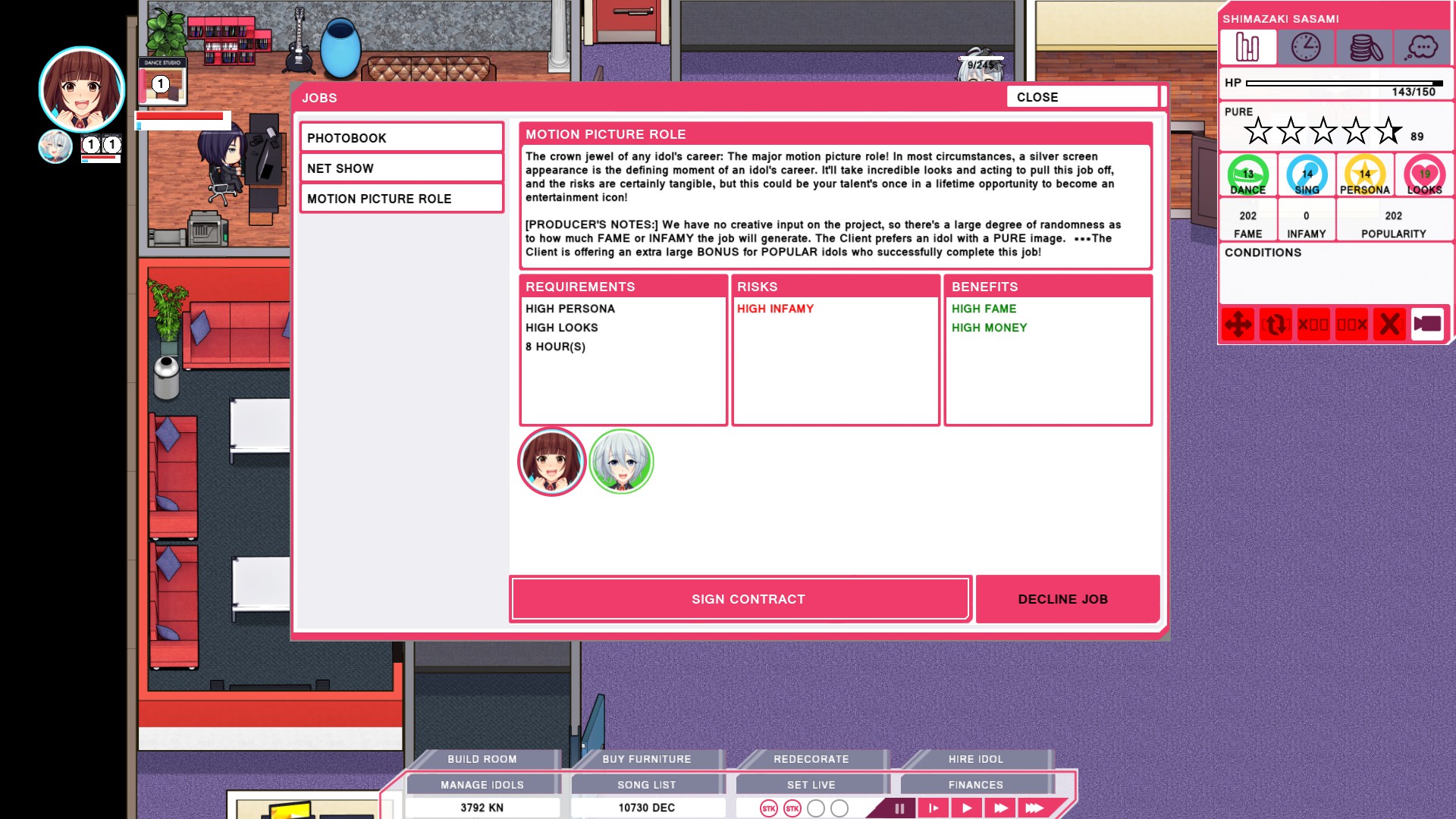
Songs are the most reliable means of making money early on, although success largely depends upon stats and the current popularity of the singers. Low-quality songs (which you tend to make when too broke to hire good songwriters and pay for music videos/”PV”s) also raise your Infamy, but not enough to worry too much about.
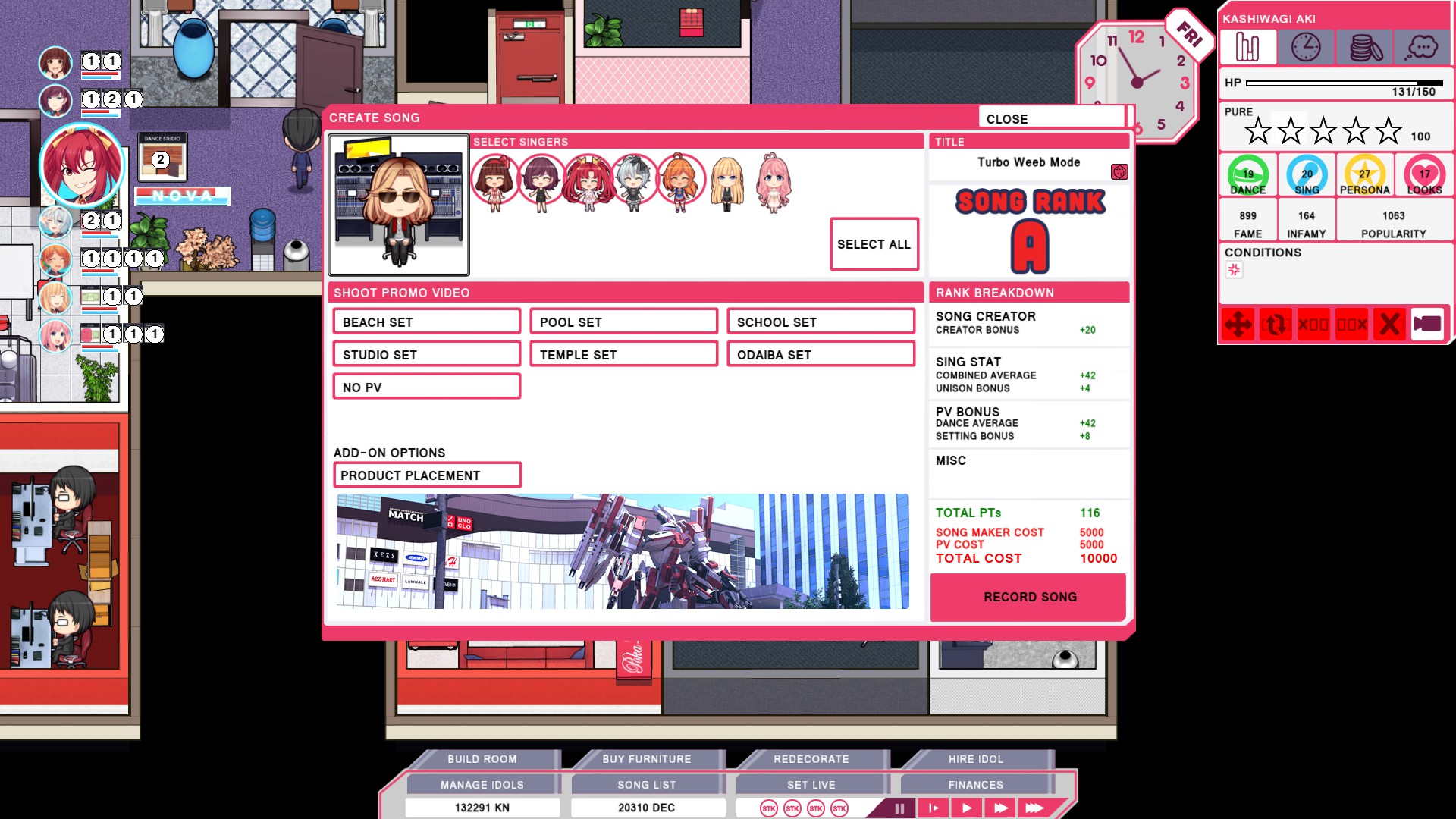
The event room is a high-tier room that allows you to have fans meet your idols in an obvious reference to the kind of “handshake events” held by groups like AKB48 that are most famous by how one of the NOT TRUE FANS attacked the idols attending one of these. (Strangely, there aren’t violent attacks modeled in this one, even though it’s apparently fine to have Nemu chase your girls with a butcher’s knife.)
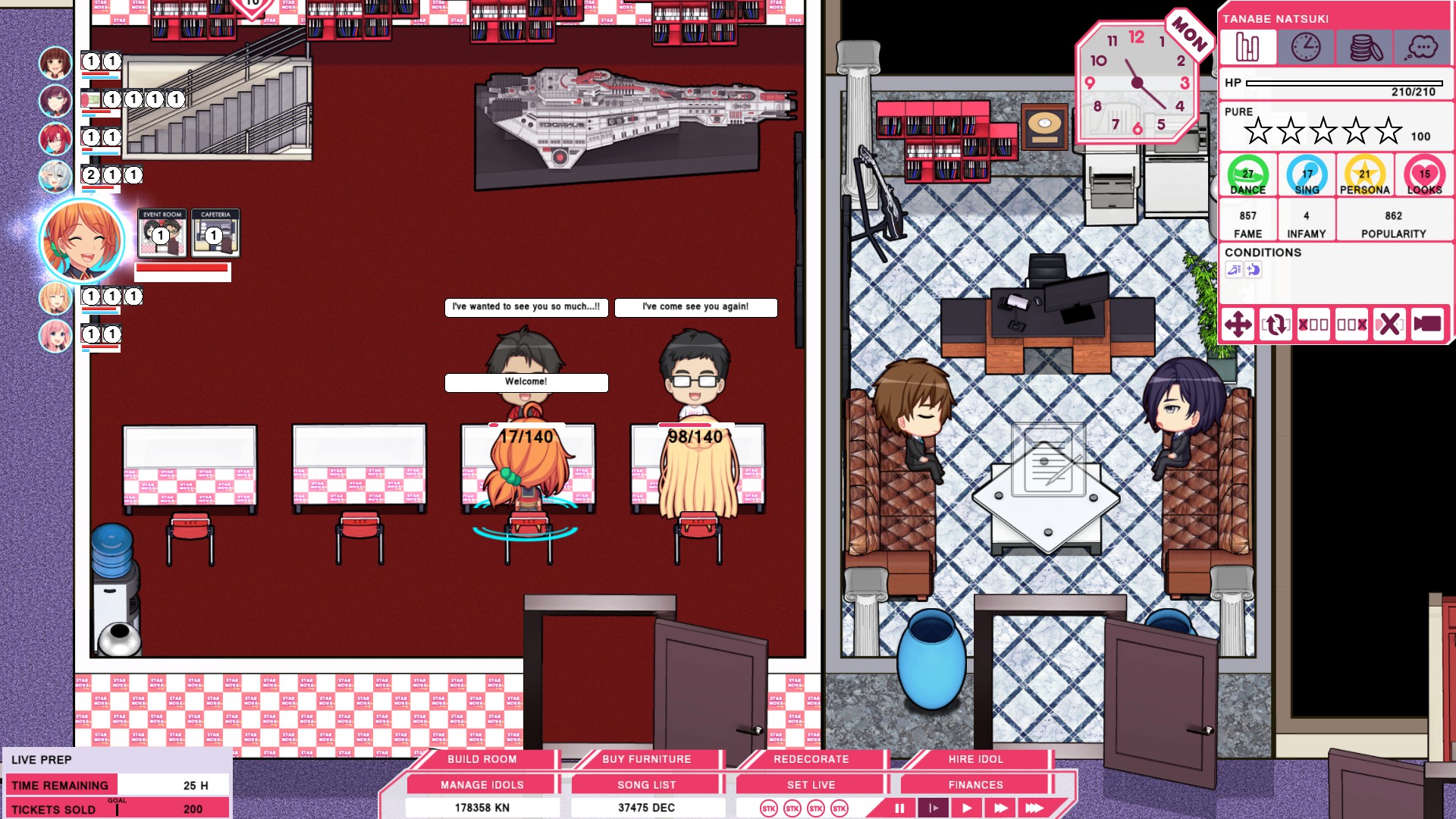
Concerts are a massive shitshow that require their own section below, however, these are hypothetical moneymakers that are actual money sinkholes unless you’re already wildly popular enough to not need concerts and can make all your money with the event room.
Each idol has a color-coded mood, with five steps ranging from angry to ecstatic.
Characters with happy or ecstatic moods will charge up their “Nova” guage that allows them to perform a unique special ability. Some of these abilities are really powerful, while others are useless, however all Novas will recharge the character’s HP to full for the duration of the nova, so even useless ones like Mika’s purity restoration are still useful for restoring HP while on a job.
Characters in a bad mood will trigger negative actions based upon their personality. This includes Nemu’s attacking the other girls with a knife because of her yandere status, so you definitely want to avoid these.
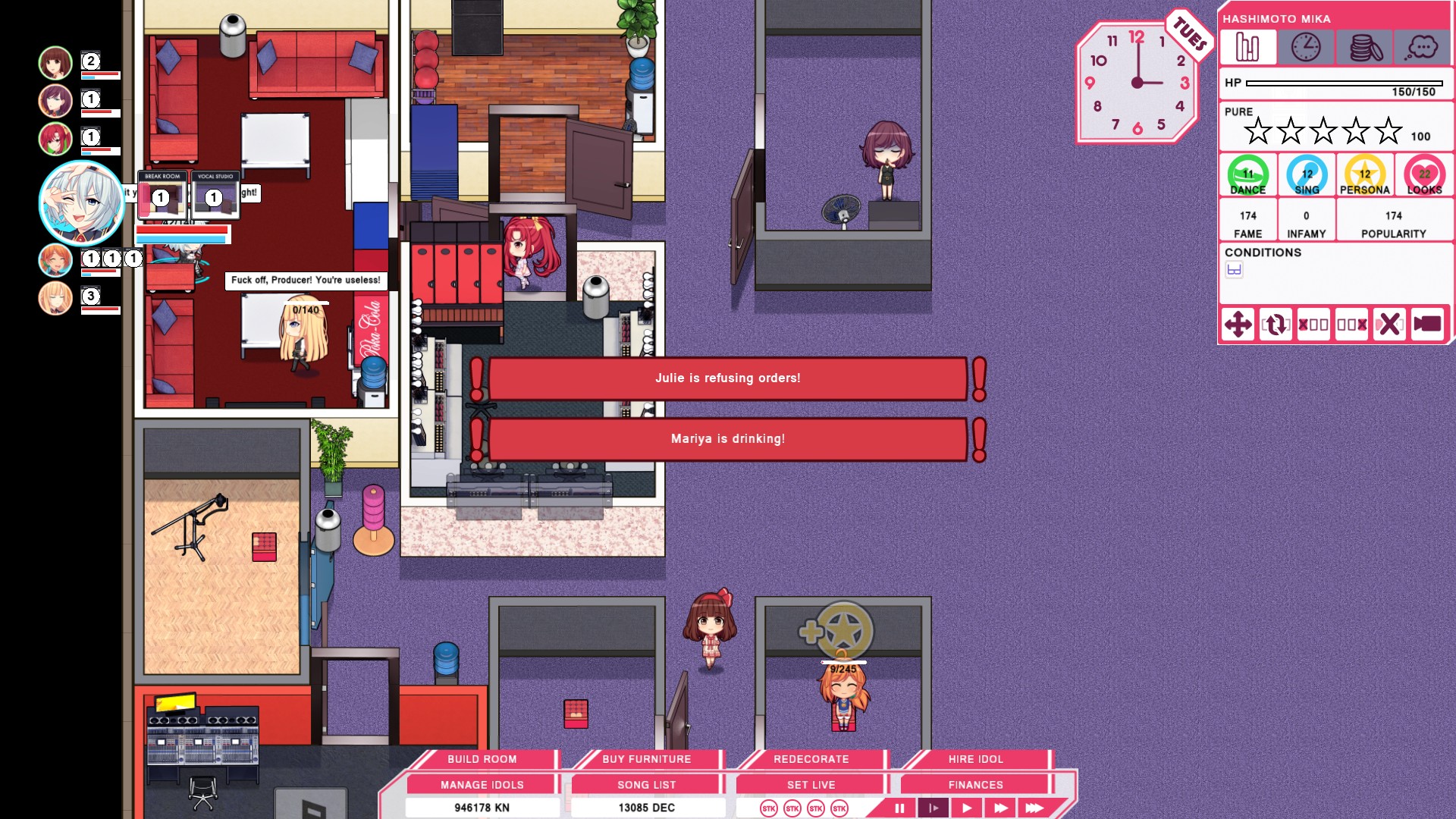
At random points (I’m not even sure what unlocks them, but they don’t seem to appear in every mission even after you’ve beaten the mission, and restrictions on some events are taken off), you can also be given “decisions”. These are treated like something really drastic in the image they show, but these are basically a random event that makes you choose between two bad options or two good options whose impact can be objectively measured to find the one that either hurts the least or gives the most benefit.
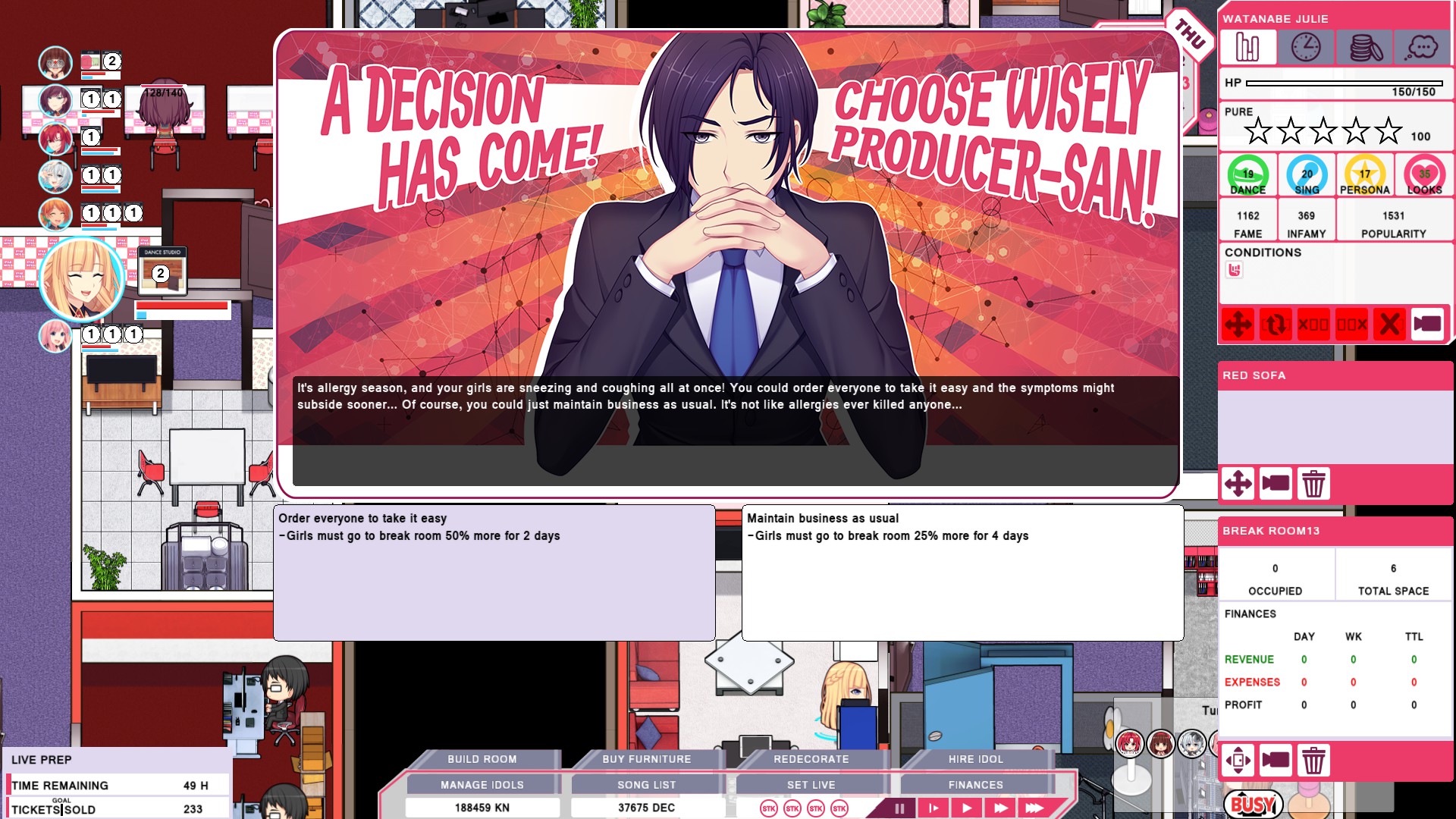
Concerts
In a game with an interface that denies you any of the information you need, confusing instructions, and a lot of busywork over things that don’t matter, the concerts are perhaps the culmination of all the worst aspects of Idol Empire’s game design. What should be the climax of the gameplay, putting all the skills you’ve trained and songs you’ve had recorded to use instead is maelstrom of flashy things thrown on the screen with no real means of digesting or responding to any of it, and with the consequences of your actions being so incredibly opaque you basically have to perform a forensic investigation in the finances record afterwards to even understand what happened.
Concerts start off by making you select a venue. Venue selection is very important because you pay more for a larger venue, but larger venues can sell more tickets. The cost of the venue is basically half of what you’ll make back from ticket sales alone if you completely sell out. How many tickets are you capable of selling? WHO KNOWS! Of course the game won’t tell you through any method other than trial-and-error, because Love in Space hates communicating clearly. Just save and reload until you get it right.
Concerts let you use between three and twelve songs. The idols consume HP constantly as they sing, so you want to cycle the idols around to use them all evenly… or just play only three songs, because you’ve already sold the tickets and get the same money no matter how long the concert actually plays. In fact, expenses go up as concerts go on, so you have every financial incentive to rip off your customers.
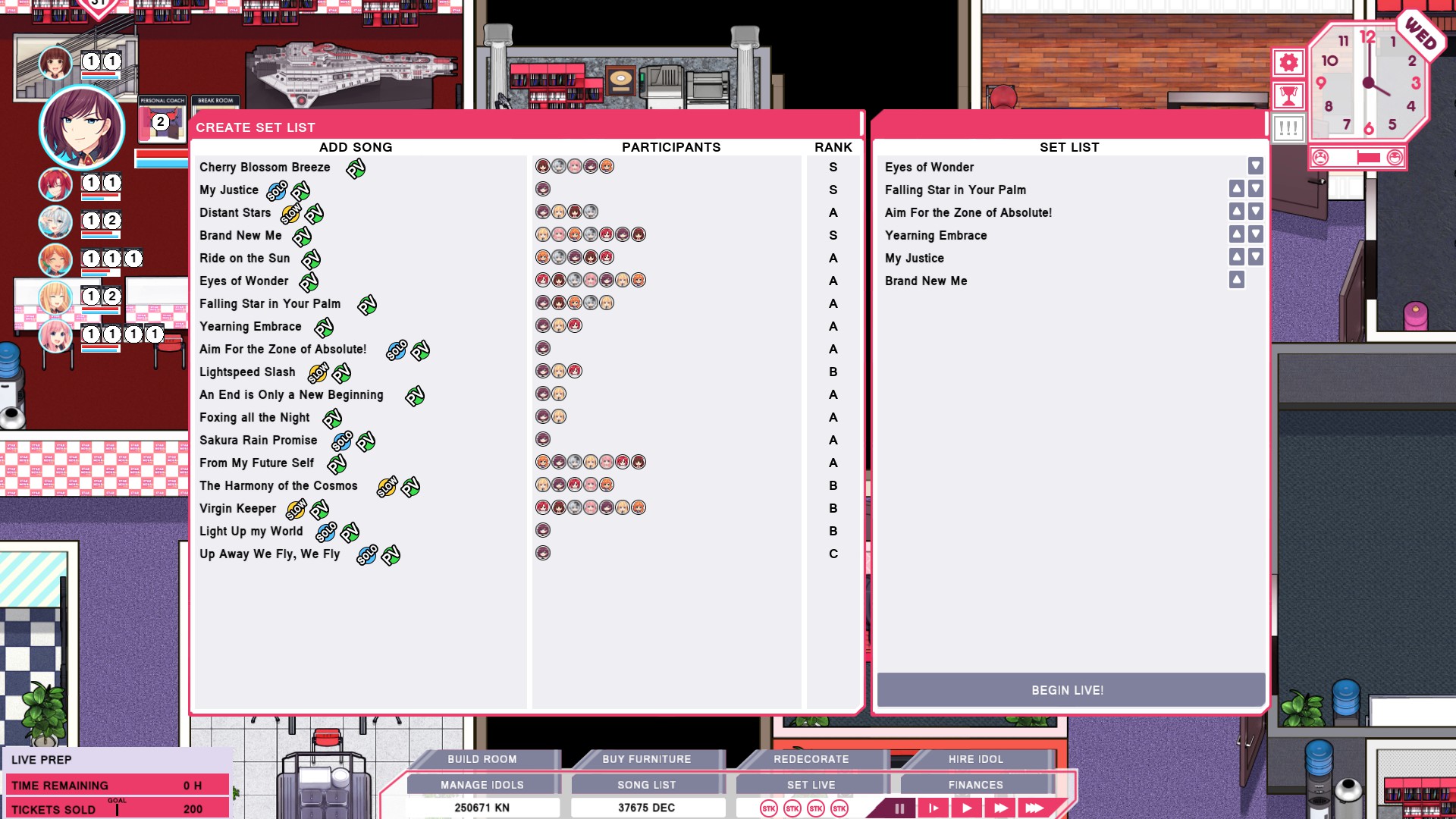
At a concert, circles with stat icons are flung by fans at the idols. Idols can fire bullets at these icons based upon their stats, popping them to fill up a Hype meter that’s supposed to be good for some reason. You participate in this by clicking on the screen to create a “stage effect” that is a small firework that clears away circles, although you don’t get any Hype for this, it costs money, and it costs increasingly more money every time you click. The game also does nothing to stop you from double-clicking or repeatedly clicking in the same spot to waste tons of money for no gain.
The game doesn’t tell you this ahead of your first concert, but the rank of the song affects how fast the circles fly at your idols.
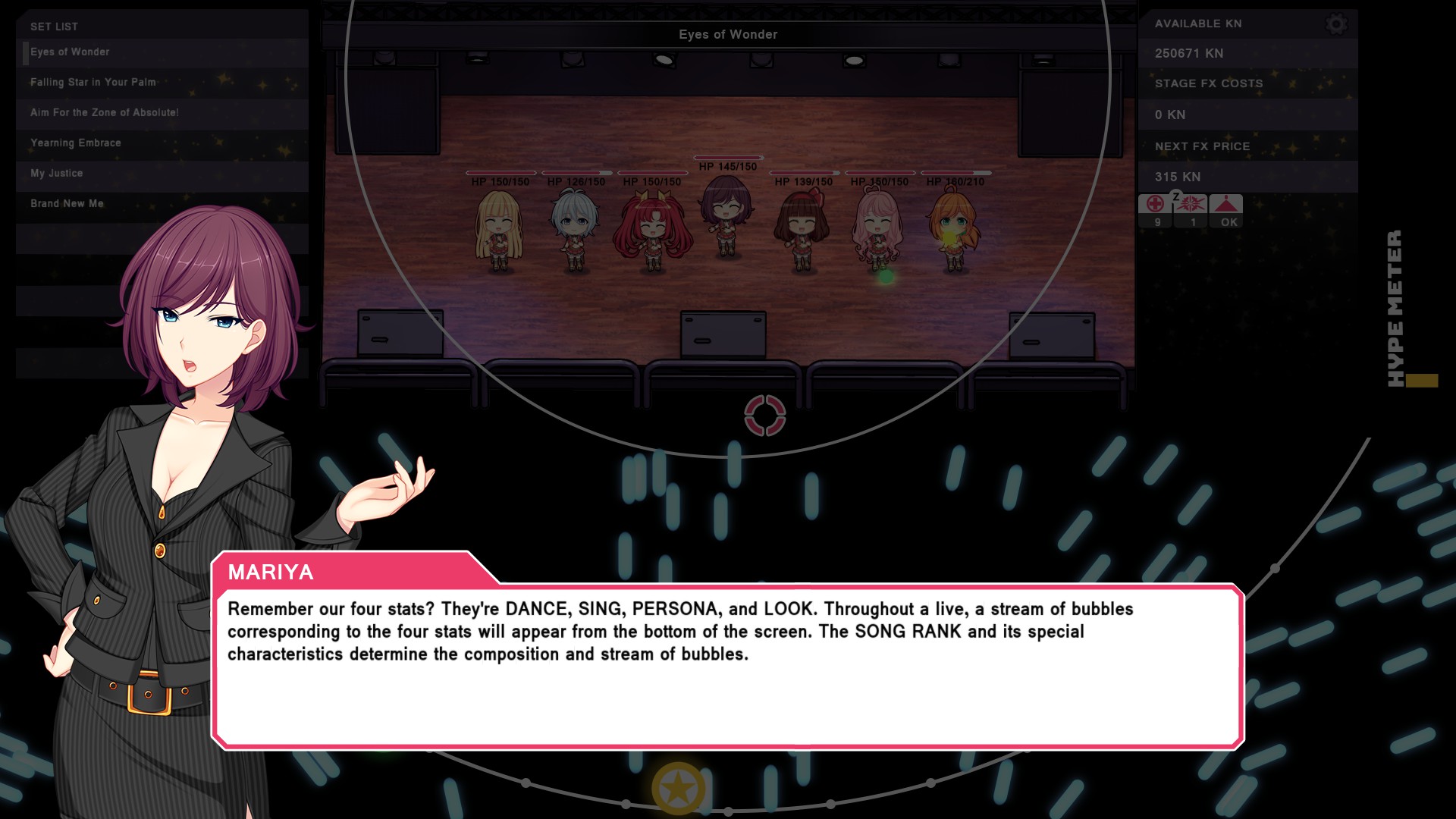
Basically, at a time when you are capable of recording “SS”-ranked songs, your idols are capable of reliably performing “B”-ranked songs without help, or “A”-ranked songs if you’re willing to lose money shooting lots of stage effects.
I’ve seen it argued that game complexity isn’t so much how complicated the mechanics of a game are under the hood, but a matter of what kind of information a player has to base a good decision process upon, how readily they can access that information, and how much time they have to process that information. A game like Dark Souls has very simple information in the form of what wind-ups an enemy is making for you to react with simple attacks or parries or dodges, but it can still have complexity because this is information you need to manage at a rapid rate of speed compared to a turn-based strategy game like Civilization, which demands you process more information, but at a vastly slower pace. Meanwhile, the more difficulty one has in getting information from the interface (I.E. how good the interface is) eats into the time the player has to make those decisions, making games that have poor interfaces feel more overwhelming and complex simply because it is harder to get the information you need to make your decisions.
Since I’m talking about interface and Idol Empire, you know it’s awful.
At S-rank and higher, the circles are flying at your idols so quickly, it’s basically impossible to look at anything else on the screen but the circles if you want to have any chance of keeping up with what’s happening. This means that the numeric display of HP is too much information to read without losing concentration on the flying circles, and Love in Space helpfully made the red HP bars impossible to read for you. At a time when “good play” is (maybe?) judged by how much you conserve your stage effects based upon how much money you will gain from a concert compared to how much you spend, the amount of money a stage effect will cost you is a numeric counter in the corner of the screen you have a fraction of a second to read between waves of circles to try to respond to what’s flying at your idols to decide whether it’s worth saving them from this wave or not before the decision is made for you.
Honestly, it should have been a red flag that there was a separate difficulty setting for “Live difficulty” than for the whole rest of the game when you basically don’t have any control over the concerts in the first place.
Something else the game doesn’t tell you ahead of time is that your idols will have stats in the exact state they are in when time is up and a concert starts. This means they can start a concert with low HP if they were training before a concert starts, and also that makeup grants a powerful bonus to concert performance by giving vastly higher looks stats to the characters, especially if you have Julie be center.
It also affects how much “hype” a song generates, which increases fame generated, although how hype is calculated is even more obtuse, and when I’ve deliberately played worse concerts to save money, I’ve managed to get higher hype than ones I tried to get through perfectly, no matter the costs. Again, nothing about concerts makes any sense, so don’t even bother trying.
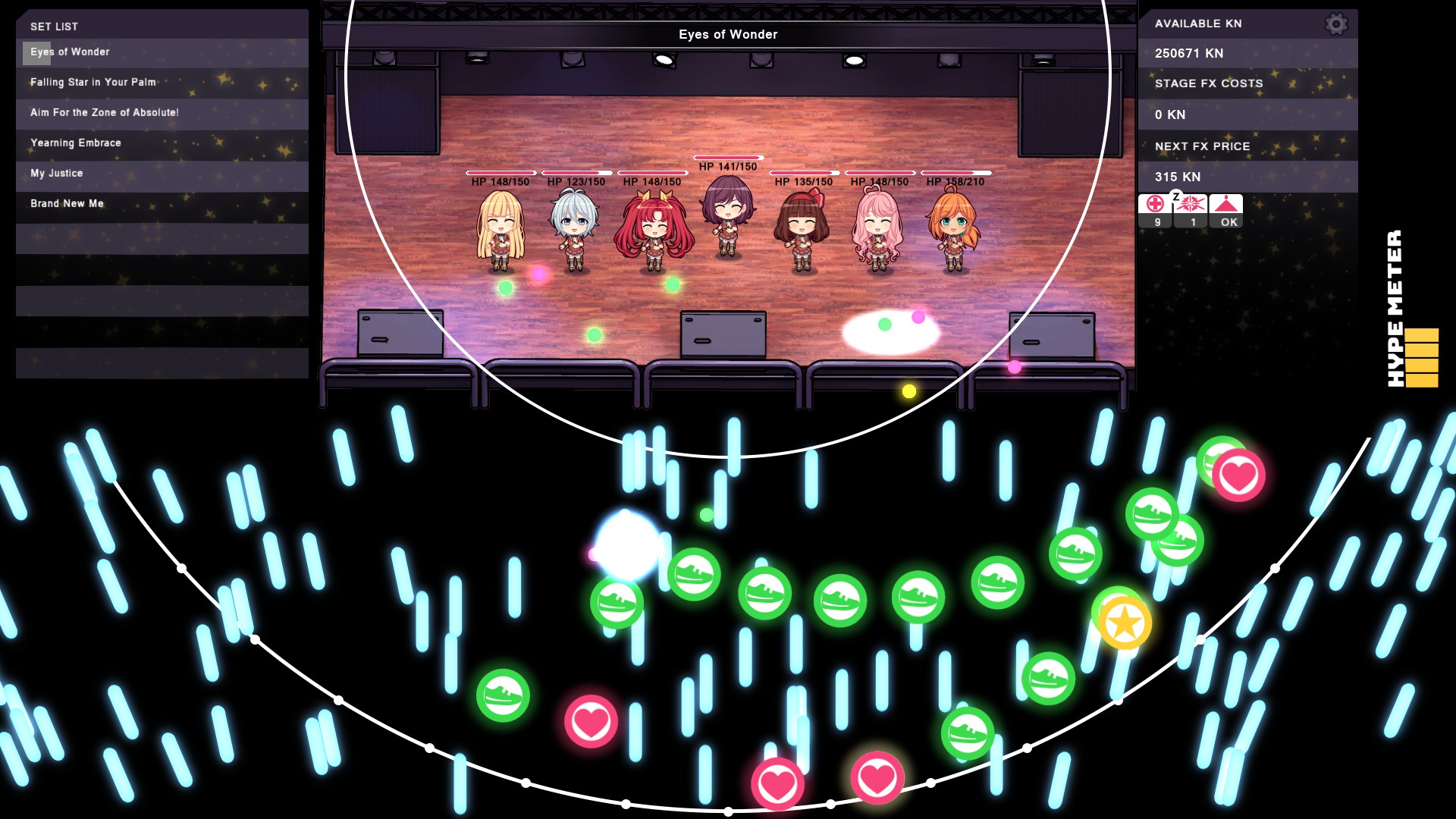
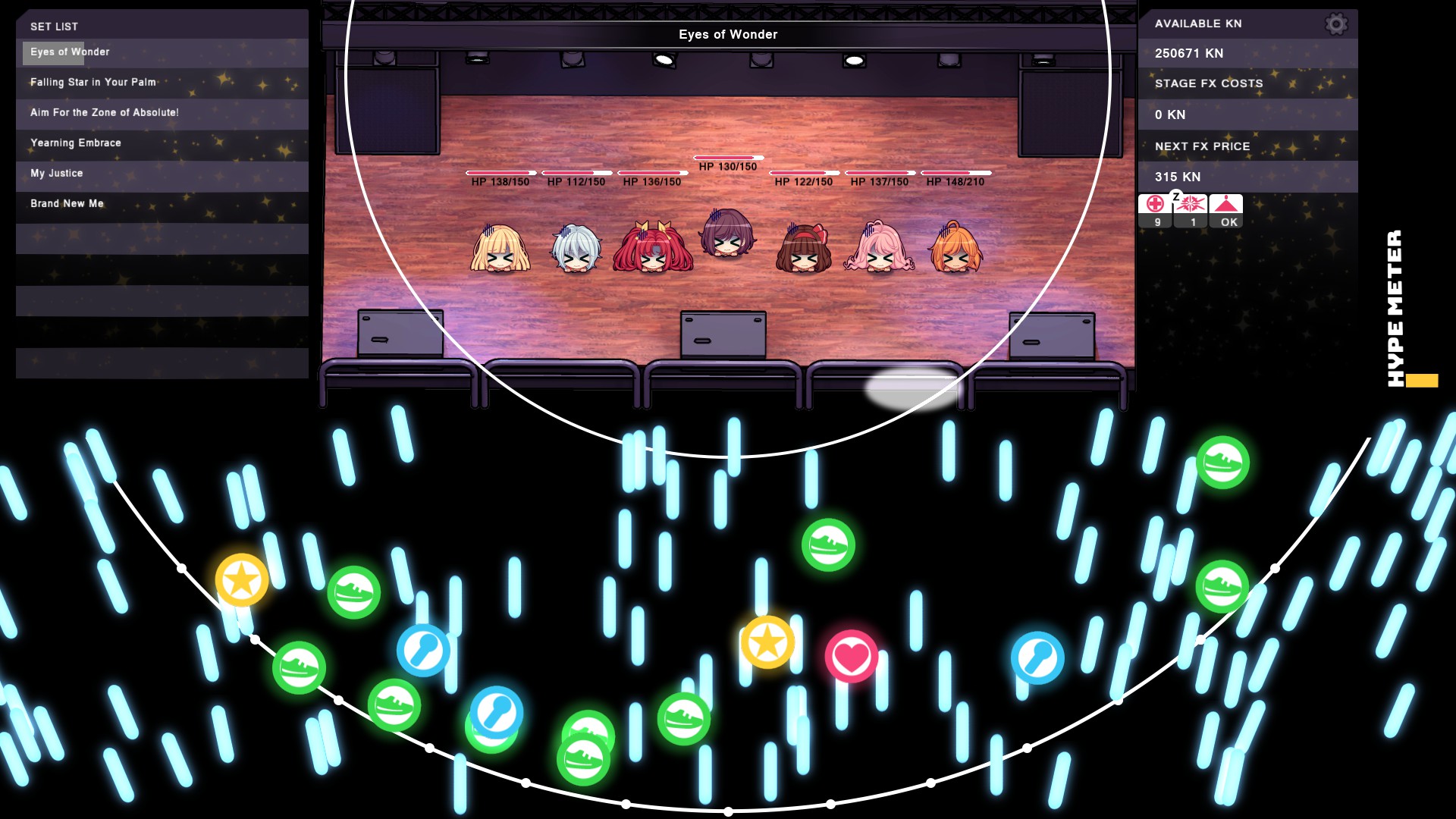
You can see in the first of the two images directly above a zig-zaging line of circles all of the same color. Your idols will generate bullets of a color at a rate based upon their stats, which means the random circles of different colors can be easily shot down by them at their own pace. Those large lines of circles of the same color basically exist to overwhelm your idols, and force you to use a stage effect to clear away enough of them to prevent your idols from all tripping like the second of the two images. They appear nearly constantly, however, and if you try to prevent your idols from all taking a dive en masse, it takes a constant stream of stage effects to do it.
Once idols start tripping, they cannot fire bullets for a while until they get back up, meaning that wipeouts like above will lead to more tripping as nobody is shooting down the oncoming waves of circles, forcing you to use stage effects unless you want the whole song to just consist of constantly kissing the stage.
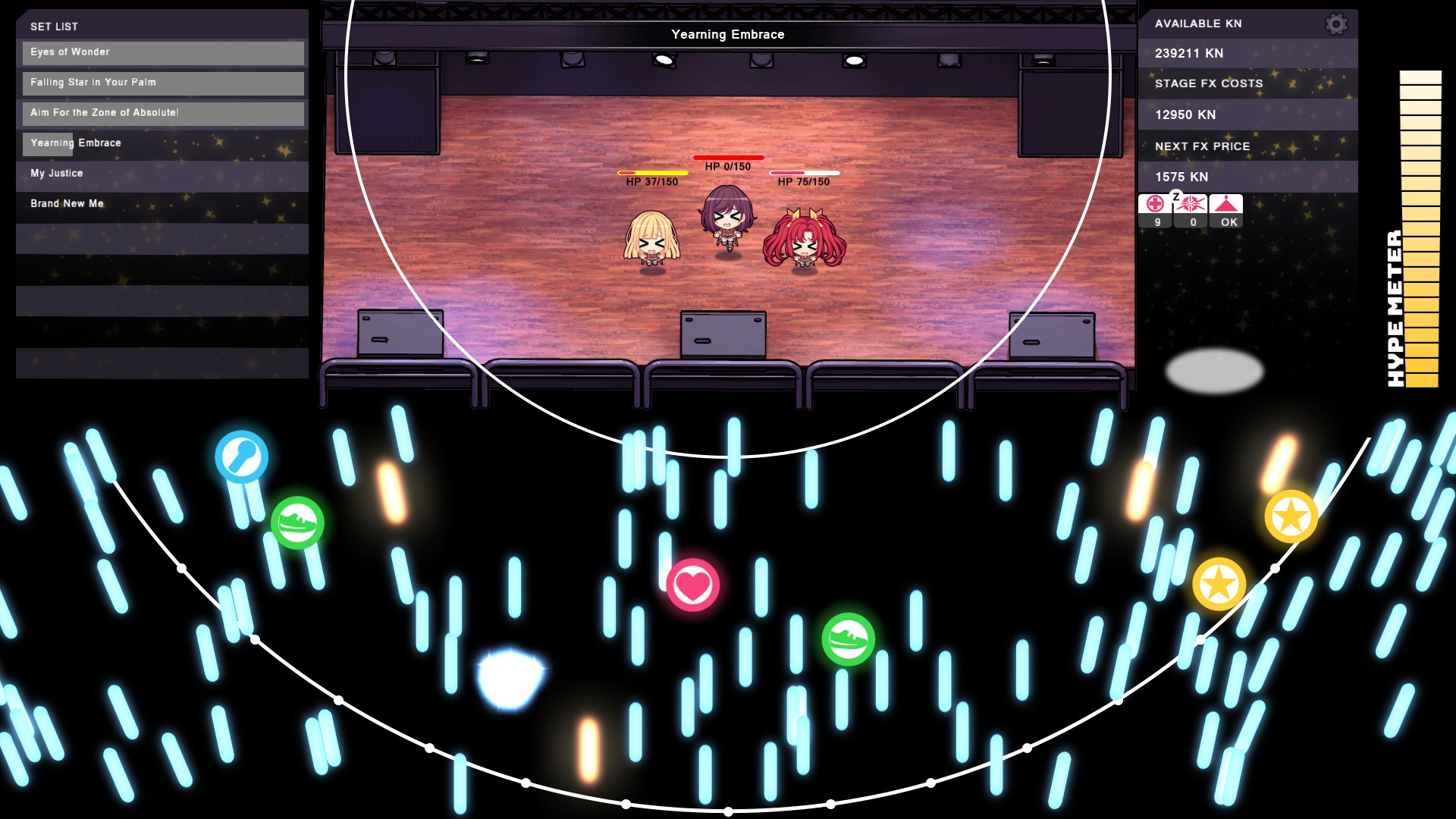
Somehow, in spite of basically failing my whole way through this, I managed to get a “perfect” rating on all my songs (in fact, I’ve never seen it NOT give a perfect rating for a song, no matter how hard the idols failed), so I’m really, REALLY confused as to what the hell this game wants from me.
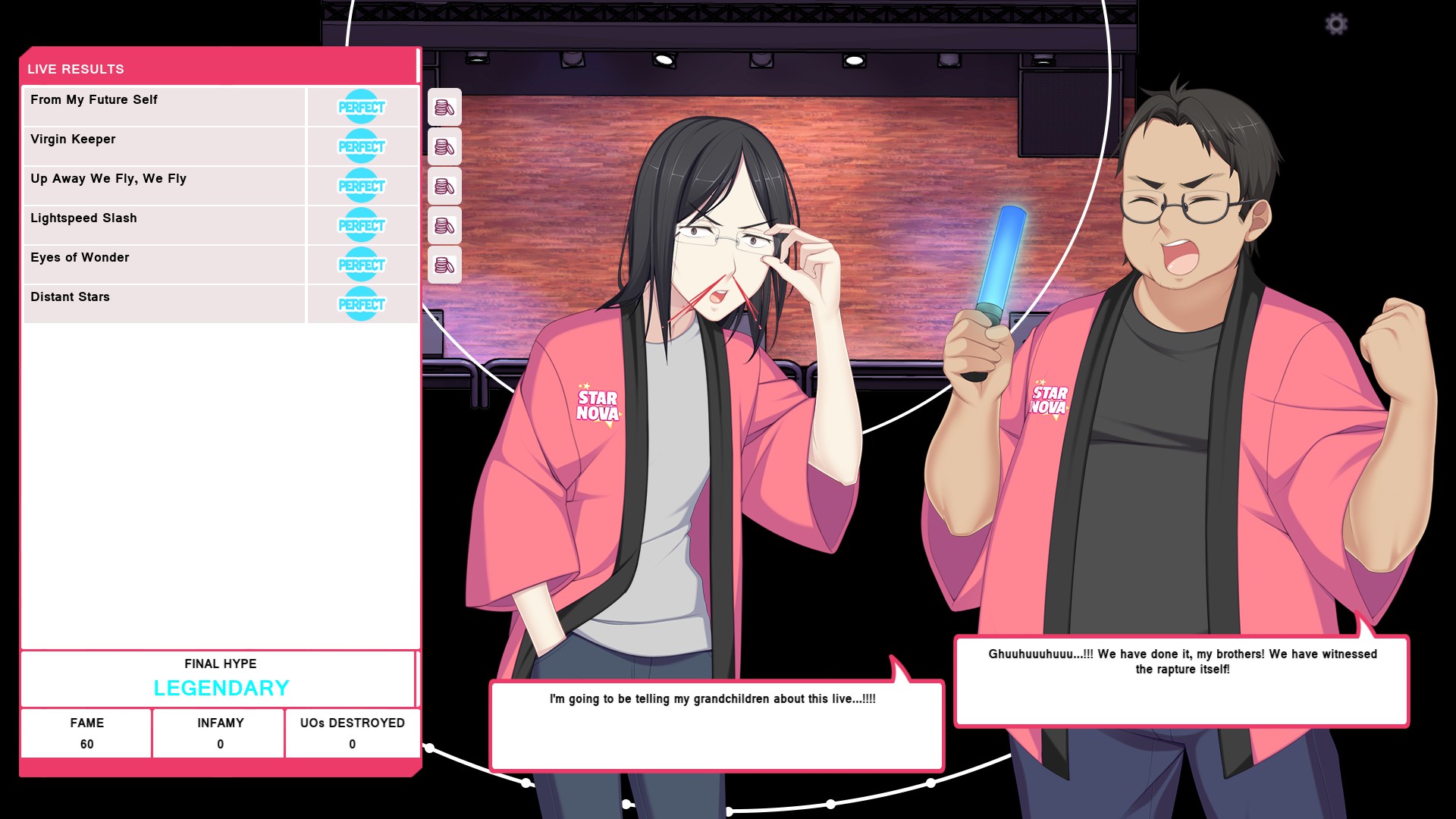
In spite of this, a review of finances shows that concerts cost much more money than they bring in unless you’re selling out the largest possible stadiums. This is because the stage effects you fire off if you don’t want your idols to die cost the same amount no matter the size of the venue, while the rewards for a venue scale based upon size. A tiny concert hall that only seats 200 people might only make you a few hundred KN in ticket sales, while the stage effects cost you tens of thousands of KN. A baseball stadium will get you hundreds of thousands of KN in ticket sales if your idols are famous enough to fill them, while the stage effects cost you tens of thousands of KN. By the time you can do that, however, you make far more money on the event room which is vastly easier to pull off.
There’s also such a thing as a “Guerilla Live”, which is a concert held with less advance notice and less time to sell tickets. Since these can only be done on the smallest venues that are basically guaranteed to lose you money, the benefits of doing so are absolutely none.
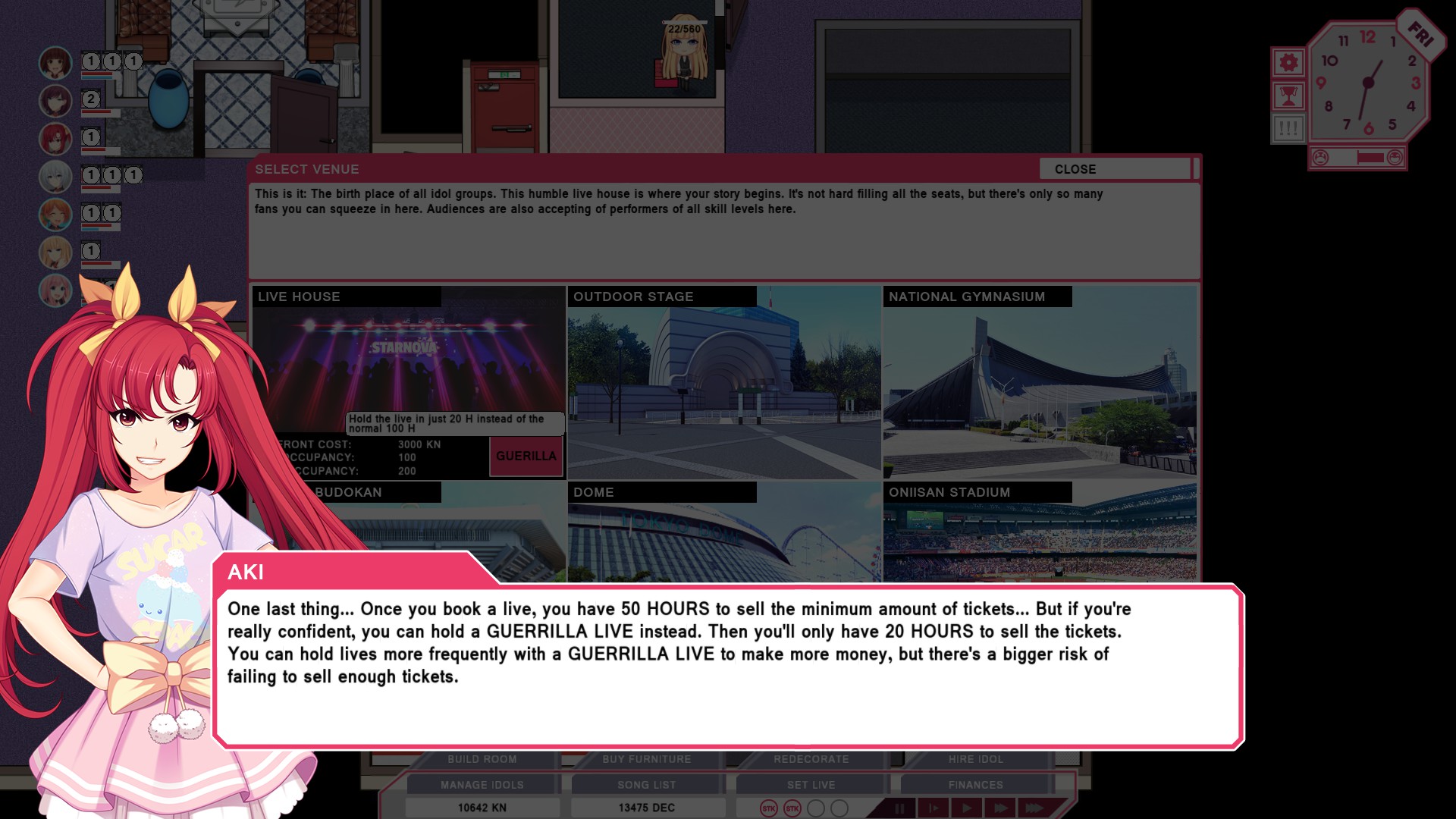
You also get fame from having high-hype concerts, but fame is a double-edged sword that can get you more money, but also more scandals that give you headaches and cost you money at the same time. Also, by the time you can perform a concert worth the time and effort to set it up, you can perform jobs and songs that make you vastly more fame for the time and effort put into them.
One hypothetical way to make more money is to have so much Hype meter that fans break their glowsticks and buy more. The problem is, this gives you trivial amounts of money compared to what you’re getting from tickets and spending on stage effects to get far enough into a concert that they do this. In essence, it’s not worth bothering to trigger this when you avoid spending money by having shorter concerts that make money in ticket sales, instead.
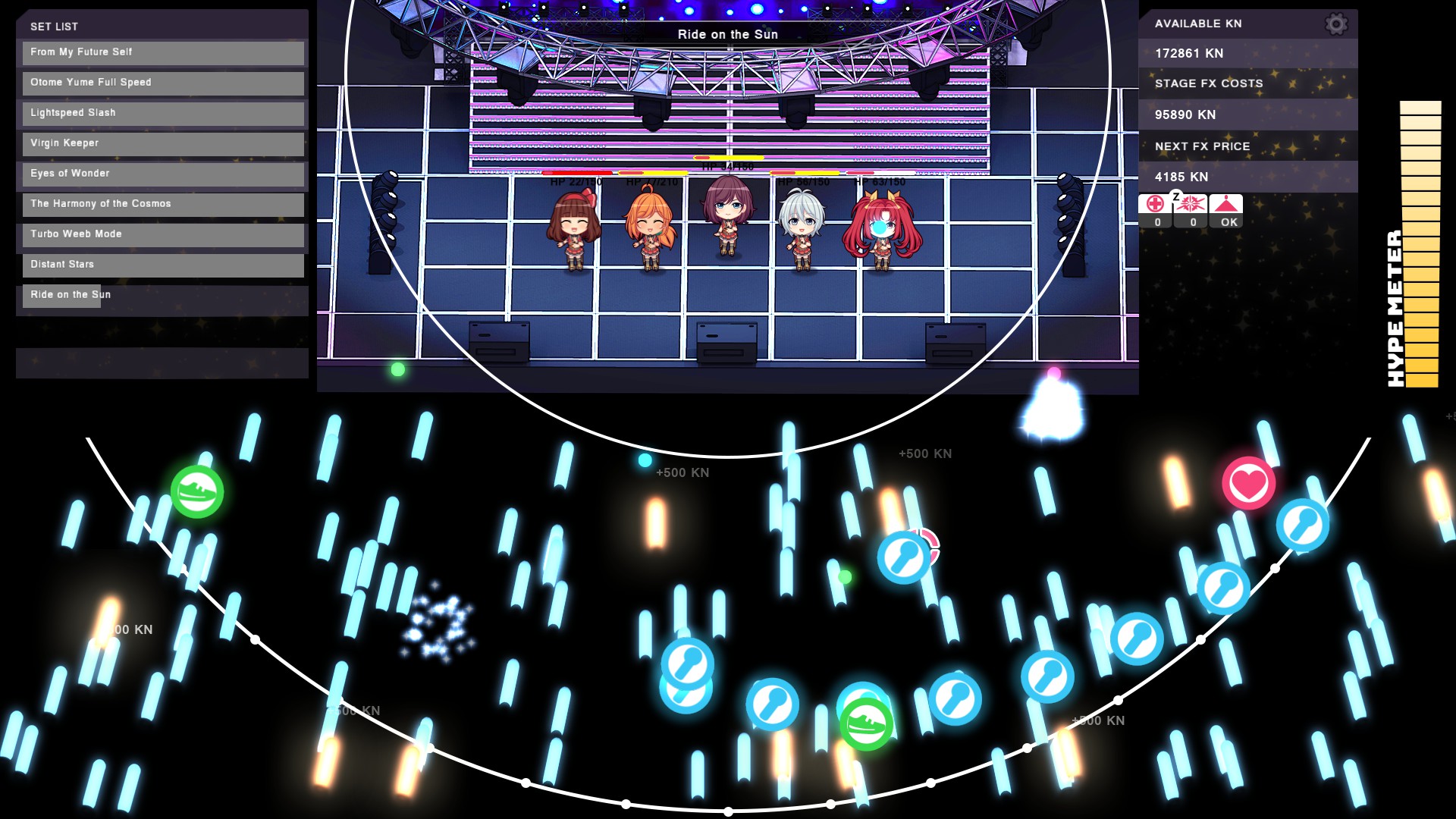
In summary, concerts are a massive waste of the player’s time and energy, generally wind up costing you more money than you make, and are best played by failing on purpose. The only good thing about concerts is that you can generally skip them entirely, outside of the Quasar battle mode and some plot missions, which don’t even require you to be very good at them.
The game talks about concerts as being a way to make money, which honestly makes me wonder if anyone on the team tested the game and actually followed the income and outflow of money to see whether this was actually true, because it’s quite clearly not the case that concerts make money when you look at all the expenses associated with them. That said, it’s so hard to track down all your expenses that I think not even the developer understands their own game mechanics, and that’s why it’s so badly balanced.
It kind of makes a mockery of what an idol career is supposed to be about if you never perform the single thing idols are most known for, but skip straight to the handshake events anyway, but hey, being unable to communicate anything clearly or effectively might as well be “Love UnclearCommunication Space”‘s middle name, anyway!
A Tutorial Tutorial
Dear developers, if you ever feel the need to go onto your forums and tell players that they aren’t playing the game in the proper order to get to the tutorial, the problem isn’t your players, it’s your tutorial. (Likewise, if you feel the need to use the random “tips” at the main menu as the game loads or a stickied forum post as the only way to learn about certain controls because your tutorial or interface don’t cover it.)
Love in Space set up their first few story missions to be the tutorial to the game, although there were several different game modes, including a custom office mode available from the main menu that lets you have infinite money to build whatever office you wish. Naturally, I played around in this mode first, since it was a no-pressure sandbox environment.
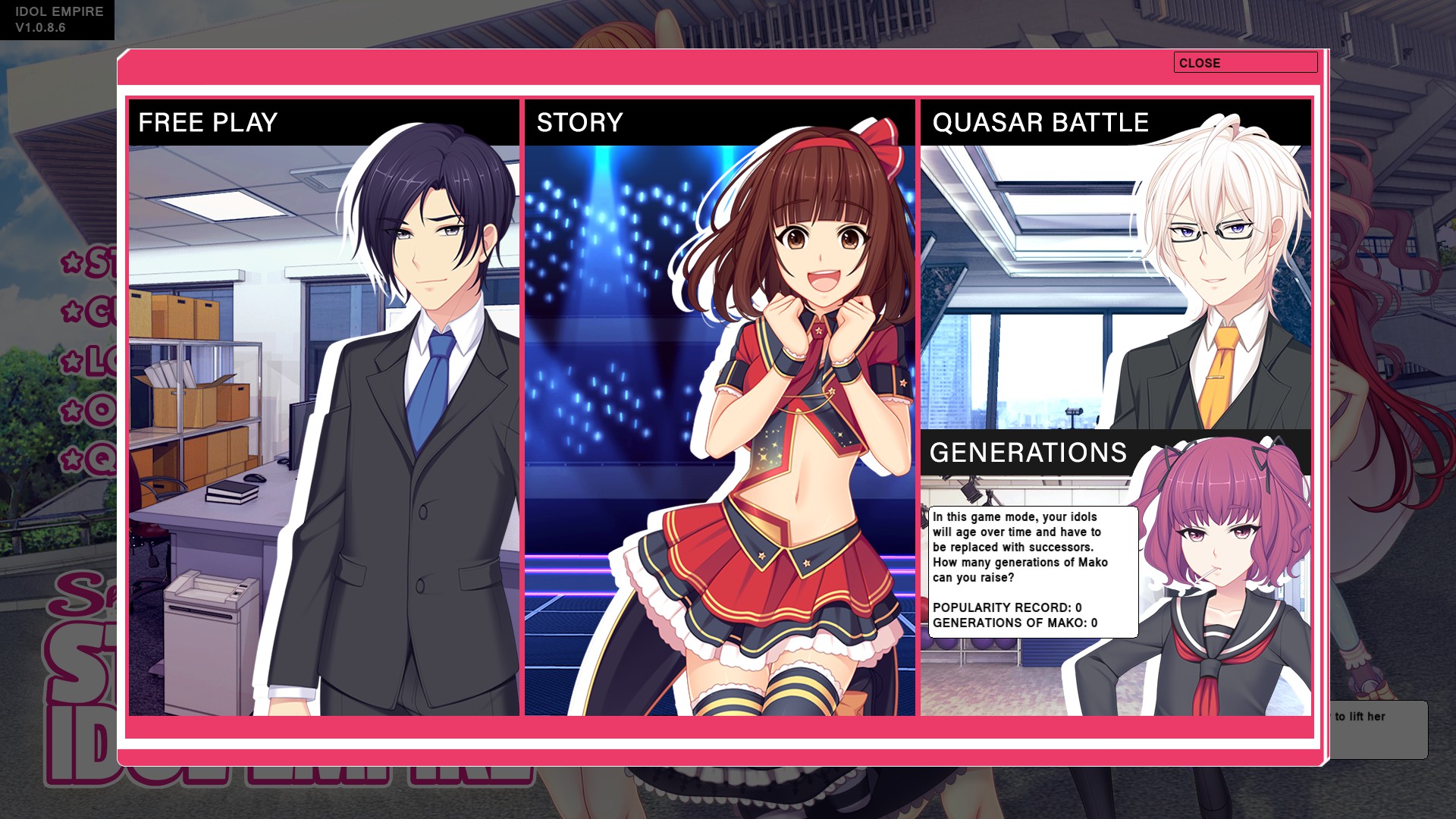
Likewise, there are many unlocks in the game that have extremely powerful and valuable effects, while each character has powerful center abilities that unlock as you gain experience by playing that carries over through any missions you go through. This gives you a powerful incentive to stick with a single office for a long time, grinding up the stats necessary for unlocking many of these abilities. (The fact that they give extremely obtuse hints as to how to achieve these achievements further compounds this problem by making players have to try laundry lists of possible meanings of the words Lost in Space used to try to intuit their alien thought process.)
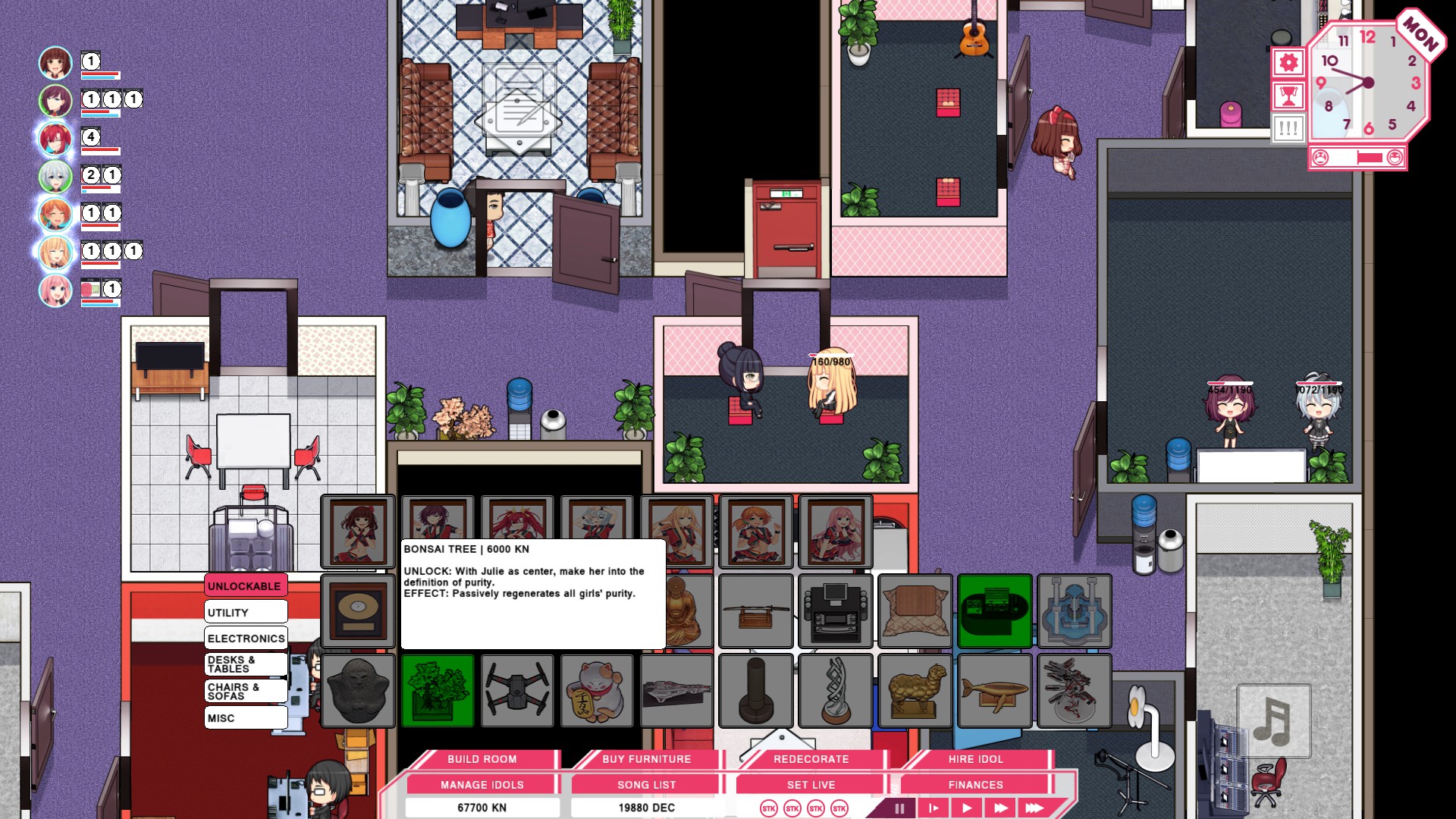
In essence, this is a great game for having a tutorial that explains individual functions of the interface as you open each one up for the first time. You don’t need a tutorial telling people how to do things where there’s a button on a menu that has a tooltip describing its function and what hotkey is its shortcut. You can give a quick overview, instead, or even have a “Civpedia”-style hyperlinked manual accessible from the interface so that players can learn at their own pace.
Instead, they went with making the first quarter of the Story Mode be tutorial missions.
This is a problem in that, again, it’s basically asking players not to play the game as they see fit and there are incentives not to just plow through missions as quickly as possible.
The most obviously terrible choice in this regard is setting up the “schedule training” tutorial as the third story mission. Basically, scheduling training is the second thing you do in a given game after building your first few rooms and adding furniture to make them functional. By the time I got to this third story mission, I had already spent 20 hours playing the game, myself. This is like being told what the attack button is in an RPG at the start of the third dungeon, there’s absolutely no way you could have gotten that far (besides just skipping straight to mission 3 since the first 7 start unlocked, but who would do that?) without having already figured this stuff out.
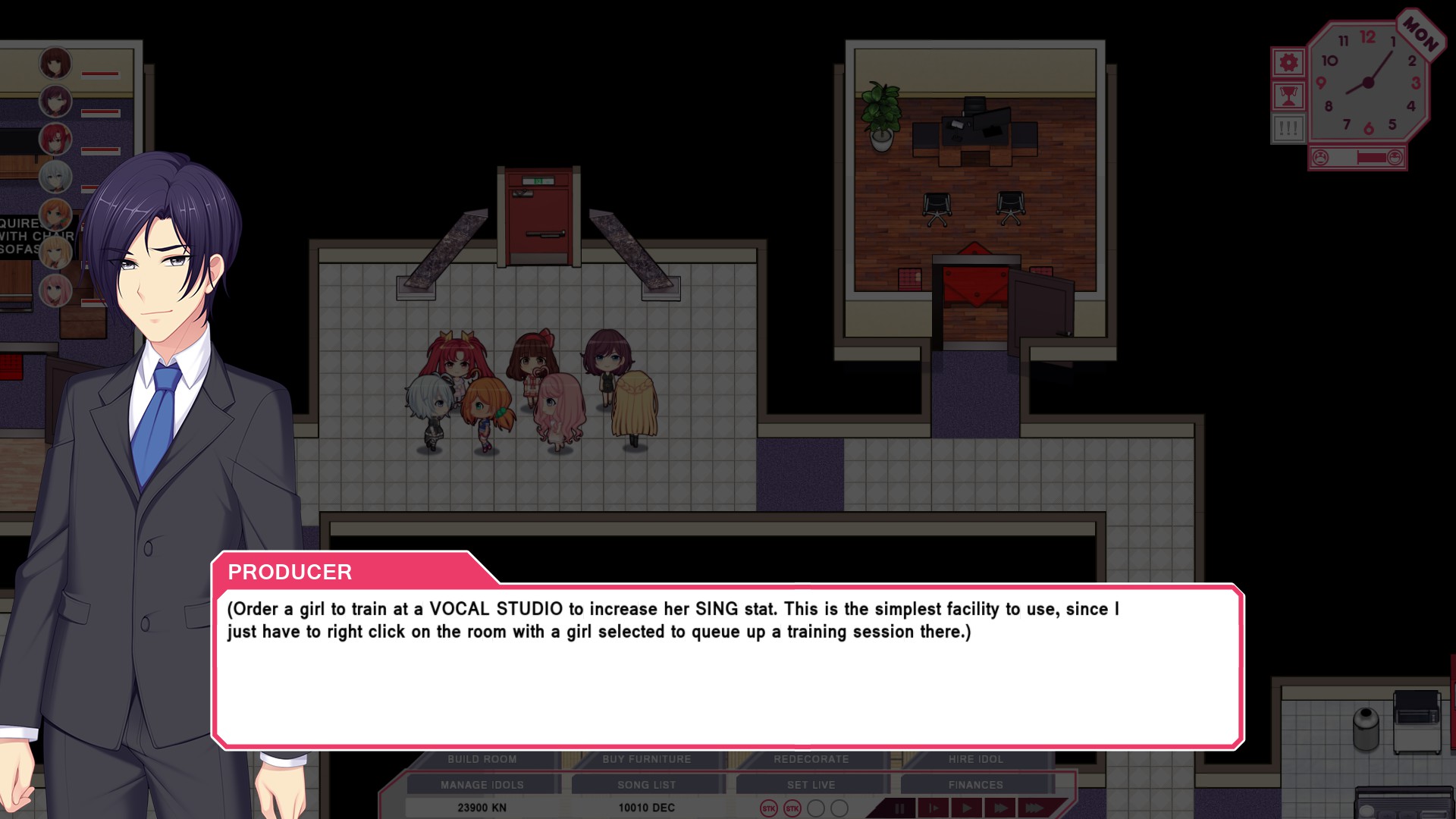
Love in Space is also absolutely allergic to telling you what the requirements for anything are. This is especially true of the unlocks, which the developer is deliberately, pointlessly vague about, but even basic mission objectives are not explained to you. In order to complete mission 4 (still part of the tutorial missions, mind you, so it’s where they still expect you to be unfamiliar with the game), for example, you need to successfully have a “Legendary” concert. What’s that, and how many ranks are there? WHO KNOWS?! You just have to throw a concert, and hope for the best. Many jobs have requirements of “high personality”, but no explanation of what that might mean. (Hint: It’s somewhere around 25 to 30, while the best character you start with has only 18 until you start training.) Some jobs say they require a “platinum idol”. What does that mean? It’s never explained at all!
There’s also a very confusing use of terminology in the game. One major element of gameplay is that jobs that are offered to your idols have nothing to do with their abilities or their fame, but the decorations in “your office”. The first thing you do in each mission is set up the “producer’s office”. You are the producer, so naturally, “your office” and the “producer’s office” are the same thing, right? WRONG! “Your office” means “the entire map”. Hence, when they say that adding furniture to “your office” increases the decoration rating of the office, it doesn’t mean it has to be in the producer’s office, it can be anywhere, even in a space that is inaccessible because you walled it off when making rooms. Likewise, there’s a counter on the bottom of the screen showing how much DEC you have, the fact that this refers to your “decoration rating” is never explicitly stated. (People in the forums thought it was referring to “December”, for example, because nothing in the game mentions that there’s an interface element that tells you what your decoration rating is.)
Likewise, many important functions of the game don’t seem to be explained at all. Concerts constantly drain HP from the girls, and you get to stockpile up to 9 healing canisters at the lab room to restore their HP, along with one special stage effect that clears the screen of attacking circles… but there are no instructions on their use. There’s a helpful icon saying “Z” next to the special stage effect that informs you how to use the stage effect, but there is no clue as to how you use the healing canisters. (You have to click on the character. I had to learn this in the forums. Nothing in the game mentions this, and again, this is the game mode where you have the least time to bother looking at the interface so it needs to be the most clear.)
Overall gameplay
Past all the rest of it… it’s essentially another basic tycoon game, with all its features and flaws.
At best, it’s something you can stare at and waste time just keeping the ship sailing forward, grinding progress on bars.
That said, it also has all the problems inherent in the genre, which is that because your only real lose condition is running out of money, as soon as you survive the earliest parts of the game, there’s basically no reason for you to ever lose. If you started making money, you practically have to go out of your way to self-destruct to start losing money. The longer you go, the more your characters’ stats are trained, the less likely they are to fail things unless you try to expand too quickly.
There is a way to lose after making some money, but it basically requires you seriously mismanage something to kick off a death spiral.
A major thing that can cost you money is a “Fanquake”, for example, which is generally caused by having stalkers get to your girls or having lots of scandals. Stalkers and scandals are caused by having high infamy and low pure. Infamy gets higher and pure gets lower by having scandals.
You can see why this creates a problem with how the difficulty works, right? You either have no scandals for a long time because you have max pure and low infamy, or you get hit with a scandal, choose not to apologize, lose pure and raise infamy, and then get hit with another scandal almost immediately afterwards. In fact, I’ve had three scandals hit me in the span of honestly just a few seconds of real time between them after having gone ten minutes without a single scandal. It creates an insane swinginess of harshness in the difficulty in the game.
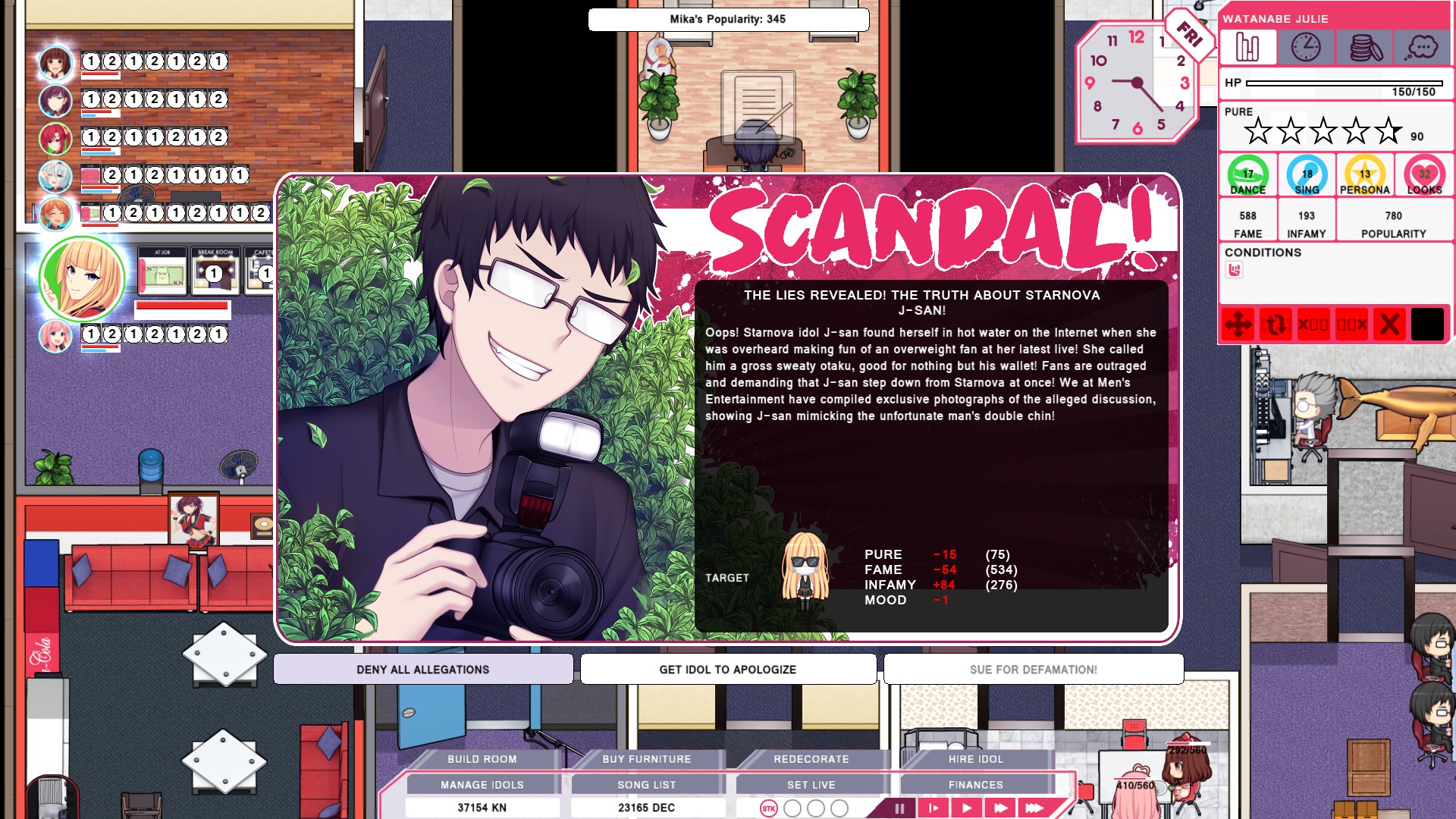
It’s also an indirect dig at the fans of idol culture, if Love in Space was self-aware enough of their own themes to notice; Fans blame idols for the bad behavior of the other fans, causing them to behave badly, making them blame the idols even more for their own behavior.
By-and-large, however, this means that the game past the earliest part consists of simply sitting on your horde of knots getting more knots until random things come along and make you click to make them go away. The game is made even easier when you get certain unlocks that mitigate or outright eliminate many of the most serious problems you could face. One unlock makes you immune to fanquakes, and several eliminate the conditions like Nemu’s psycho killer sprees that make keeping her mood high a top priority. It’s little wonder there’s a focus upon missions resetting you to the start. Two of the game modes are basically there to make the game continue having difficulty – the Quasar battle basically demands you scale up training infinitely to stay ahead of the Quasar girls, while the generations mode simply makes your characters reset their stats from time to time so you have to train them again.
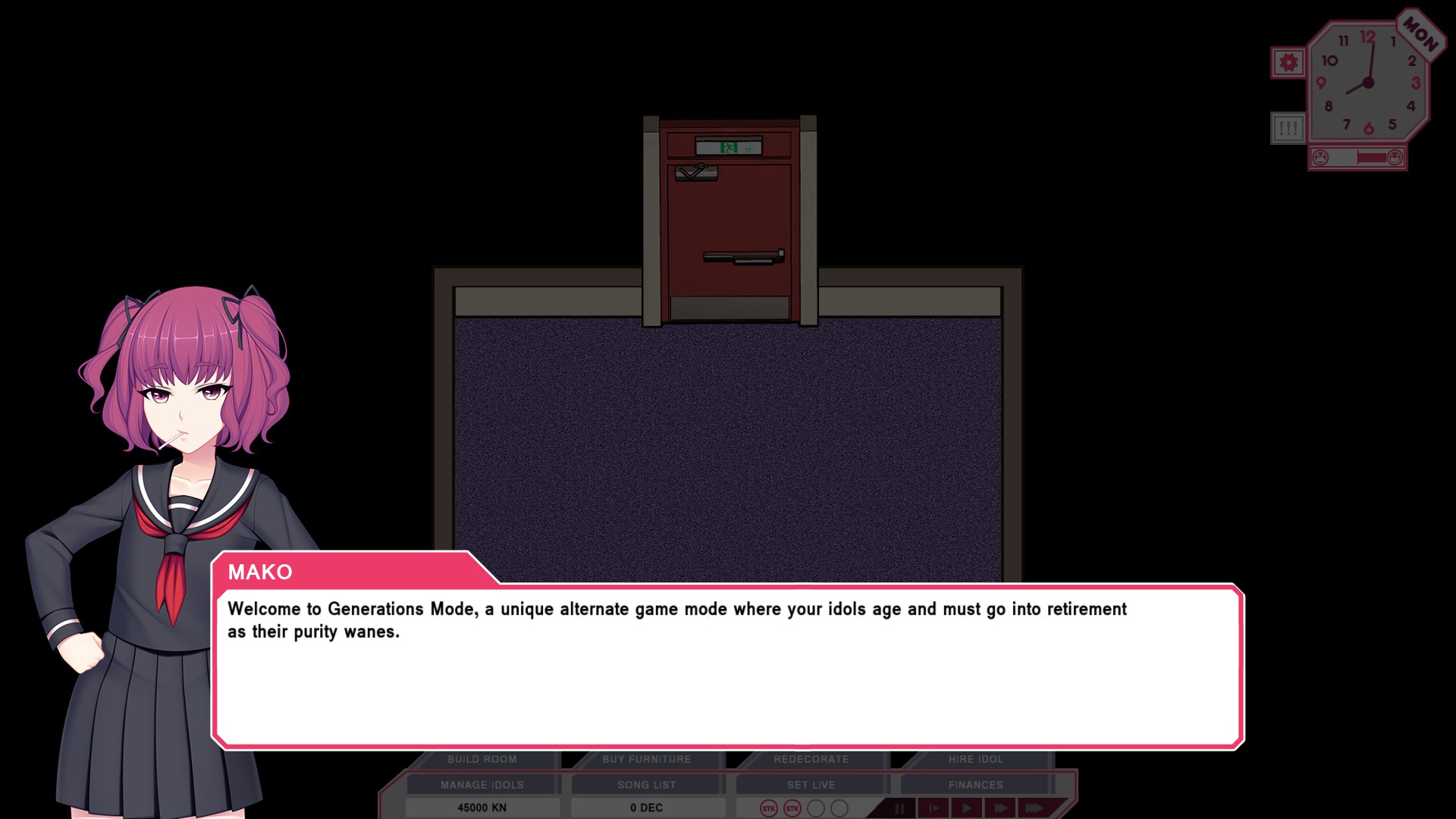
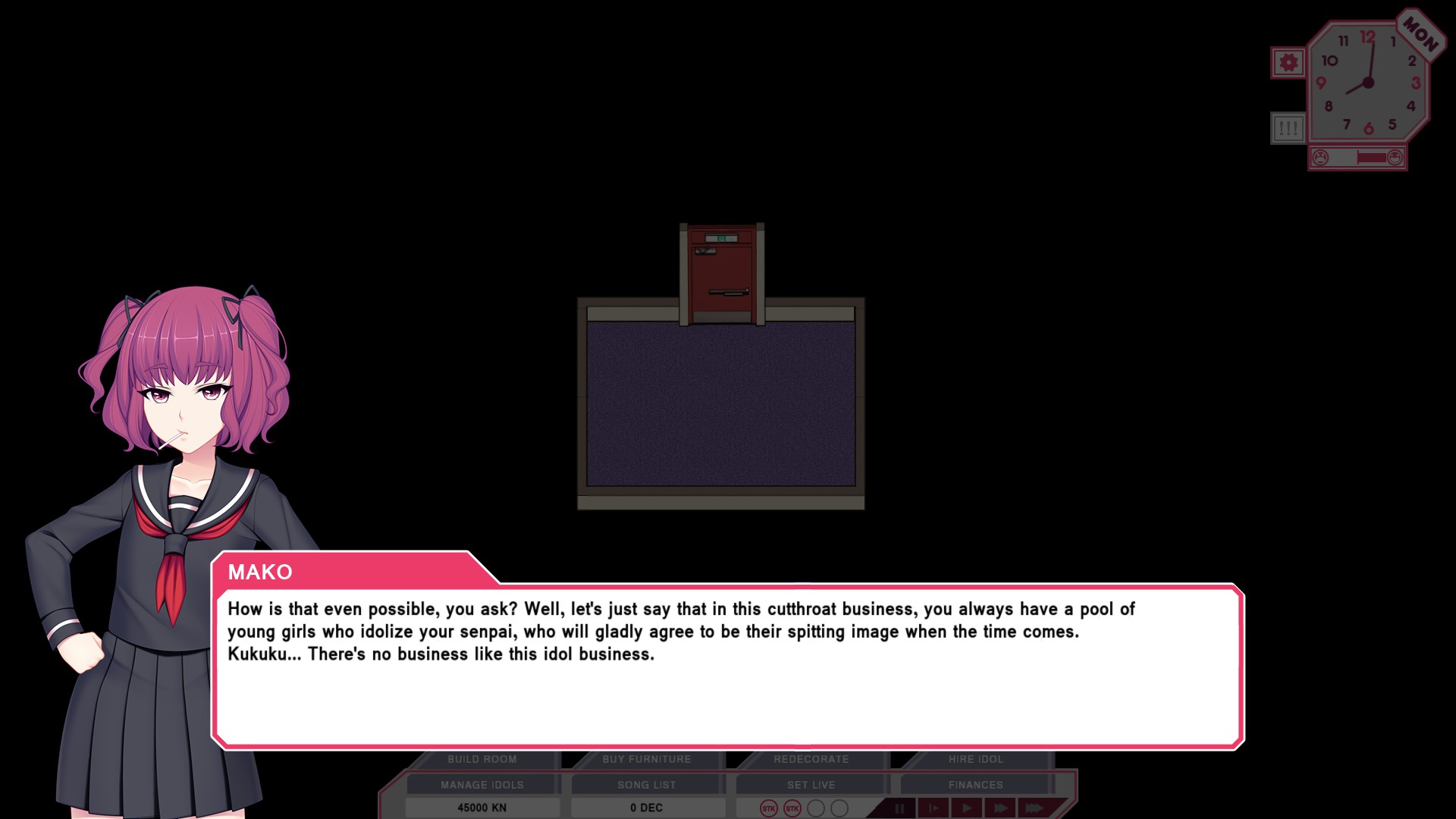
Another thing of note is that you have to unlock different “tiers” of rooms for… some reason. I guess because Starcraft did it? I don’t know, but anyway, there’s a progress bar to unlock it, and you somehow need to “research” the same things every mission. After you get to the third (and highest) tier, you can also upgrade individual rooms so that they “double efficiency” (read: you gain two stat points instead of one when gaining a level, which is actually slightly better than double because the experience requirement increases every time you level up a stat), although there’s a larger cash outlay for that.
What’s notable is that your defenses against the random bad stuff are tied to tiers, so things like stalkers actually do not start happening until after you have unlocked Tier 2, because you’d basically be unable to do anything about stalkers until after unlocking the Tier 2, then building a security room, then having them charge up their arrest bar, anyway.
However, this also means that just staying at Tier 1 until you have secured yourself a fat wad of insulating cash is the best strategy so that you can buy up a lot of necessary buildings and start unlocking Tier 3 to get to the lawyer immediately. Again, the basic nature of a tycoon game like this just pushes the game towards being a game where multiple missions push you to clear them as fast as possible just to save time, while the game’s mechanics reward being as slow and deliberate as possible to avoid risk. Essentially, the only real in-game choice of any consequence is whether you will prioritize your in-game goal of not losing against your out-of-game boredom.
Unlocks
This is another one of those games that doesn’t understand what things like achievements are meant to do for sandbox games. Games like Crusader Kings II or Minecraft after Microsoft took over, for example, are open sandboxes that set out achievements because the gameplay is unfocused and free-form, but by adding a tiny metagame reward to some specific actions, they can encourage players to try experimenting in ways they would otherwise not consider doing things. Minecraft has an achievement for jumping off a cliff with a pig, encouraging players to saddle up a pig. Crusader Kings II has a host of objectives ranging from systems mastery objectives, like “Empressive”, having three successive generations of empresses in a time of chauvanism that makes getting a woman on the throne and keeping her there is quite difficult, to “story” objectives that represent ways to encourage playing specific kinds of cultures towards their natural goals, such as playing as a Jewish lord, retaking the Kingdom of Israel, and rebuilding the Temple of Solomon.
What those games have in common is that they recognize that if you’re going to set a goal for someone to encourage specific play behaviors or strategies is that you have to tell players what they’re supposed to do. Instead, Love in Space tries to play coy and gives only vague hints what you’re supposed to do for certain characters to get their unlocks. Making this worse, several of these rely upon having specific characters in the center when specific random decisions pop up (which do so without warning), which players can’t even know exist without seeing happen once or looking through the translation files to read through what they all might be.
Eventually, this will likely be the sort of thing that makes up a walkthrough that tells players how to do these things (if there are enough players of this game for one of them to get aruond to making it), but all that does is make it a game that has explicit instructions that you have to go outside the game to get. Call me old-fashioned, but like with understanding the basics of the plot, shouldn’t the game be able to handle these basic things on its own without having to rely upon the players rescuing it in the forums?
Graphics
Although the anime art style aren’t for everyone, I think it’s pretty safe to say anyone who’d even look at this game is going to be fine with those. Graphics are generally fine, although I think the chibi characters on the map should have had more facial expressions to convey the things they are saying or their current mood while the character looks at them. As it stands, they will always be smiling on the map when taking specific actions even while angrily cursing at you.
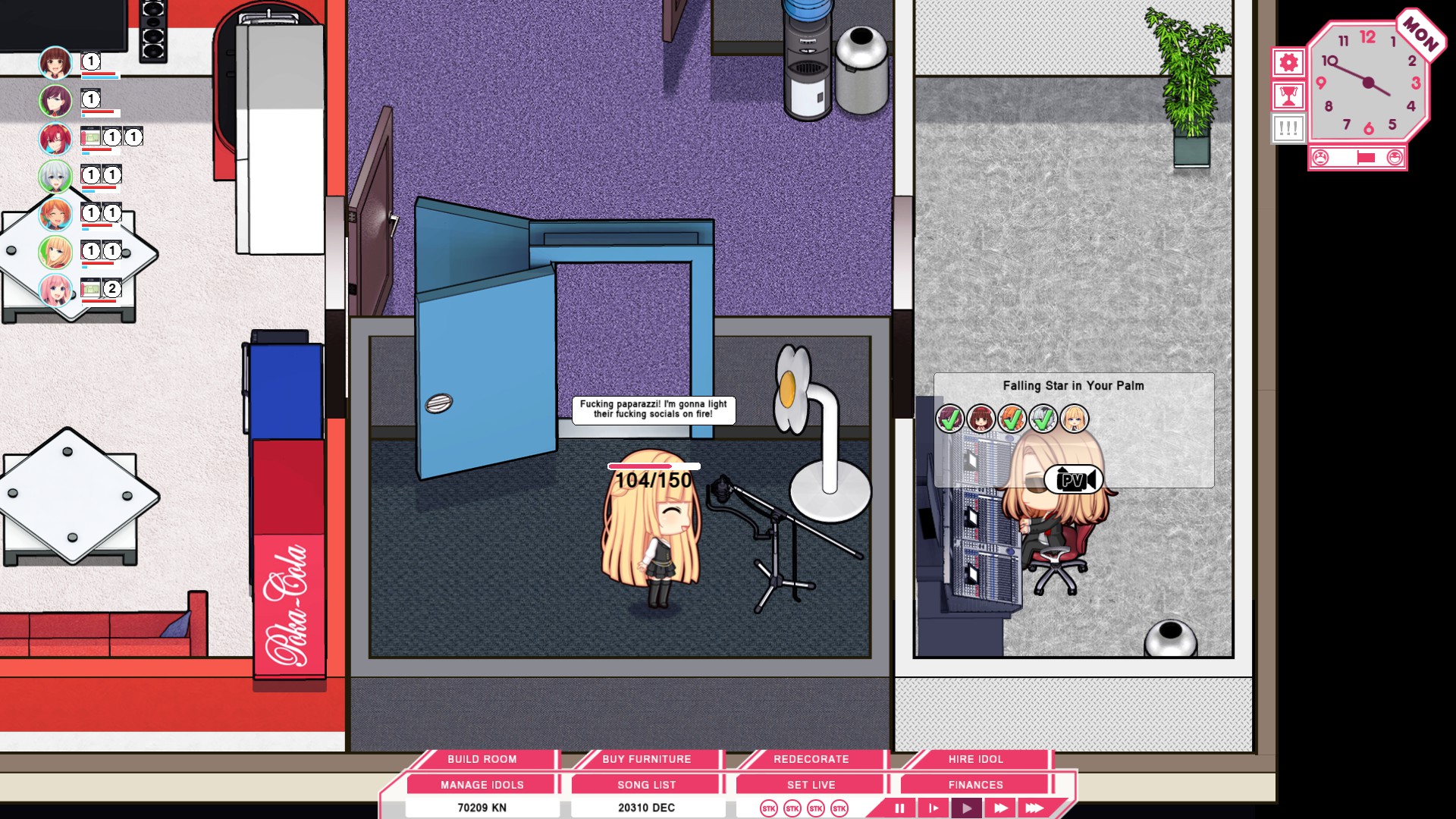
Likewise, when there is a plot sequence at the start of a mission, the characters all just line up in formation and smile vapidly at the camera while their portraits pop up to actually show the emotion. If they’re going to show the characters on the map at all, they could do at least the bare minimum of making the characters face each other or look like they were talking, much less put in the relatively mild extra effort to have changing faces on the bobblehead characters.
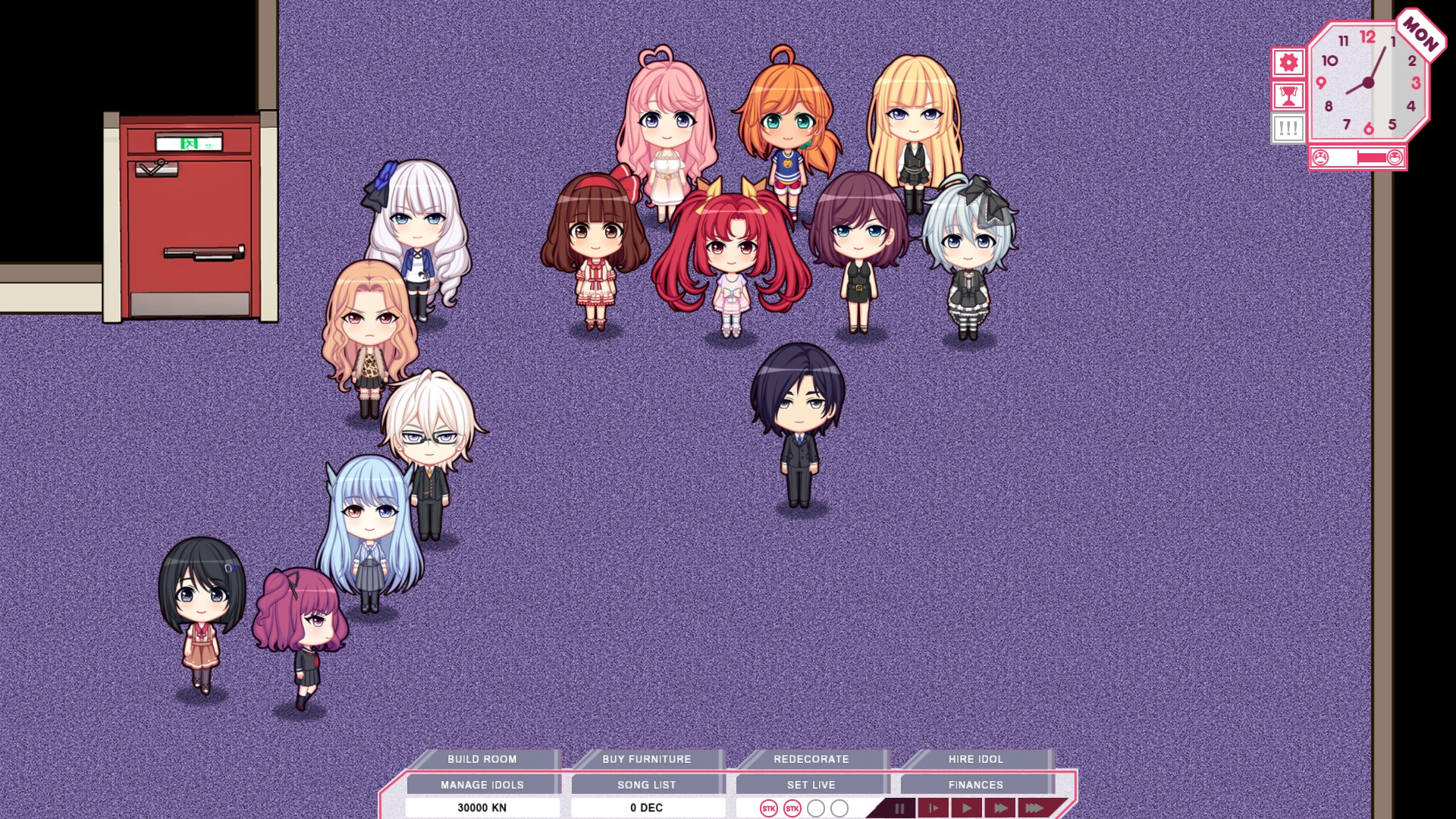
I’ve already touched on this in the interface section, but Love in Space didn’t bother to make small-sized icons for any of the interface elements that are displayed as small icons. In addition to the tasks/room icons shown in the queue, this is also a problem for the characters. This means that character heads in icons are often blurry and indistinct, although it’s oddly the case that some are sharper than others. You really can’t tell one character from another in icons without judging by hair color, and Sasami, Mariya, and Mako all have similar hair color, making tiny icons like in the song list difficult to discern without squinting.
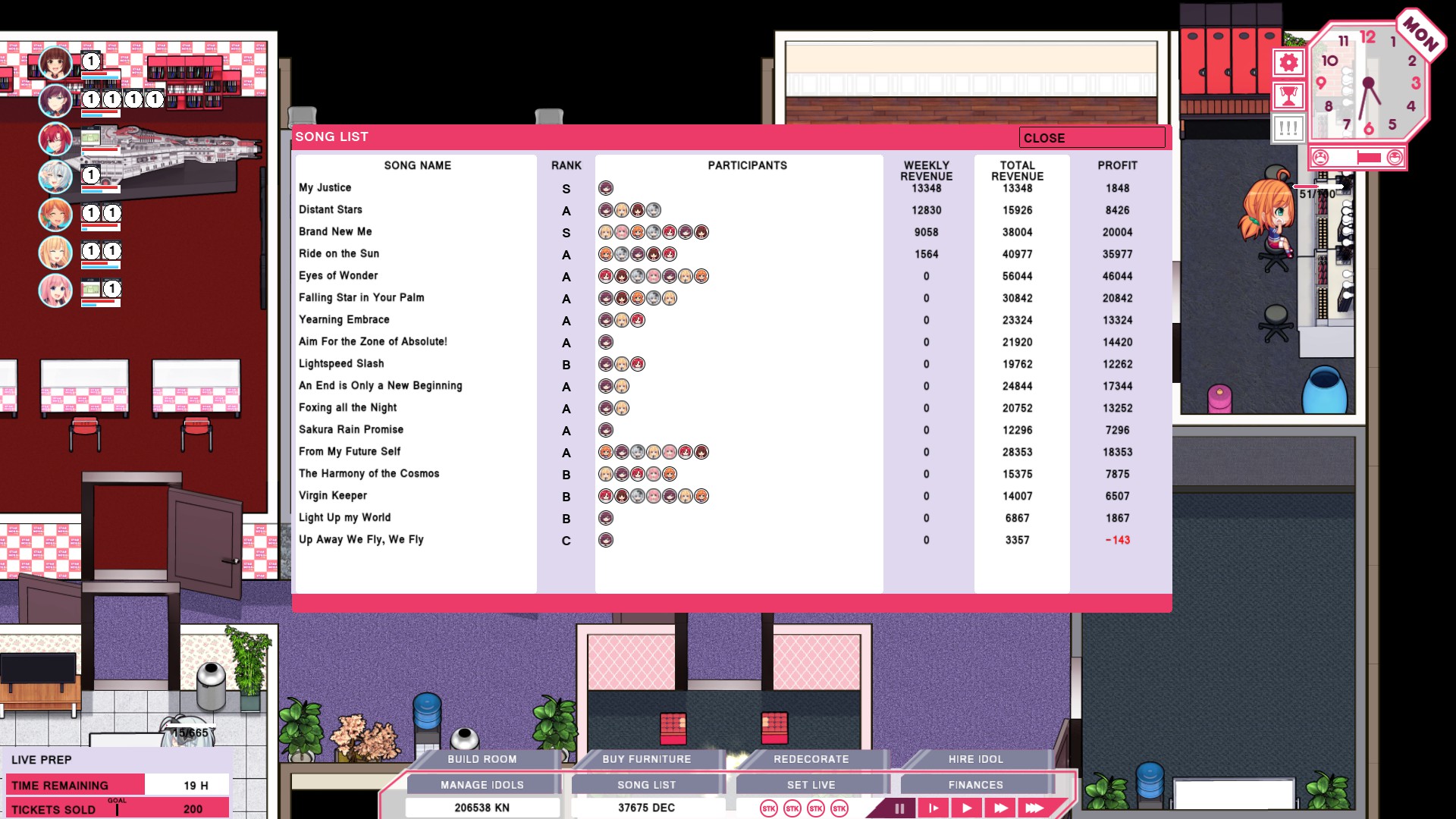
I could also just plain ask for more variety of different objects to decorate the office. By and large, it’s one of the better parts of the game to be able to just mess around with the office and it’s a little disappointing that there aren’t very many ways to make one office look different from the last one you played in, especially when the game seems to want to push you from one mission to the next so quickly.
That said, these are more problems of Love in Space’s management not asking the artist to do more sets of artwork to cover the needs of the game rather than the artwork being poor. By and large, the graphics are the strongest suit for the game. They’re goofy and cartoony, even if they don’t really match the tone the game maybe should have had, and they’re generally attractive. Especially compared to many western-made faux-anime games, the graphics are a standout. Hopefully, the artist will be hired by another developer that can design a game that makes good use of their talent.
Voice Acting
Apparently, a large portion of the budget went to getting actual Japanese people to voice the lines in this game. As with the artist mentioned above, they’re by-and-large too good for this game. The only one I found somewhat grating was Nemu’s voice actress who had a strange warbling/almost gargling sound in her voice.
Many of the things they actually say are dumb and trite (especially Julie, whose response to every request for training is a horrible “I’m not doing it for you” overused tsundere cliche EVERY. TIME. YOU. CLICK.), but they’re delivered with as much gusto as possible. (Julie’s voice actress rises above the material the writer gave her in this regard, using an odd mix of English cursing and Japanese sentences you generally don’t see pulled off so well even in actual full-budget animes.)
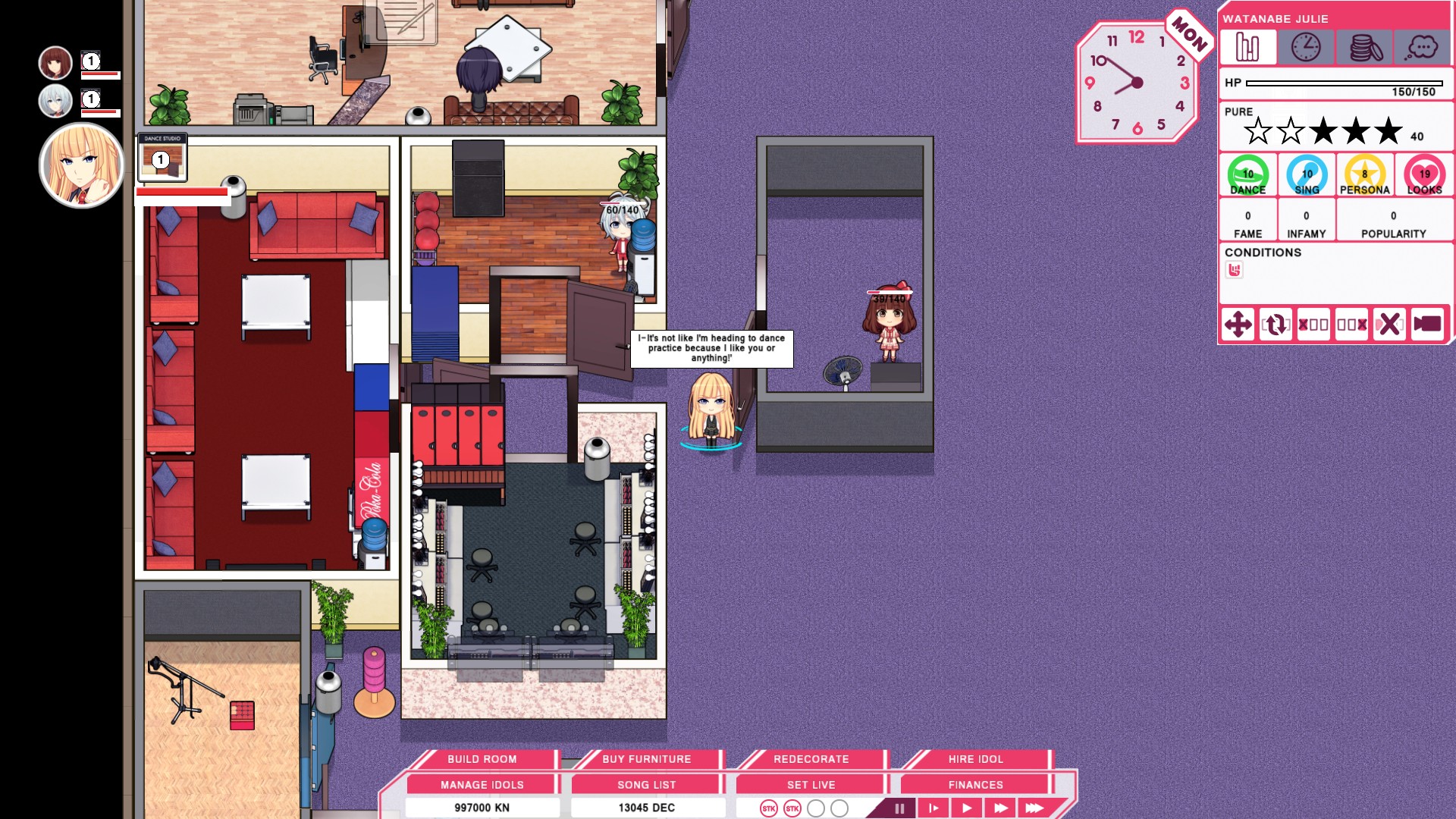
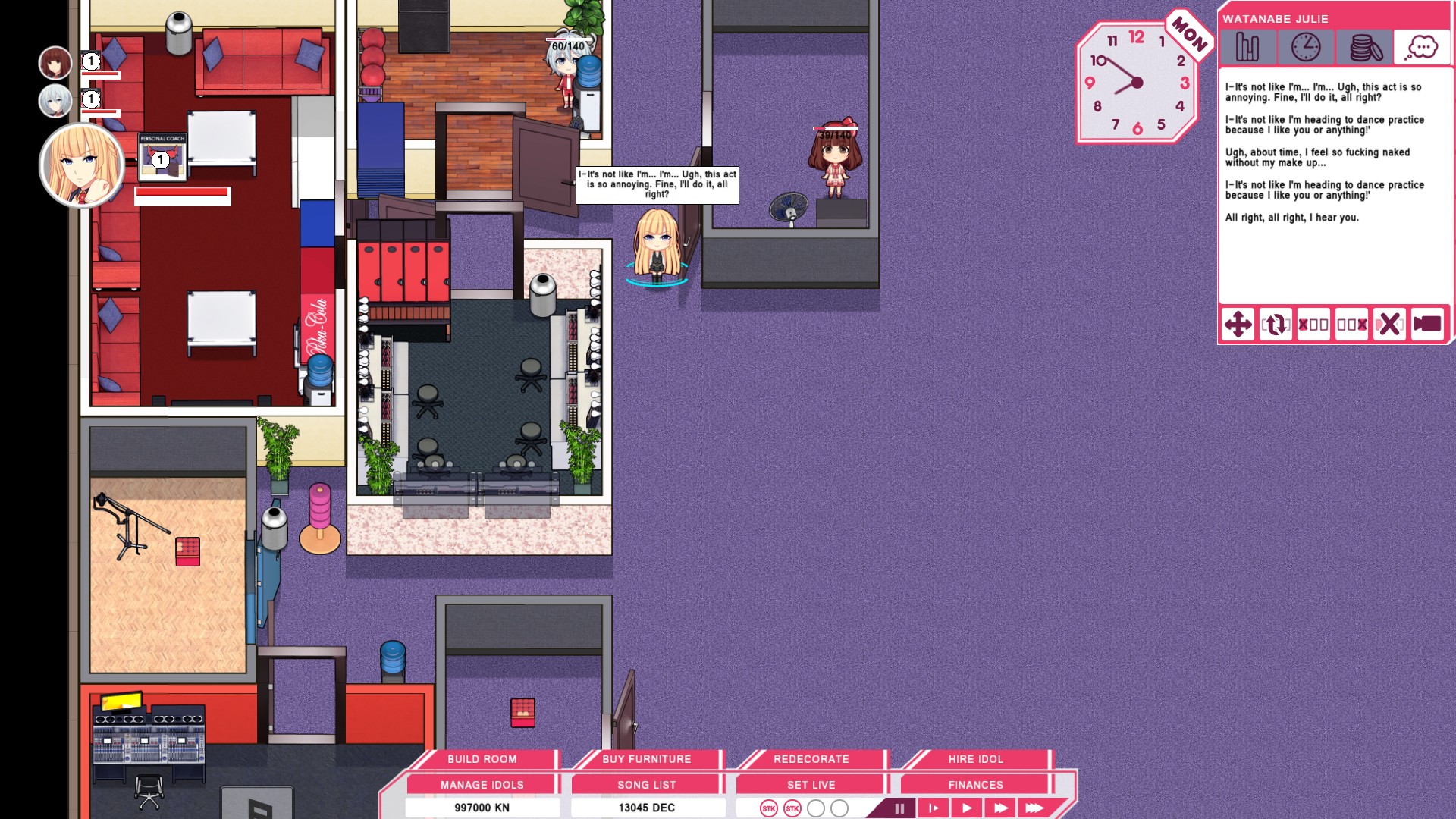
One major problem, however, is that Love in Space did absolutely nothing to stop multiple voices from talking over each other. This is especially problematic when you have something like a PV and several girls return at the same time. Every girl will come back and announce their return as a single ear-shattering noise blob as they all yell at the same time.
Sound Effects
I should also point out the exact same problem of having no idea how to manage multiple sounds playing at once also applies to sound effects. This is incredibly annoying with regards to the speed settings, because setting the game to “slow speed” makes a couple-second-long sound effect that plays a “slowing down” noise every time it is set to that slow speed – even when you are speeding up because the game was previously paused. Due to the lack of a dedicated proper pause button, you have to mash “O” several times to go past the “slow speed” setting to hit “pause”, which also has its own sound effect that plays at the same time as the slowing down sound effect if you punch them in rapid succession (you know, because you want to go from normal or high speed to paused), and then plays the sound effects all over when going back up in speed.
This is honestly half “more ways in which the interface design is a complete flaming dumpster fire”, but the complete lack of ability to design a game on a conceptual level spills out into ruining every part of the experience.
Music
For a game about characters that are at least on paper supposed to be musicians, the game is rather lacking in music. The main theme is well-composed and catchy, and an arrangement of it plays any time you use one of the “Nova” unique powers of an individual girl. I hope you love this song, because especially when you get a full roster of girls, this song is basically going to be playing non-stop as at least one girl will always be at or near nova level if you have the slightest clue what you’re doing. The song loops after about a minute or so, and you can play individual maps for dozens of hours, so good luck with that. The general office music when you for some reason forgot to let the girls nova is kind of generic and forgettable anyway, and even then, there’s only three or four tracks.
Additionally, when you have a concert, it only plays the main theme song continuously. There’s not even a break in the music between the songs the characters are supposedly playing on stage.
The art doesn’t quite have enough extra face animations to sell the game, but the music is just flat-out lacking, and it feels like some real corners were cut in this department.
Essentially, after the first hour, you should absolutely be playing your own music, here.
Bugs
For a while, I had no real issues other than the sound having gone out while playing a relatively long session. (Saving, quitting, and reloading fixed this.)
There were other minor bugs, involving mainly graphical priorities. Basically, placing furniture near walls or other furniture frequently has problems with determining which object should be in front of another – a potted plant inside a room placed near the wall will appear in front of the wall, apparently hovering outside in the hallway.
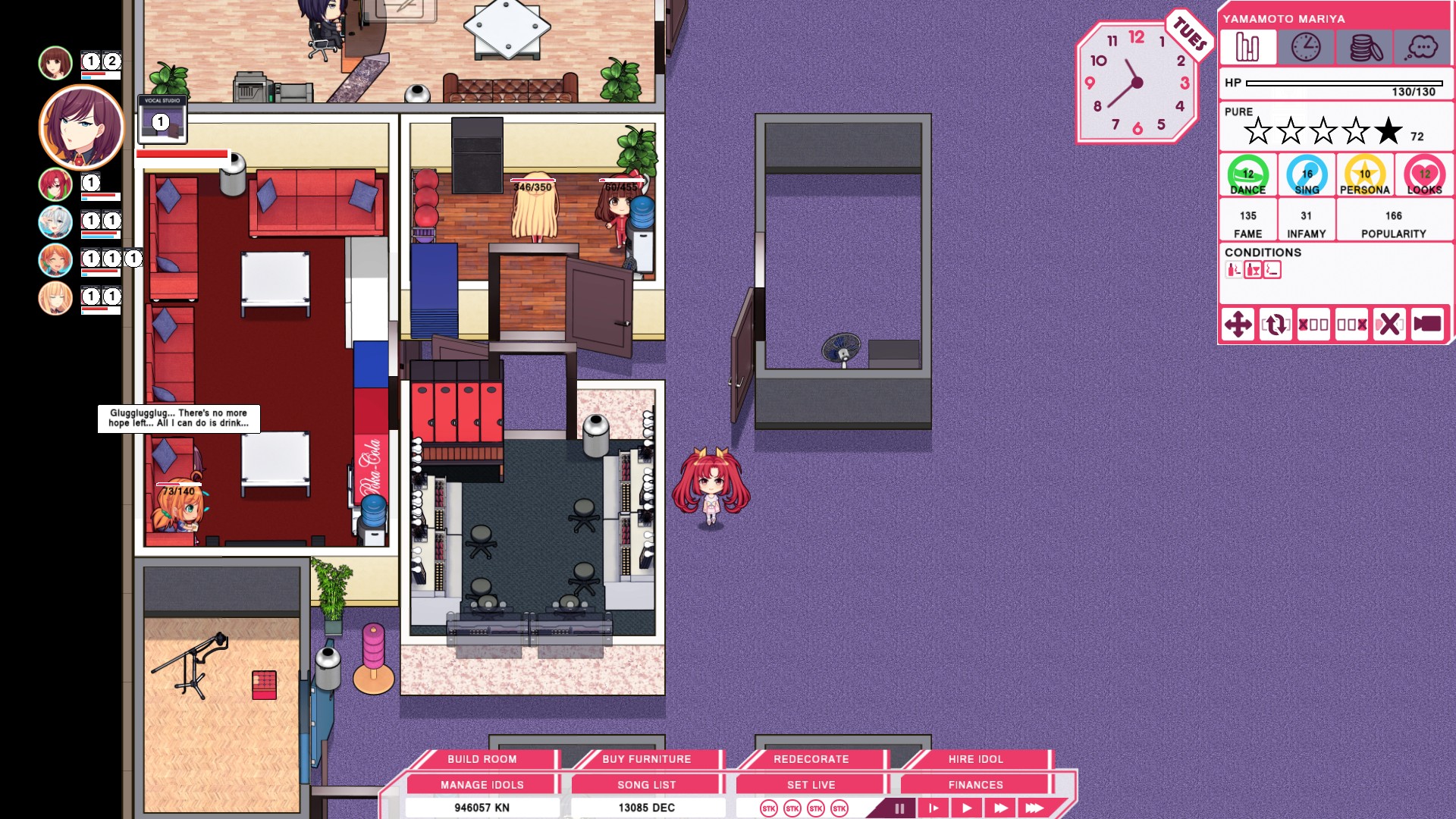
This also applies to pathfinding; Characters will walk through walls to get to places, or in other cases, they pathfind to a point below where the object is actually located, so having a potted plant next to a makeup vanity (below the vanity on the screen when the vanity faces towards the left) will cause the character to declare there is no path to it while standing right on top of it.
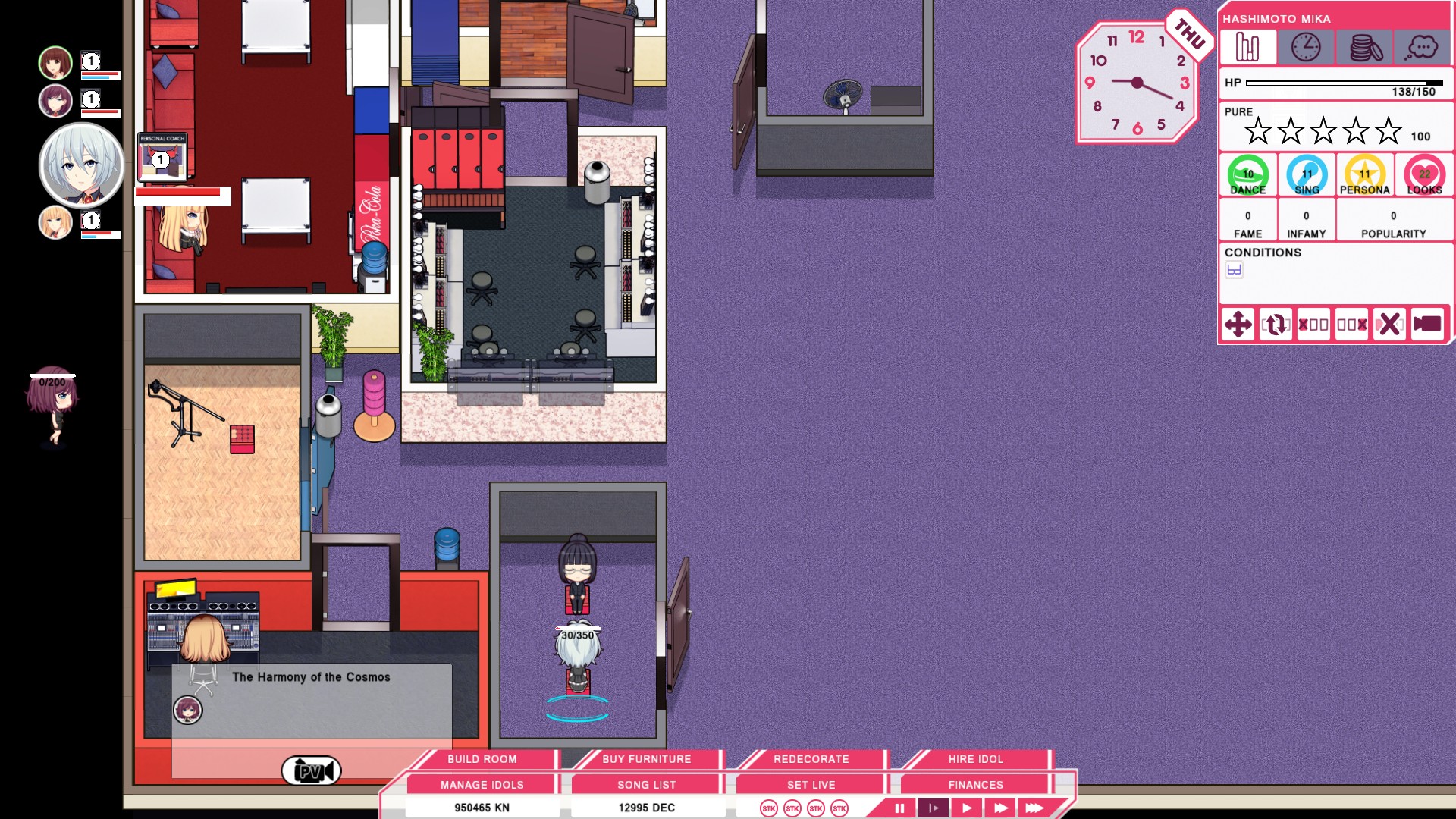
Some people had more serious bugs, including problems with idols disappearing permanently if they were sick during a concert, and there was an update mentioning that there was a failsafe added for save file corruption, but I didn’t experience those problems… at first.
Instead, I managed to get a crash that happened to corrupt the carry-over save data from unlocks. You see, putting a character as the Center (center stage/starring role) gives them center experience that carries over between missions, and therefore updates constantly. This was corrupted during crashes, wiping out my progress, including the record of all the missions I had completed.
Fortunately, however, Love in Space didn’t even bother to make the saves anything other than raw plaintext, so I could just write whatever values I want into the file once I found it. Hooray! Not bothering to have basic protections against cheating save the day!
Remember how there’s a limited number of fixed song titles because they were selected via submission of the crowdfunders as a pledge reward? Well, there’s also a bug that crashes the game if you have 150 songs recorded that crashes the game if you try to record another one. Since songs are a major way to increase fame to keep money flowing in, this basically torpedoes any attempt to play long-term games.
Verdict
Love in Space vaguely understands what a game and story are supposed to look like, but cannot for the life of it make any of the parts contribute to the greater whole. The story has a traditional upbeat overcoming adversity arc, but the story fails to make the villains do anything villainous while making the fans you’re supposed to be inspiring the actual villains. It wants to be a story about how idols achieve their dreams, and makes a game about how it crushes them. Idol Empire is a bright and cheerful cynical dystopia that is so unrelentingly incapable of self-reflection it didn’t even consider the possibility of trying to be some sort of parody.
I’m honestly torn on how to rate this game. I started with a “Pause” rating, but the more I write, the more I think it deserves a “Quit”. Putting the story aside, the game itself is salvagable as a run-of-the-mill tycoon game that has unusually good art and voicework if the interface was salvaged. This was originally just going to be a few facts and bullet points, but as soon as I started writing, the amount of text that came pouring out just started spiraling out of control, and the sheer volume of unforced errors this game commits should speak volumes to its quality.
What ultimately damns this game in my eyes is that it’s a hundred minor to moderate flaws outweighed by… nothing. There really isn’t anything good to outweigh the bad in this game (well, maybe the art), so the only thing I can talk about are the flaws, and I clearly have far, far more material than I can even fit into a review there.

